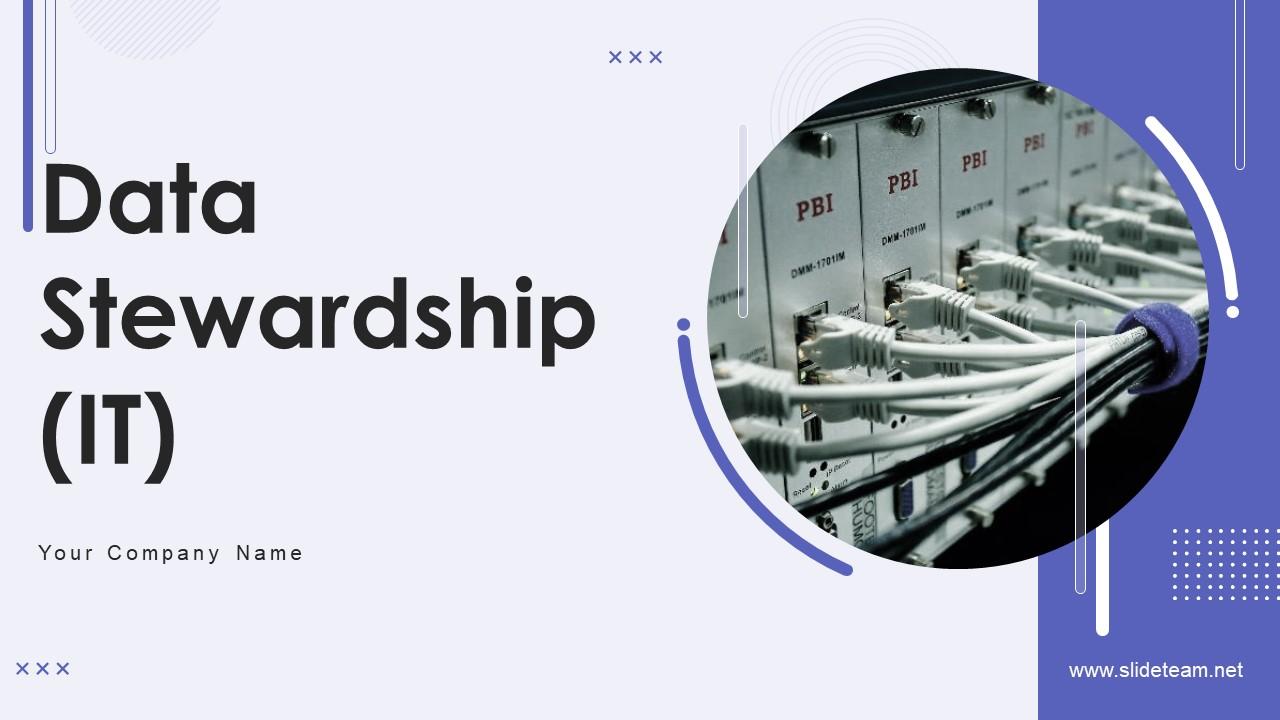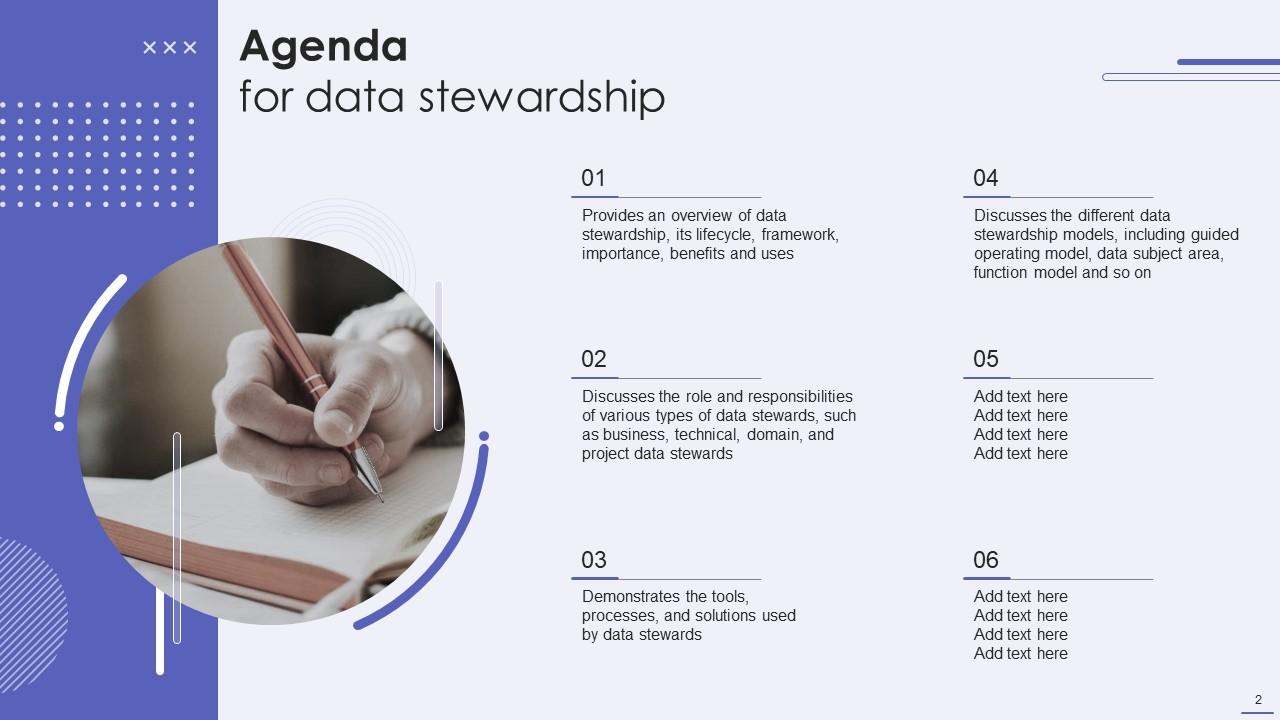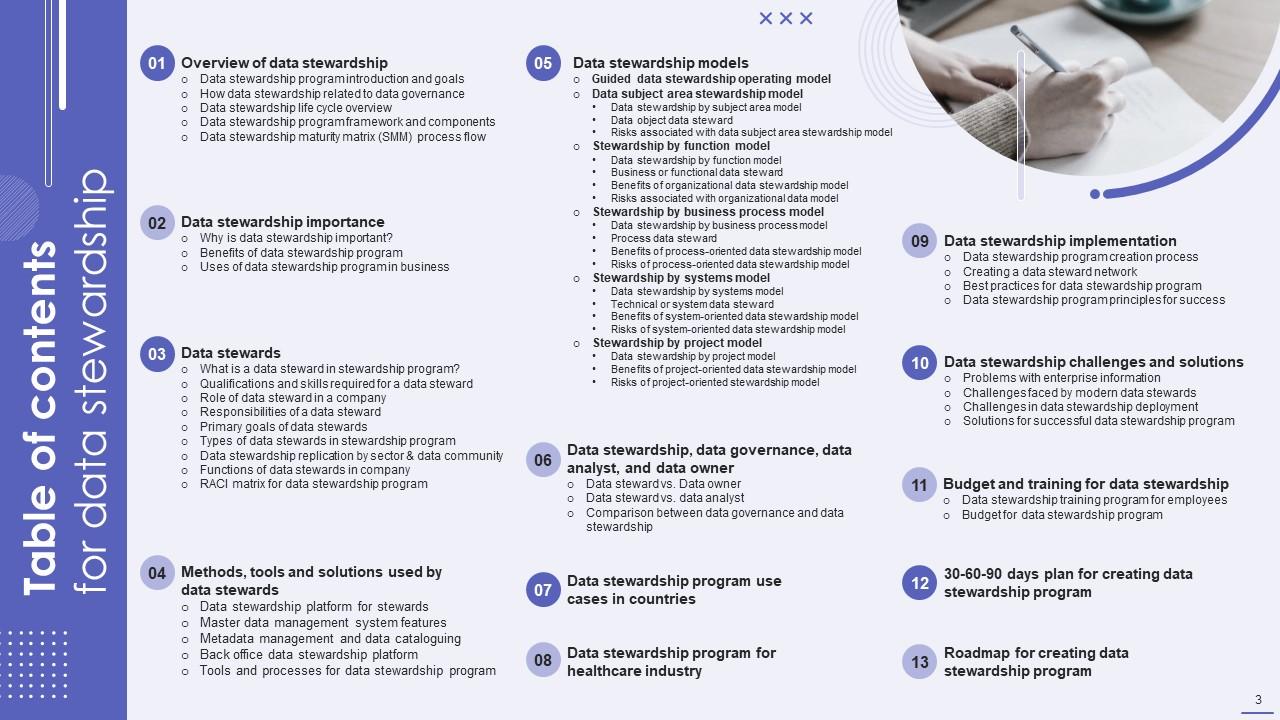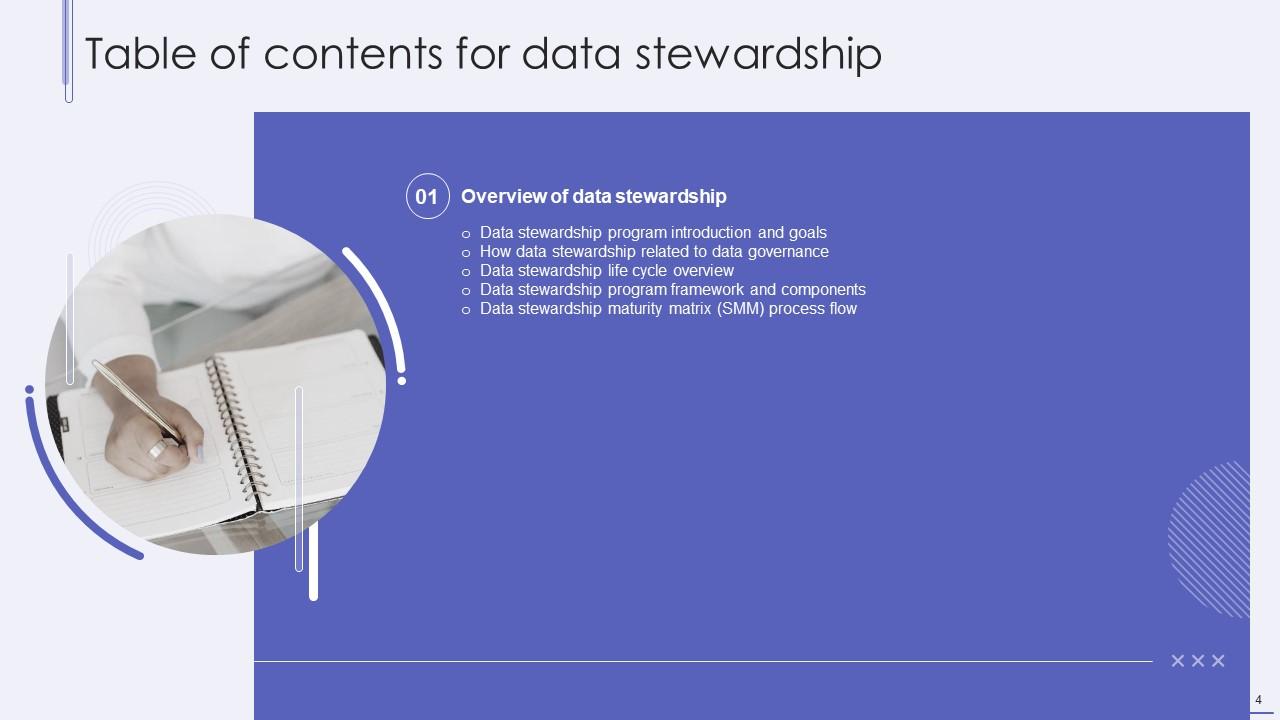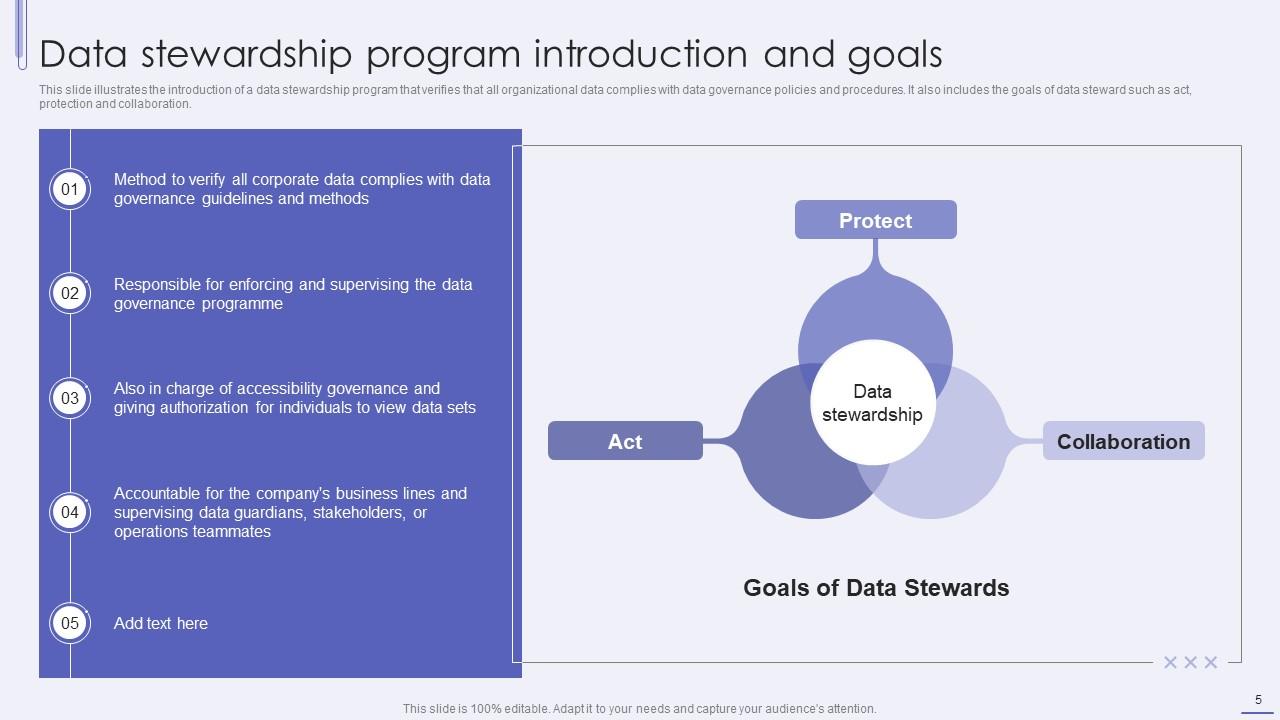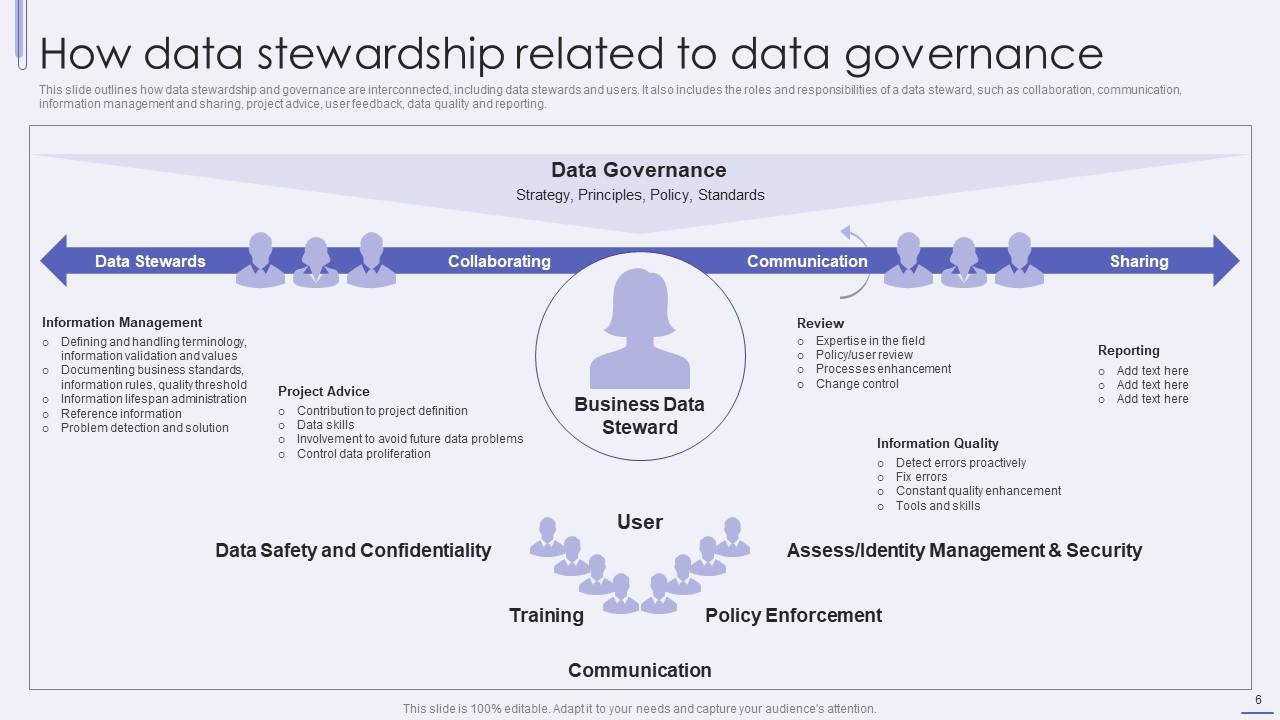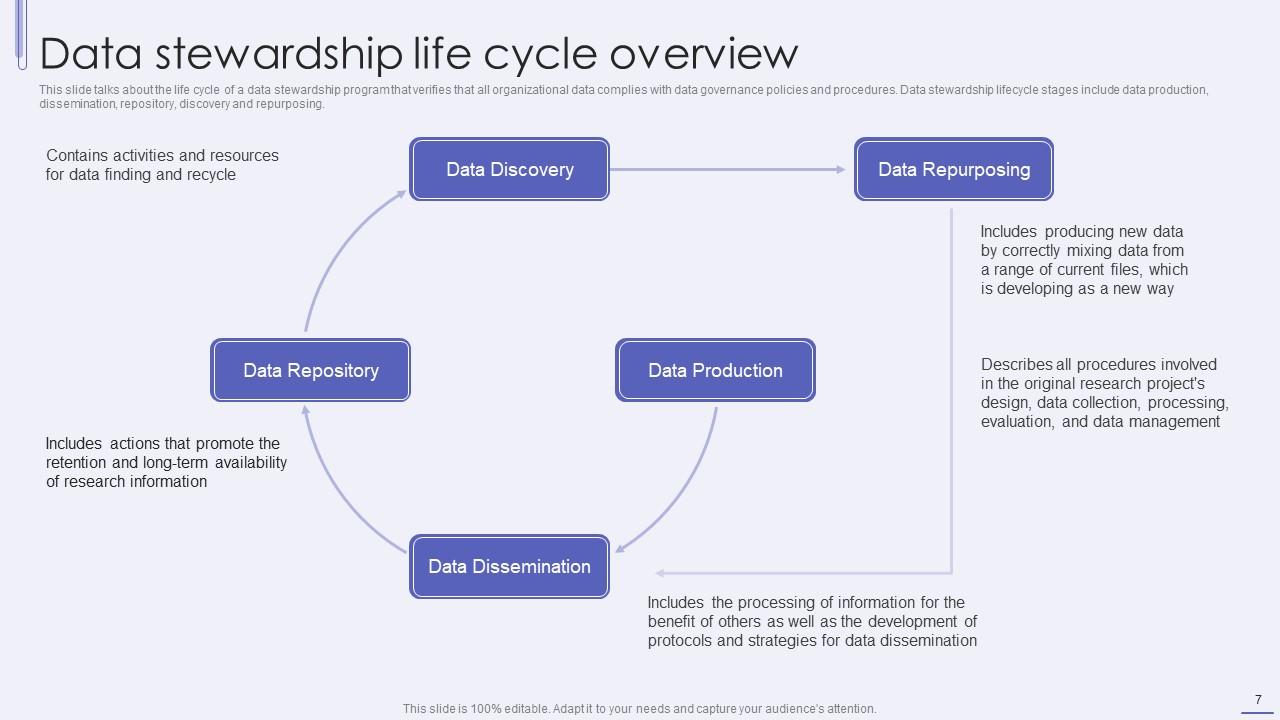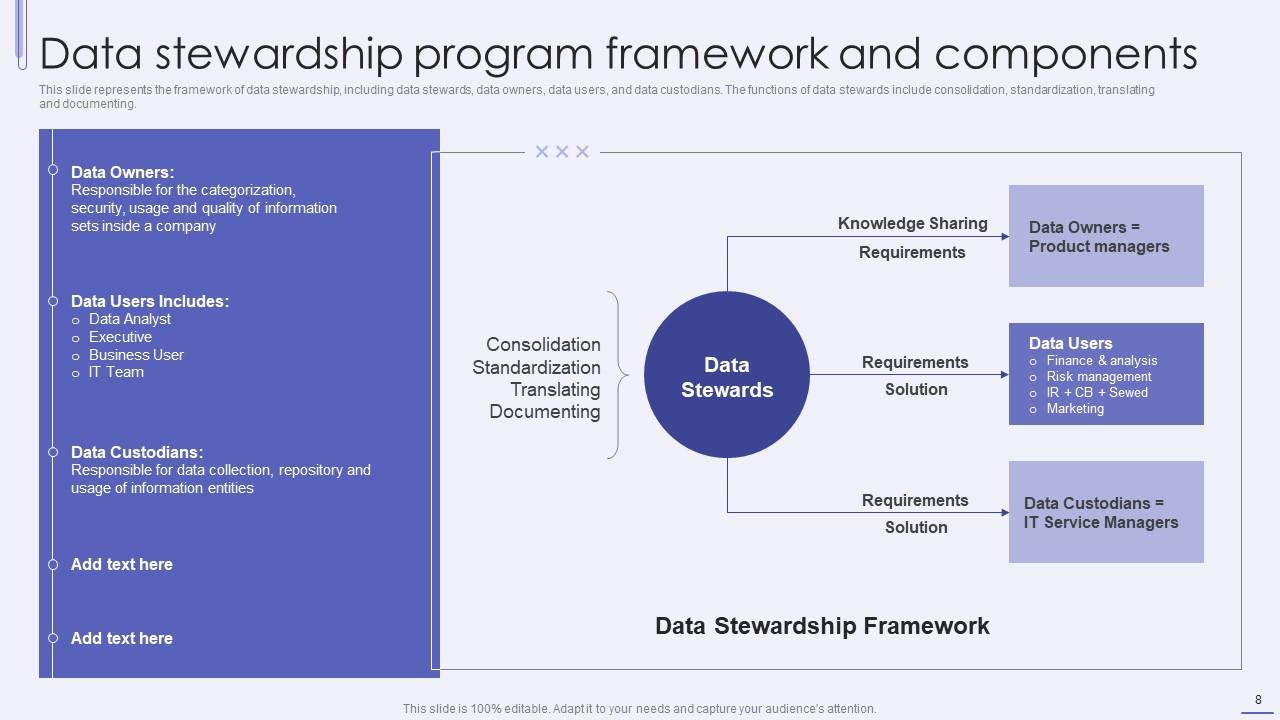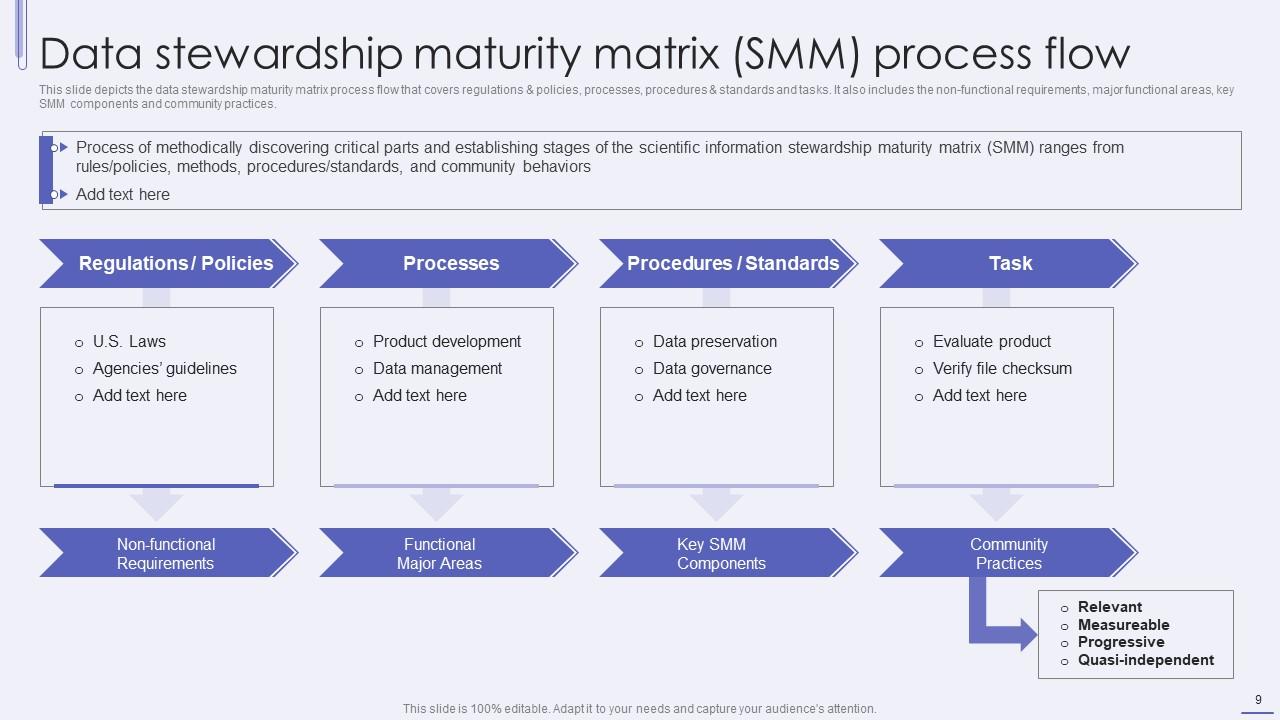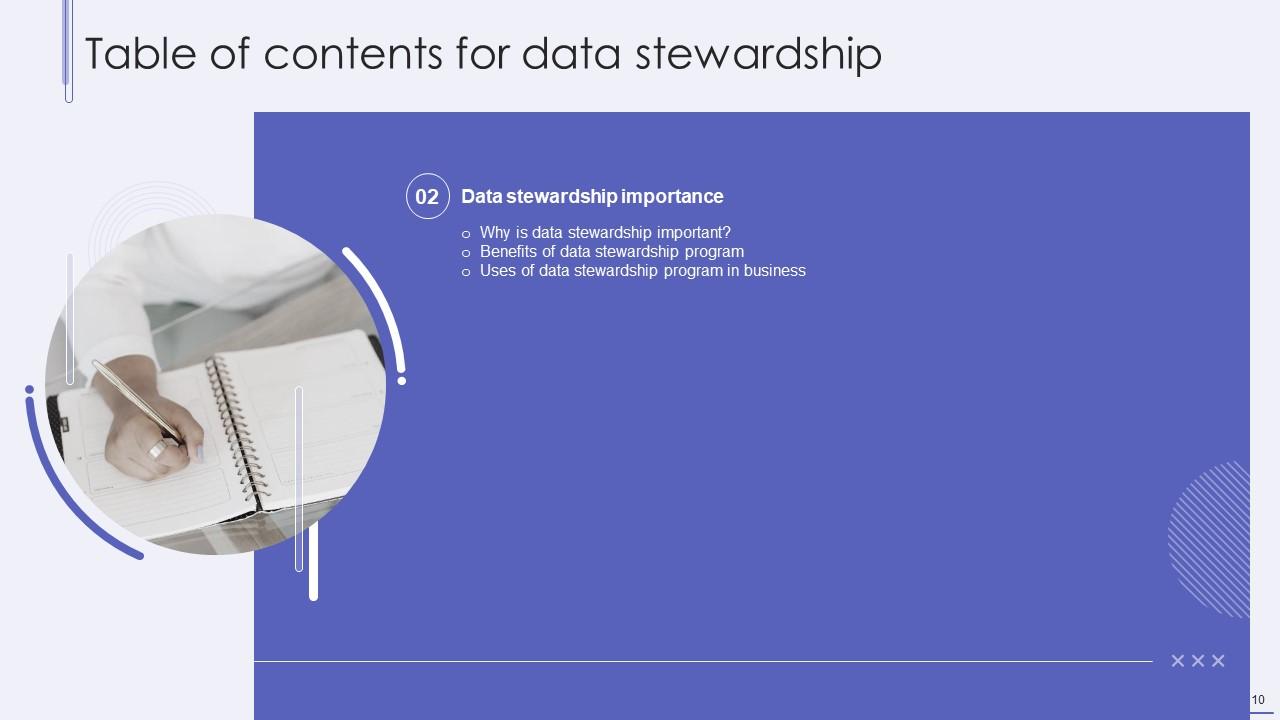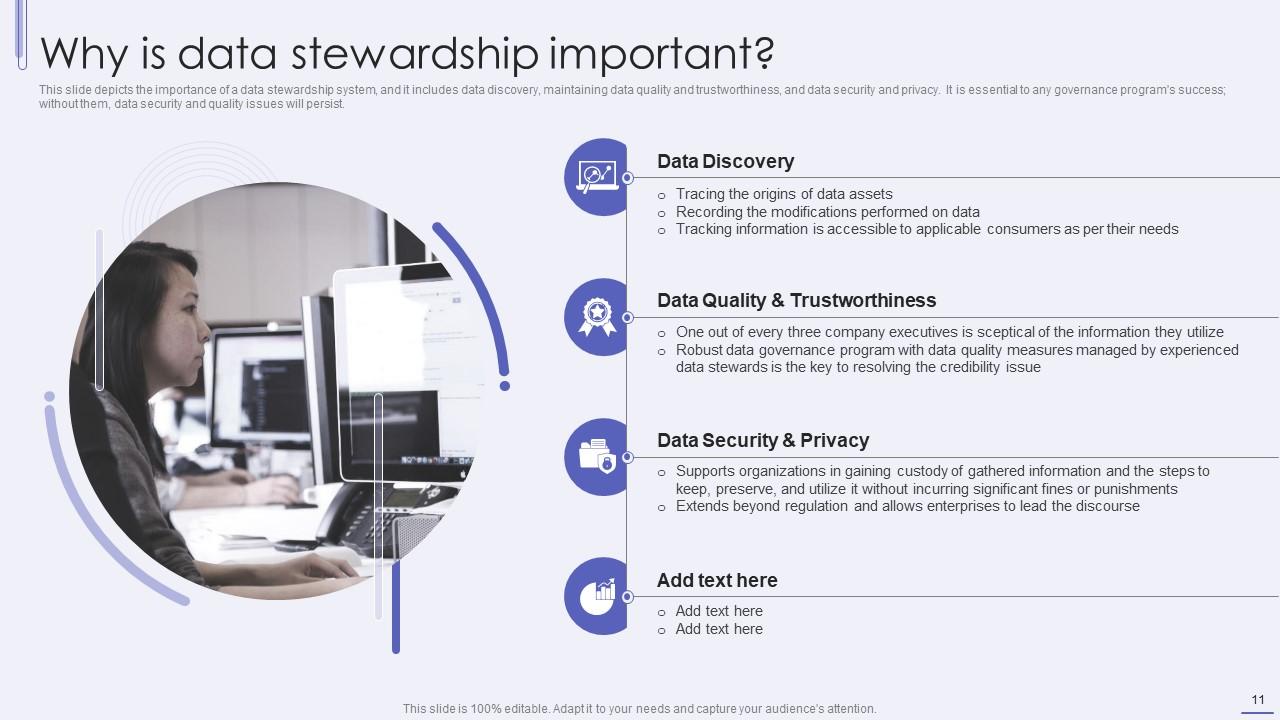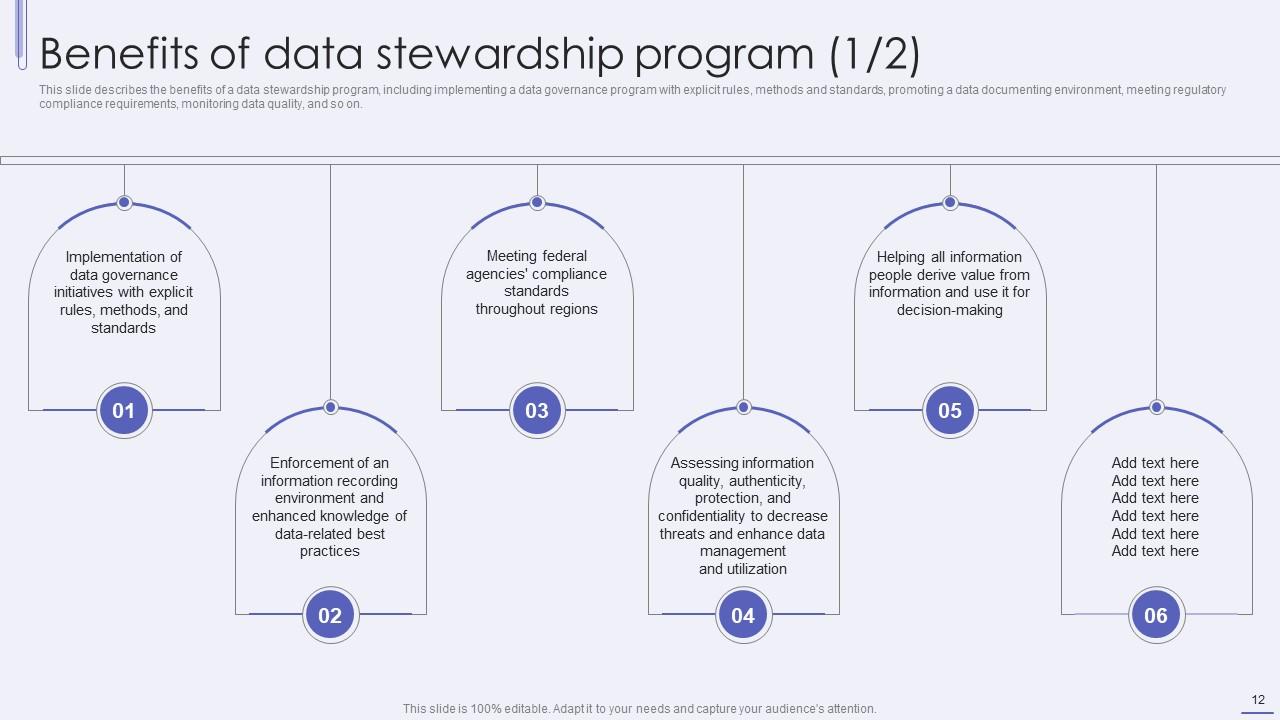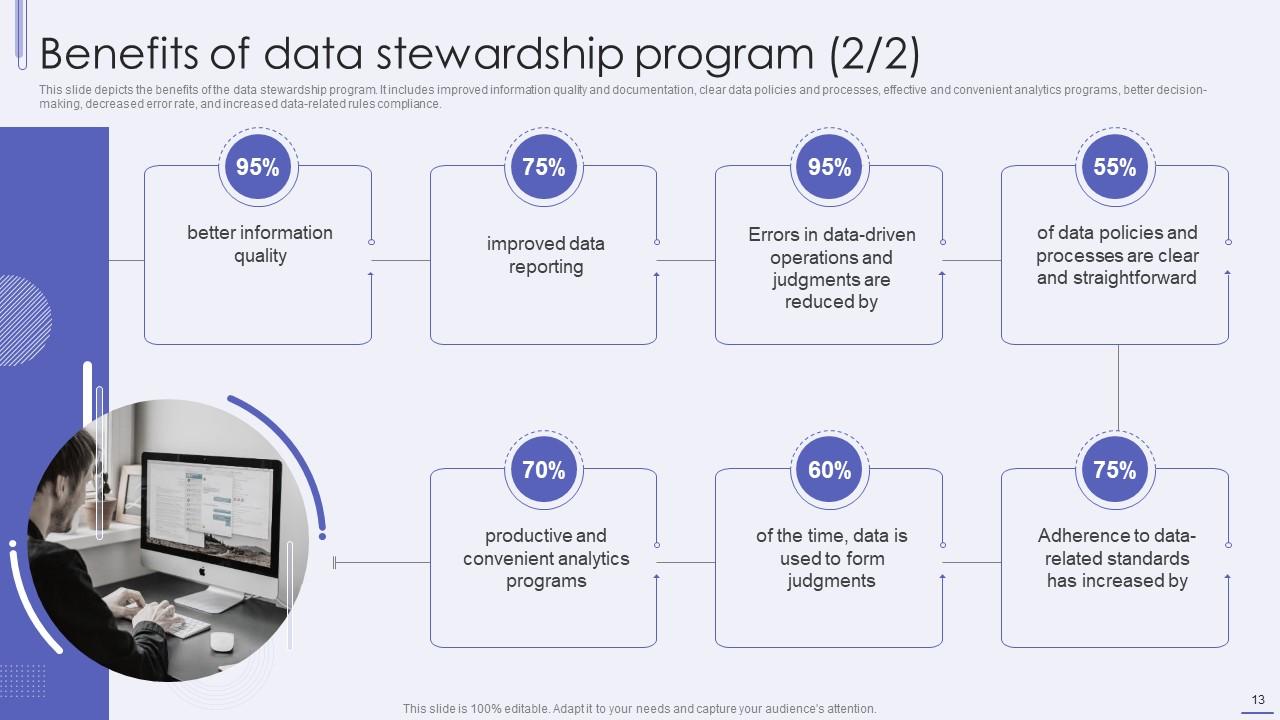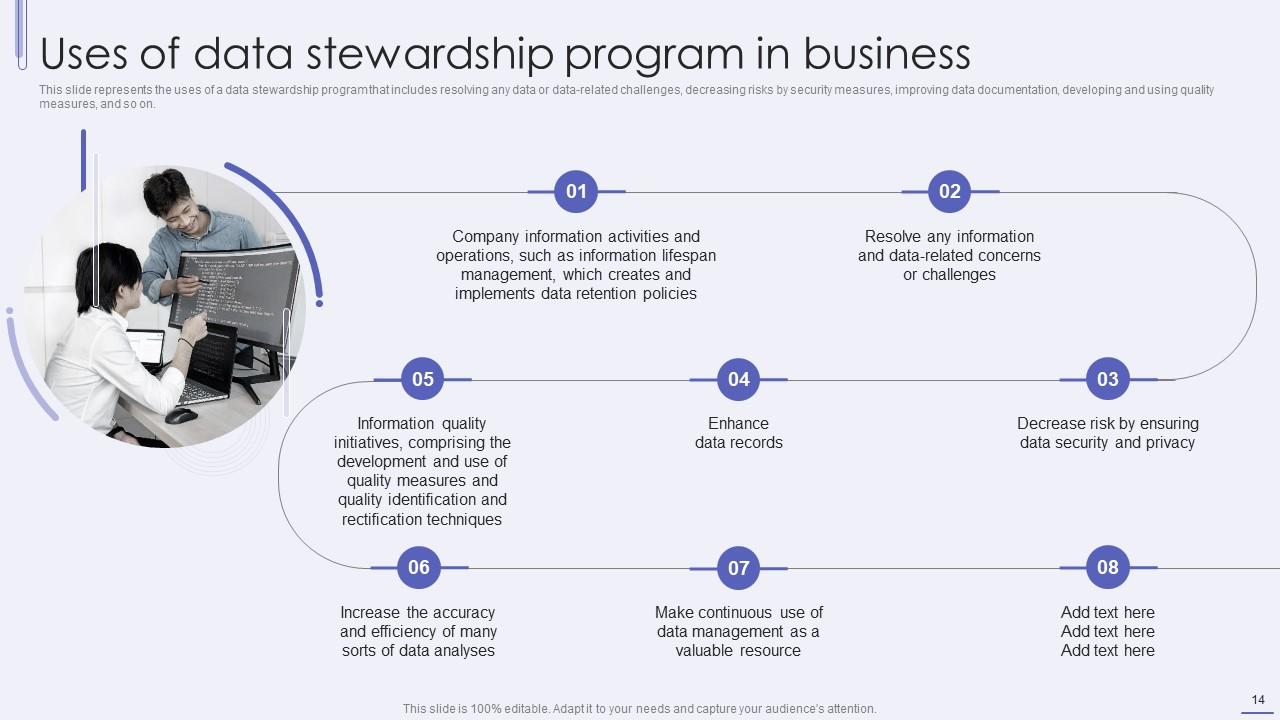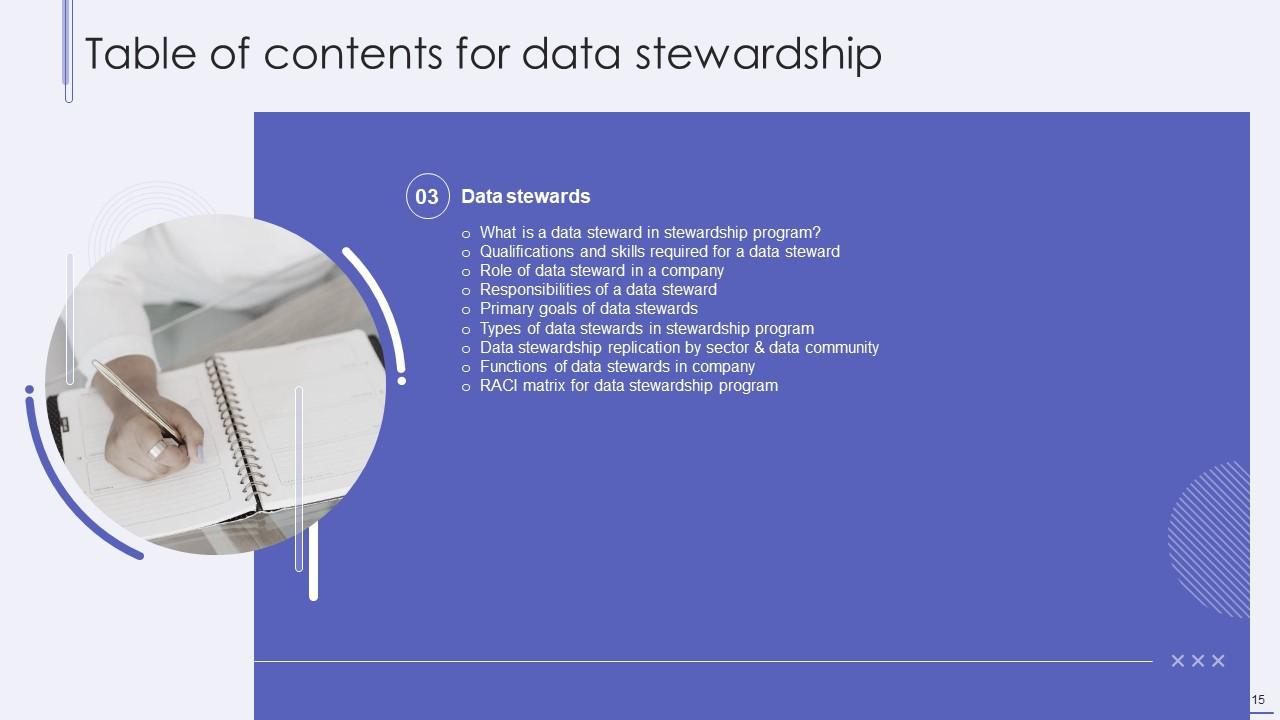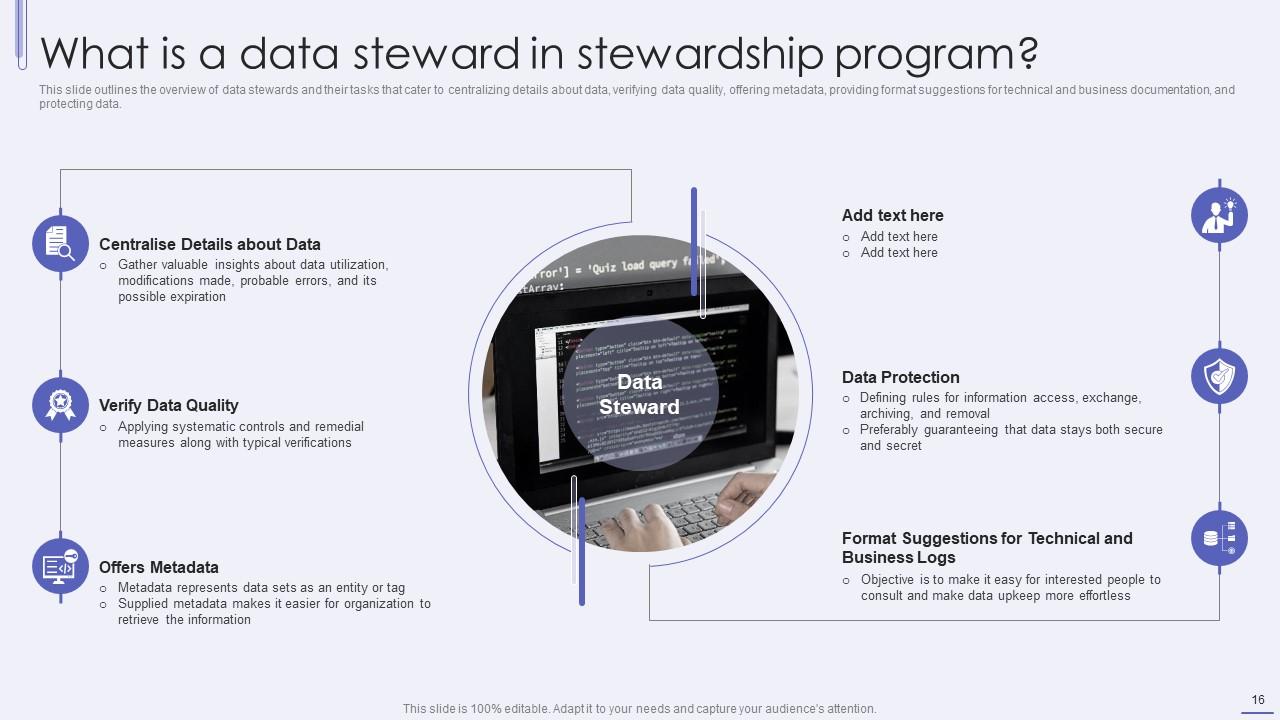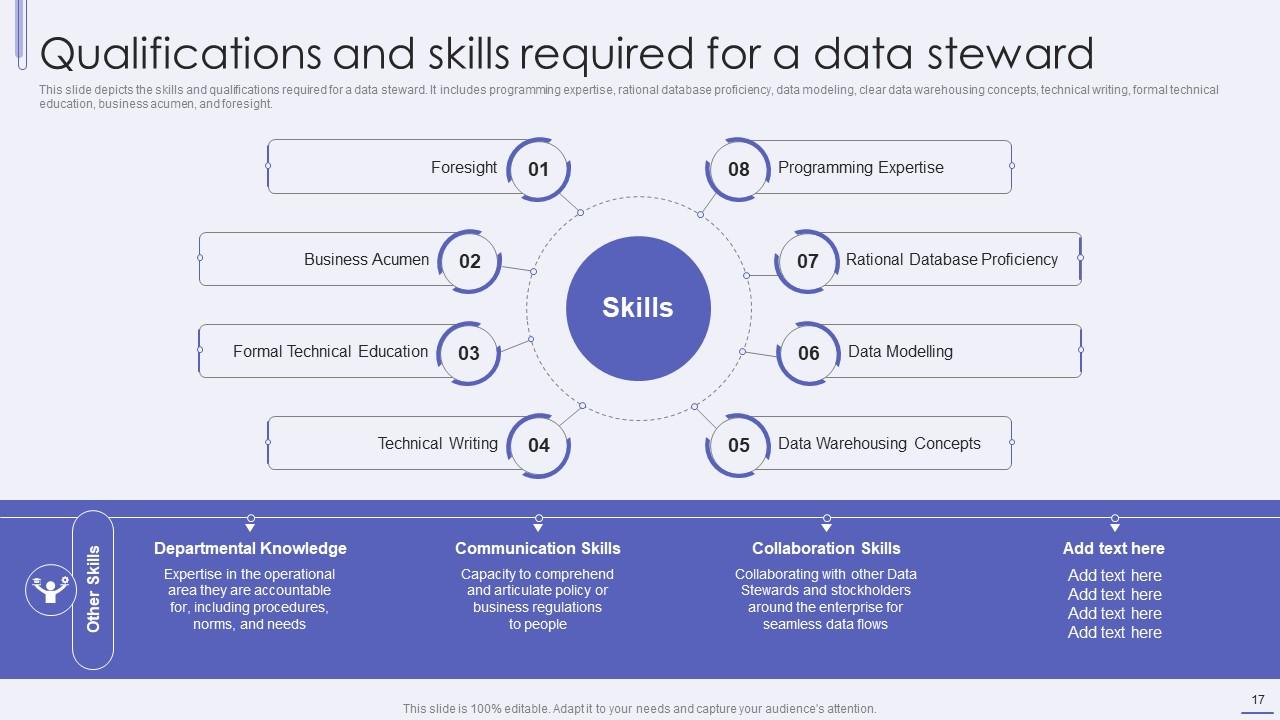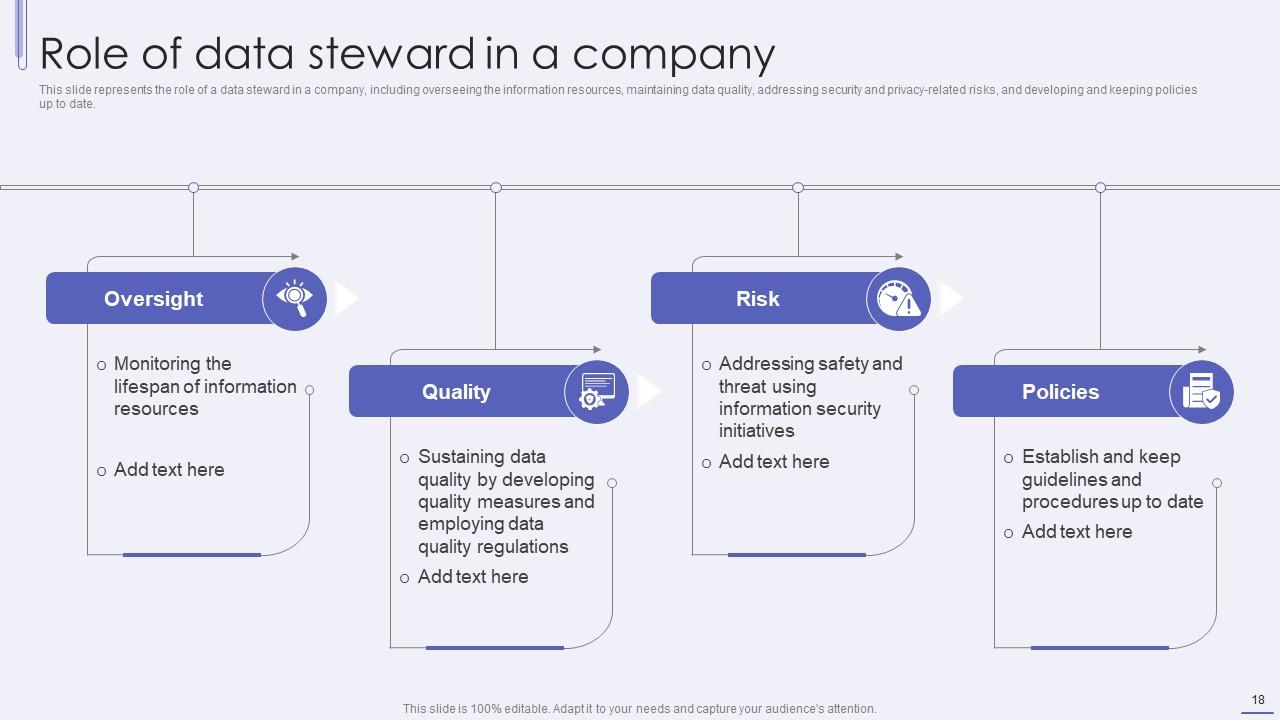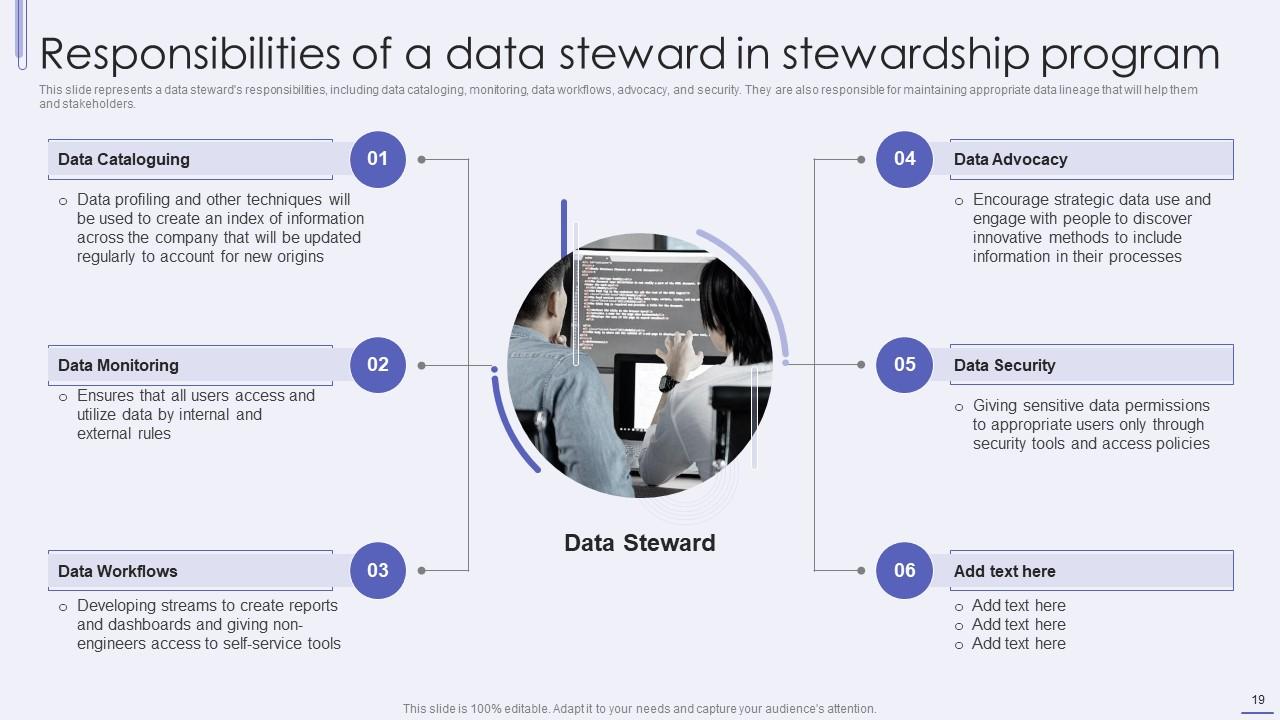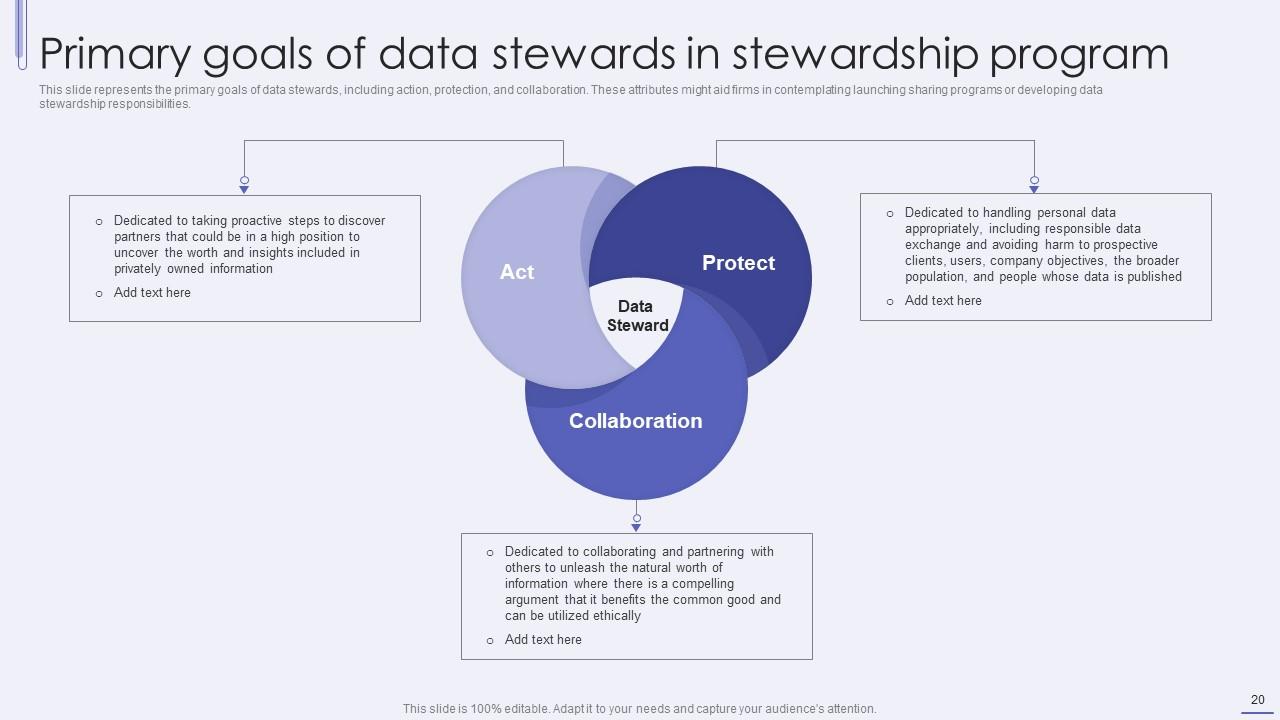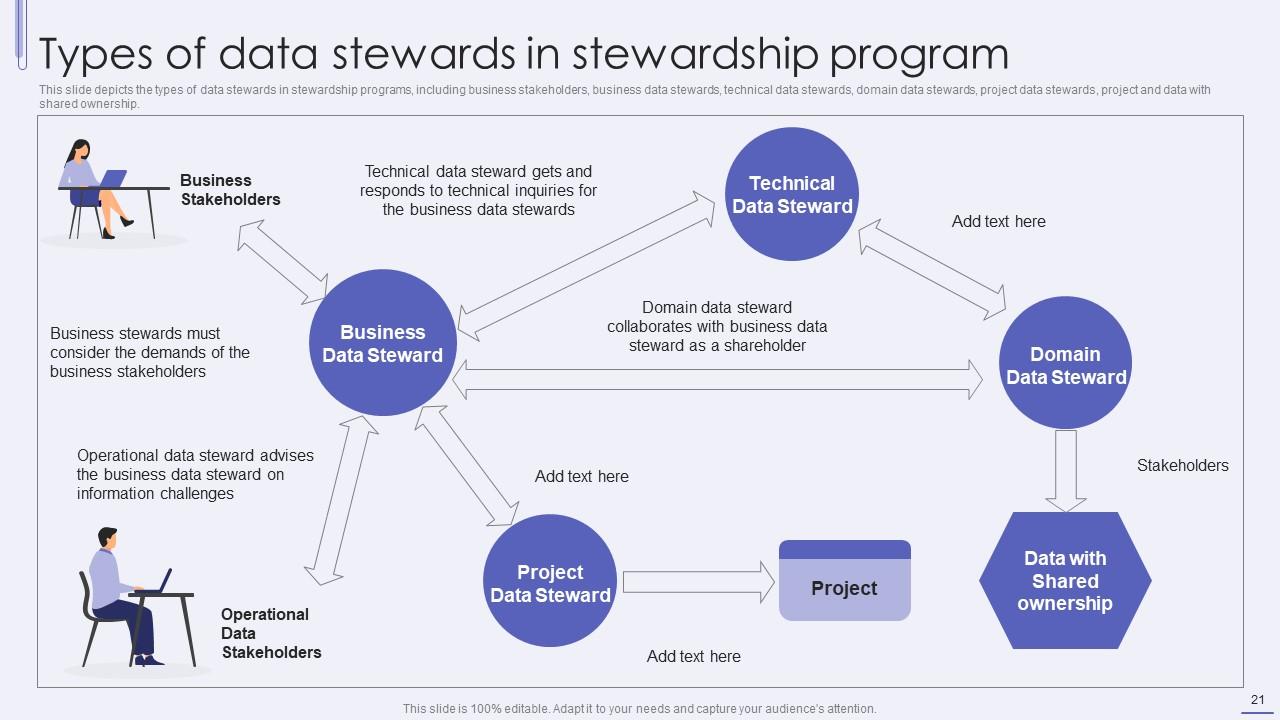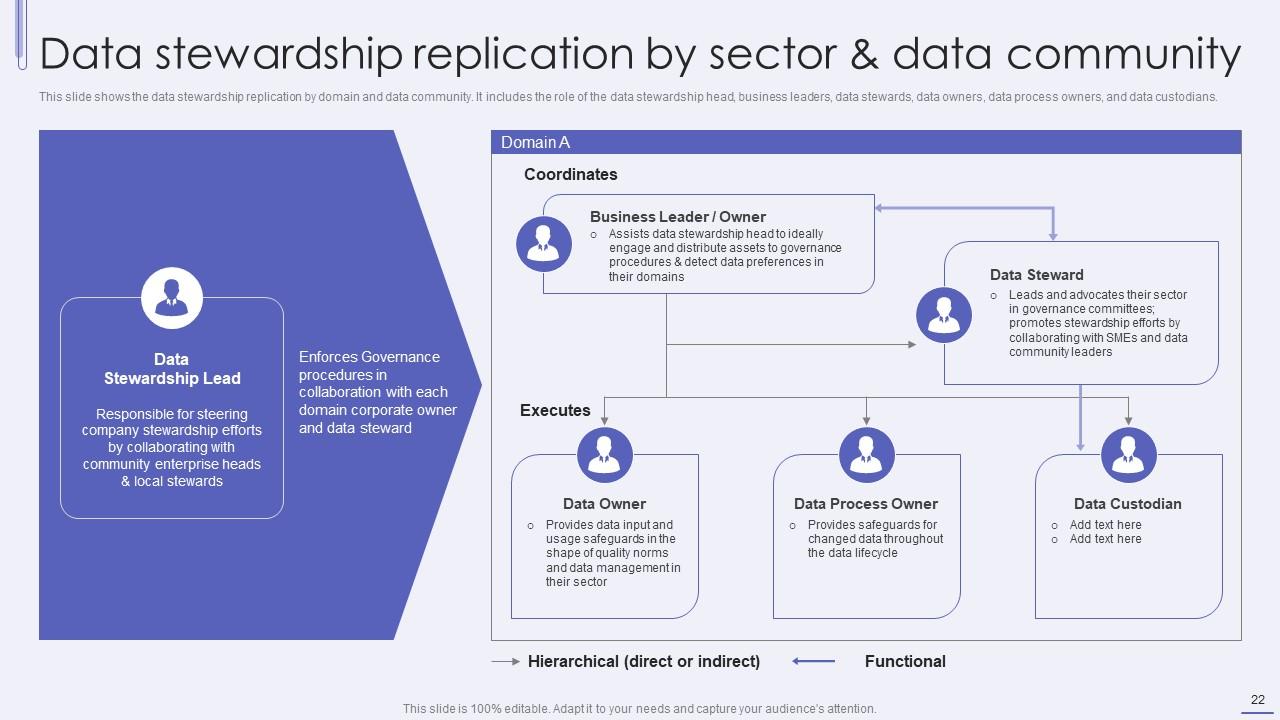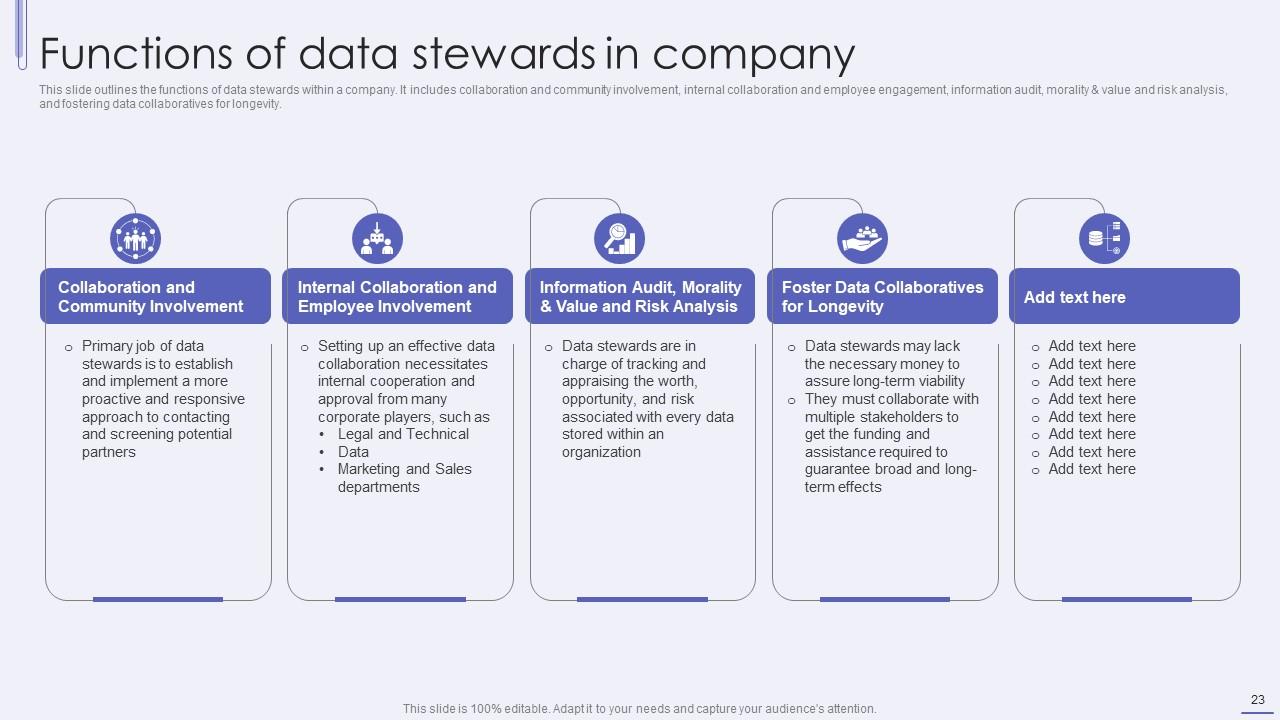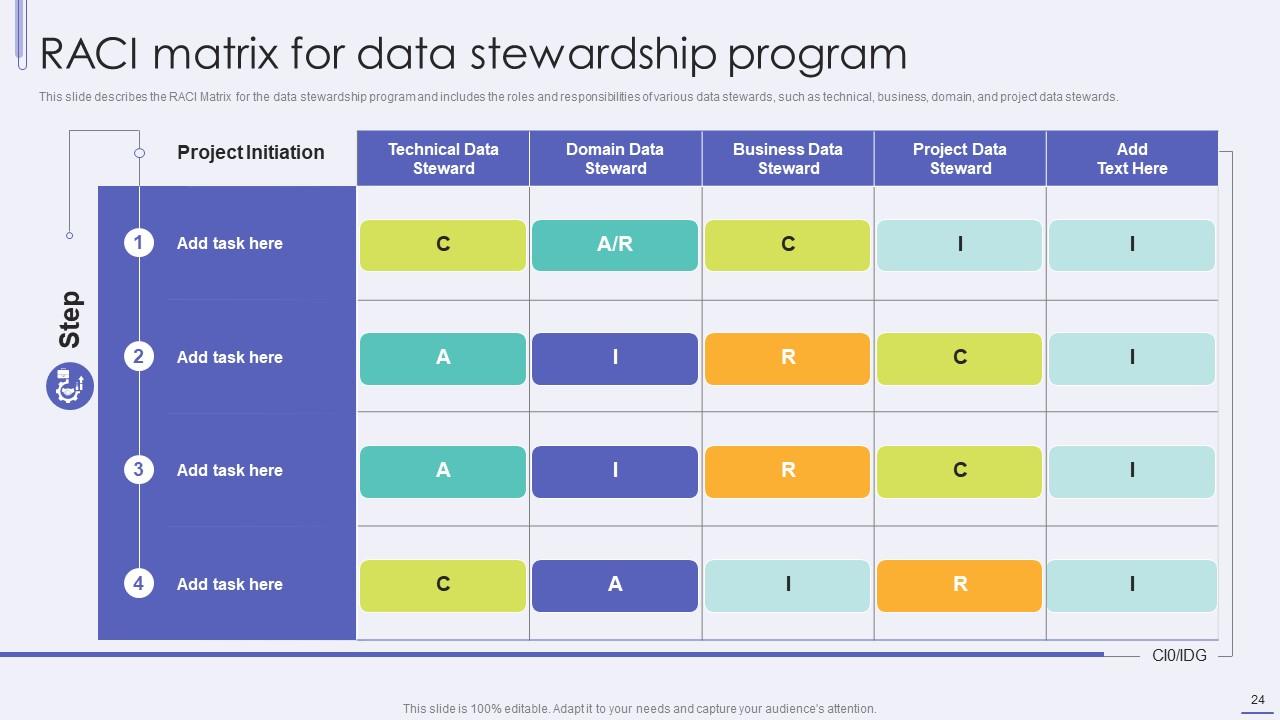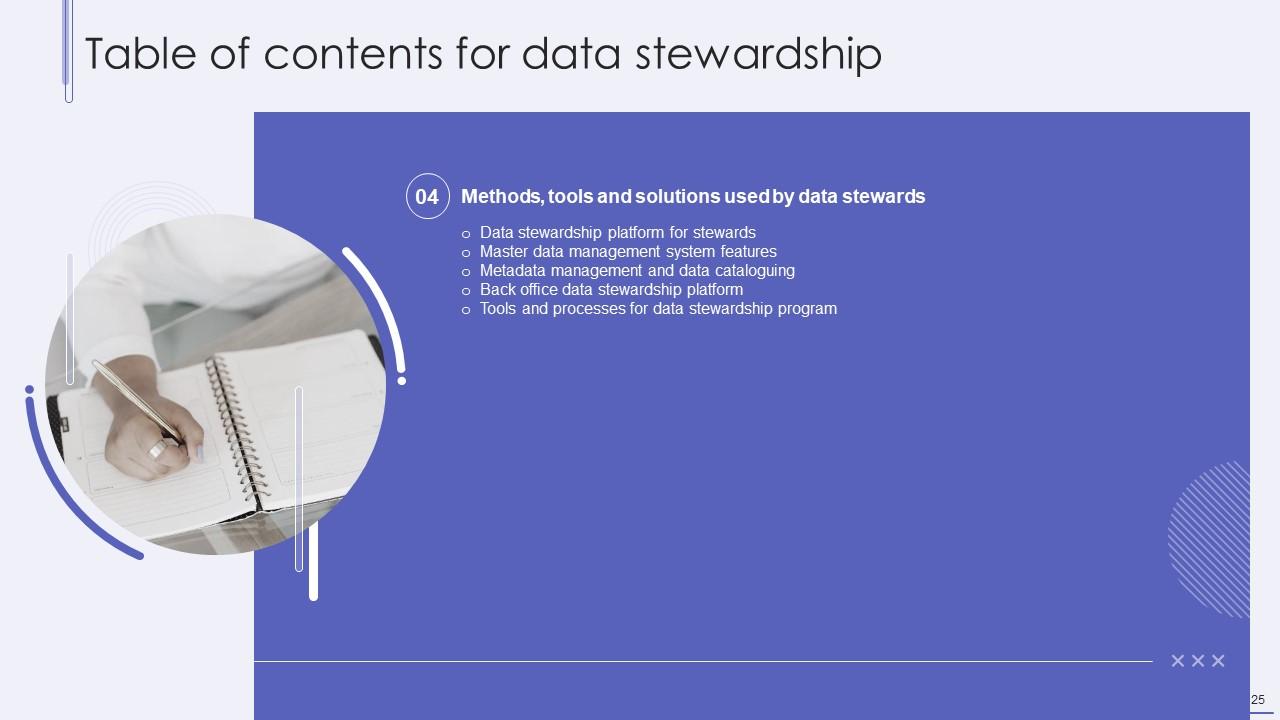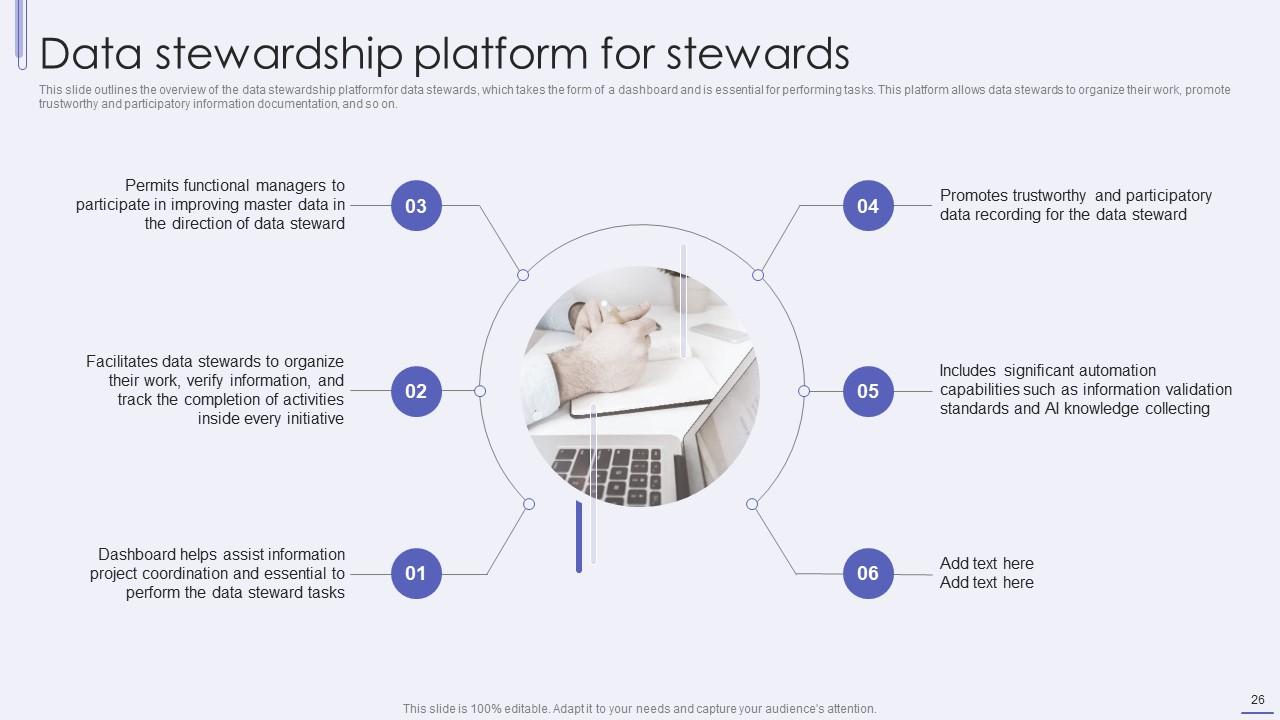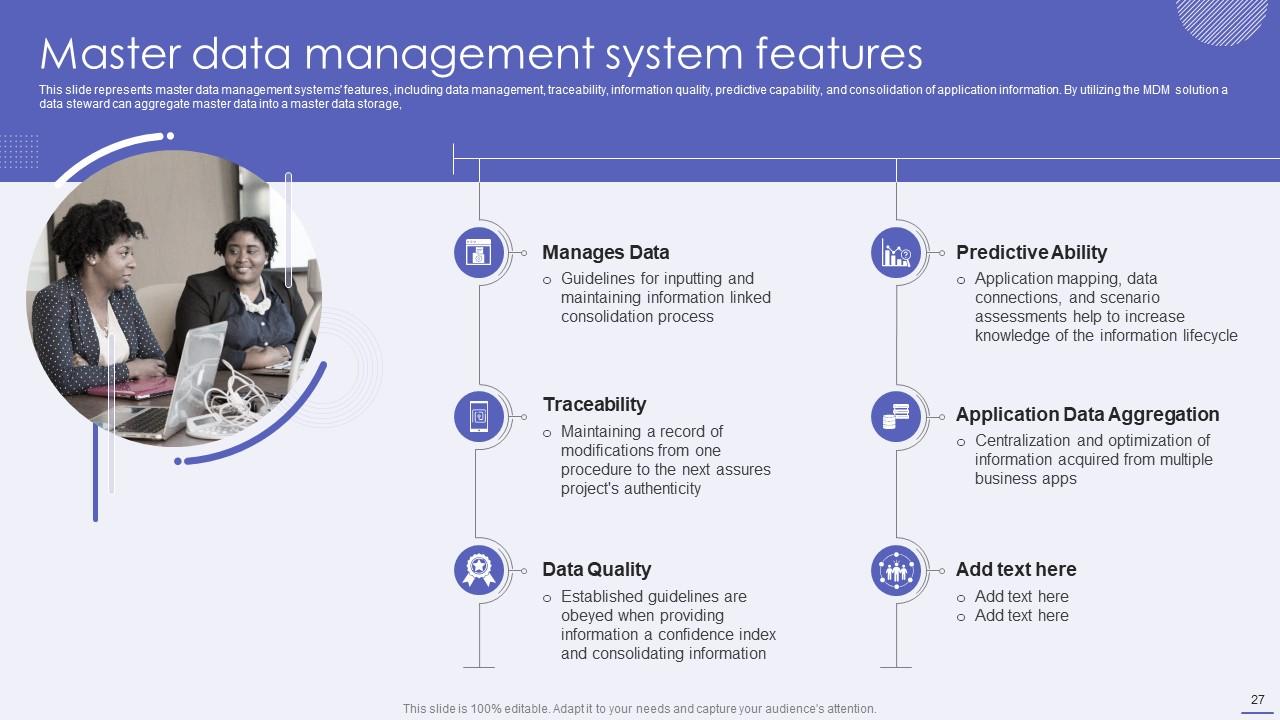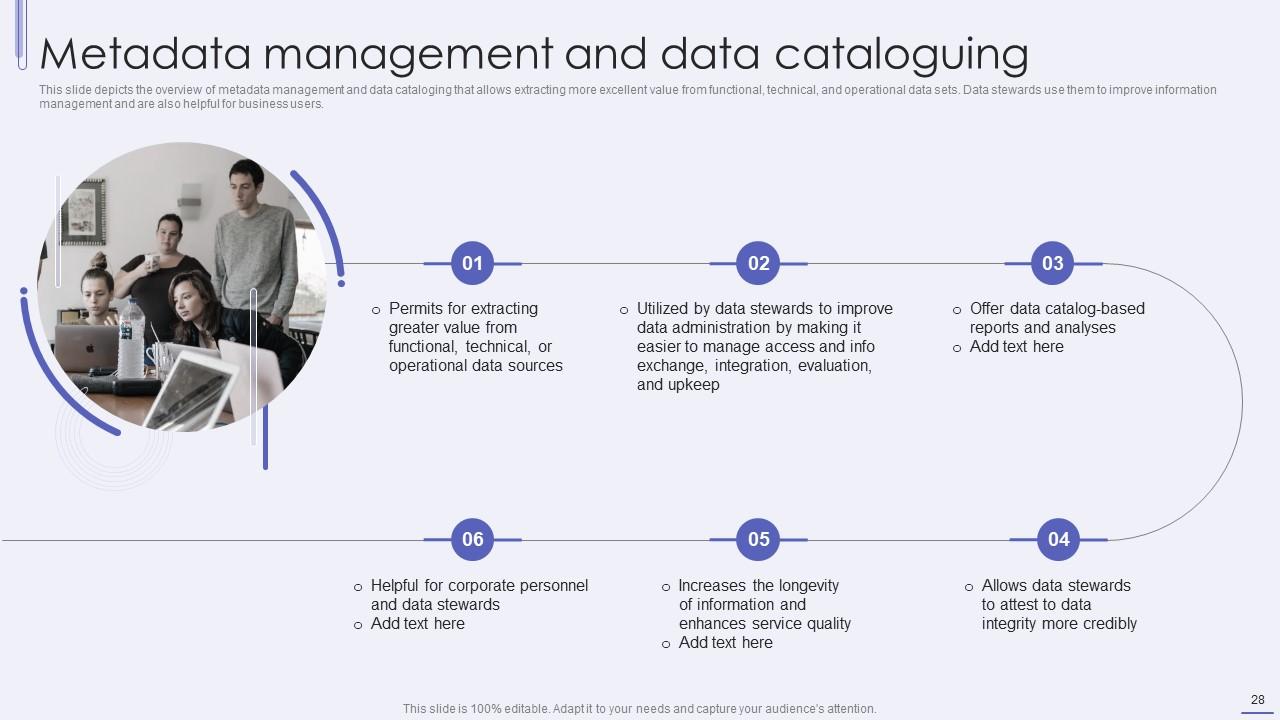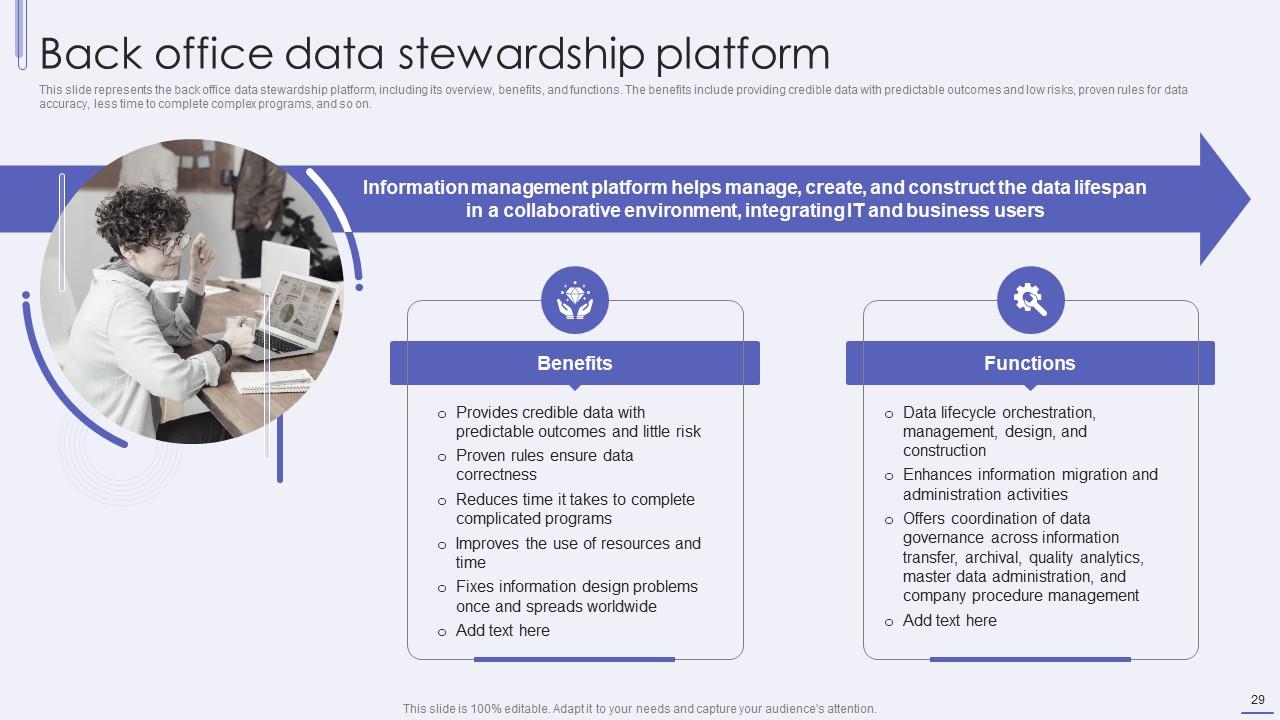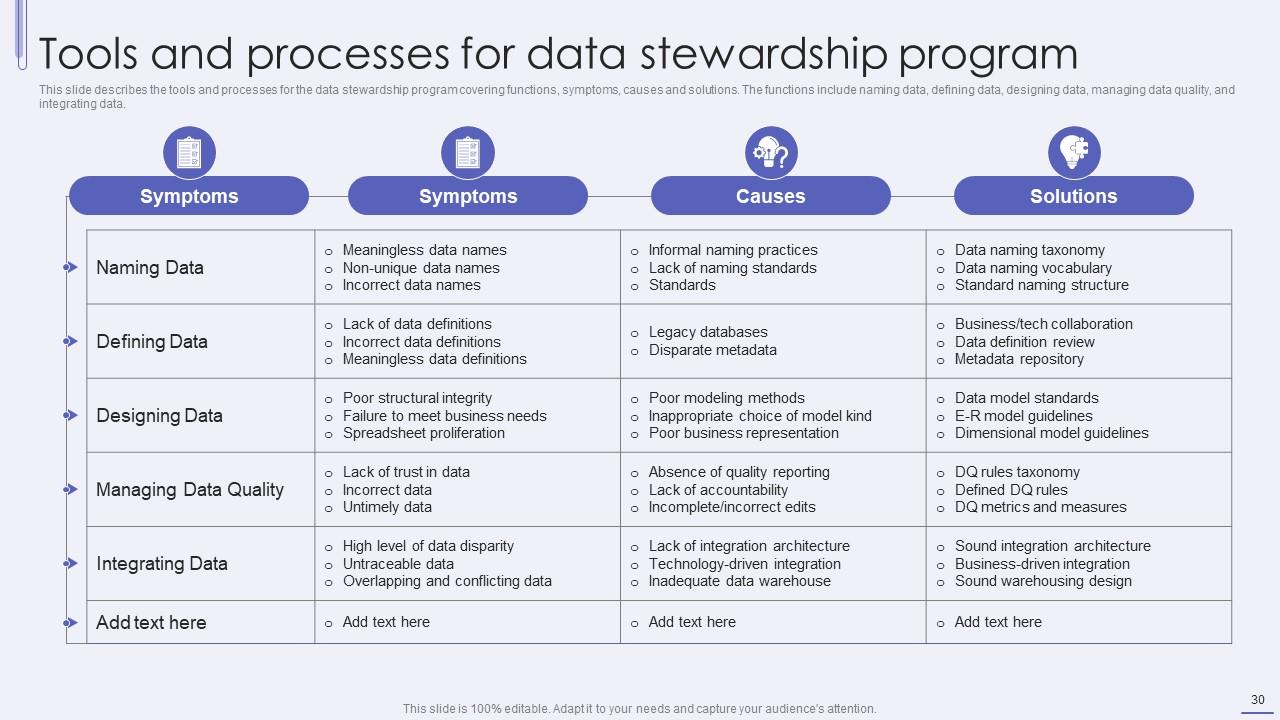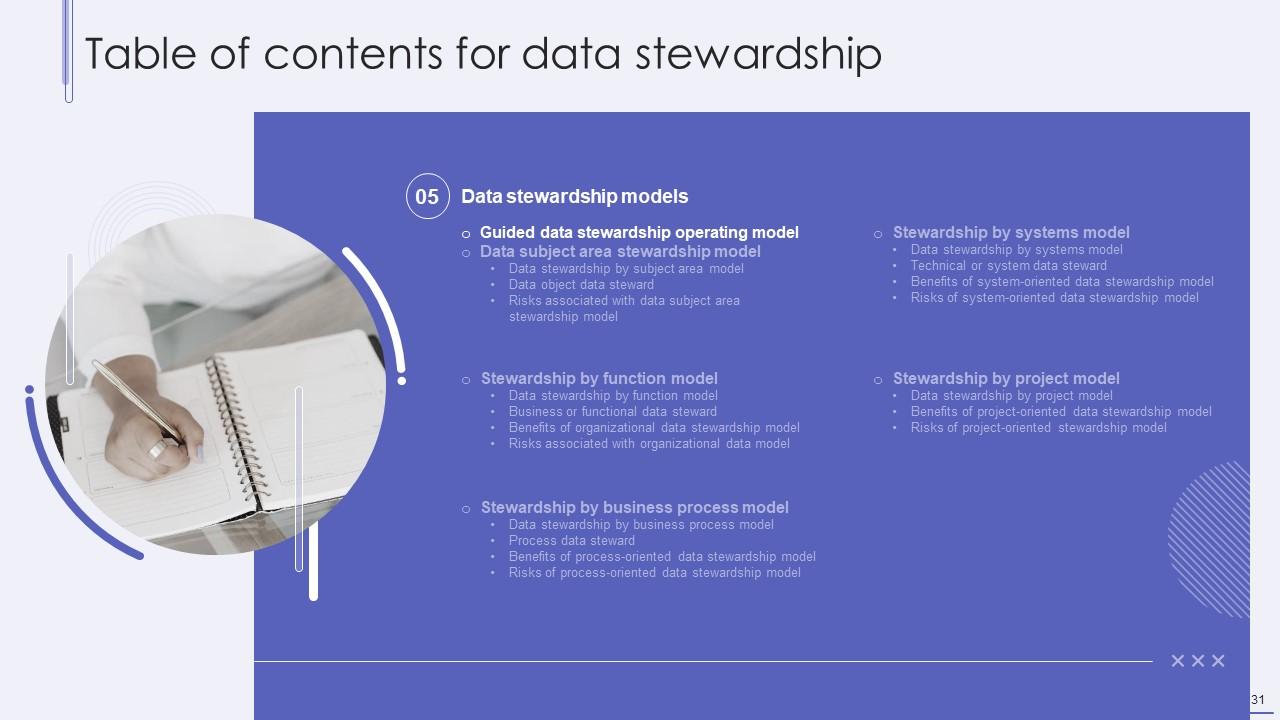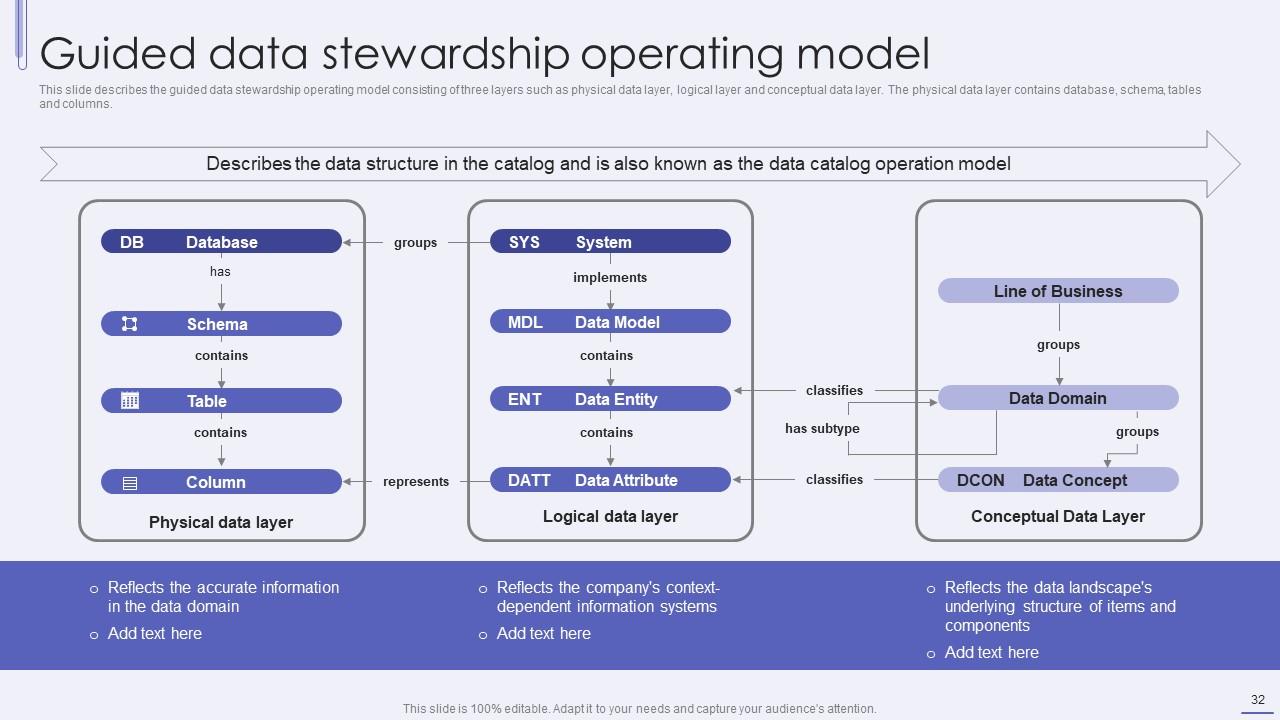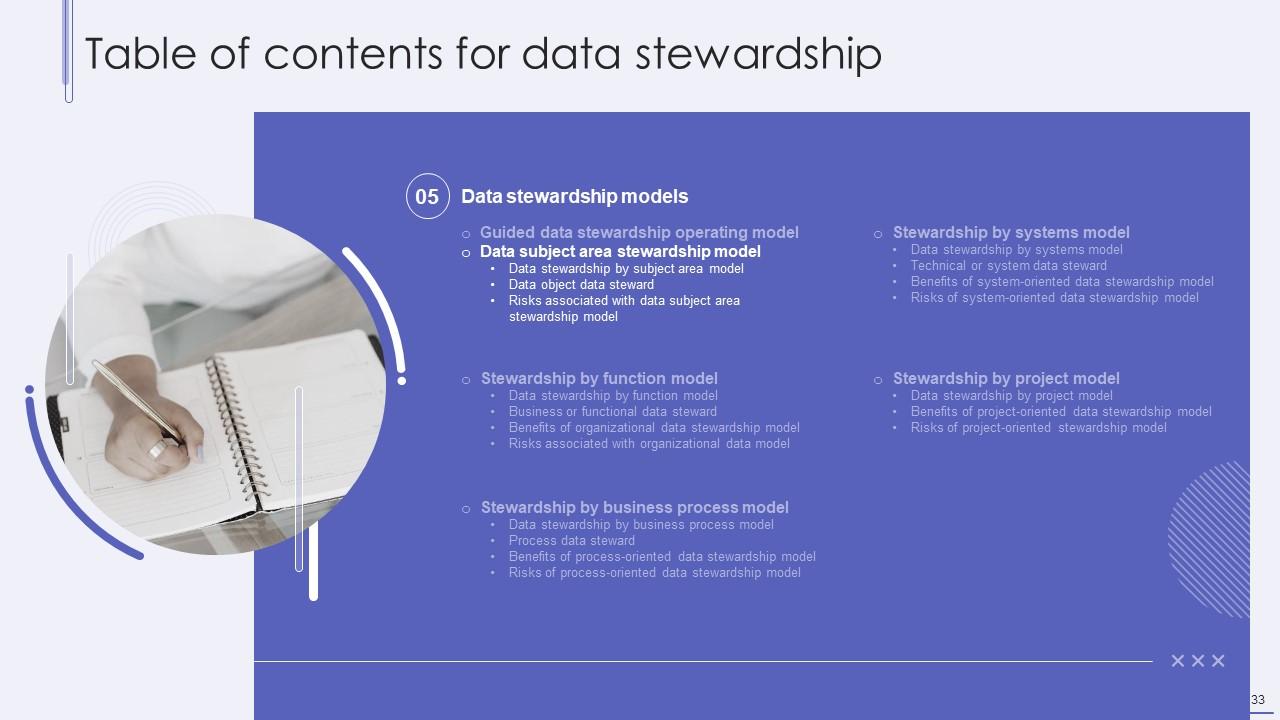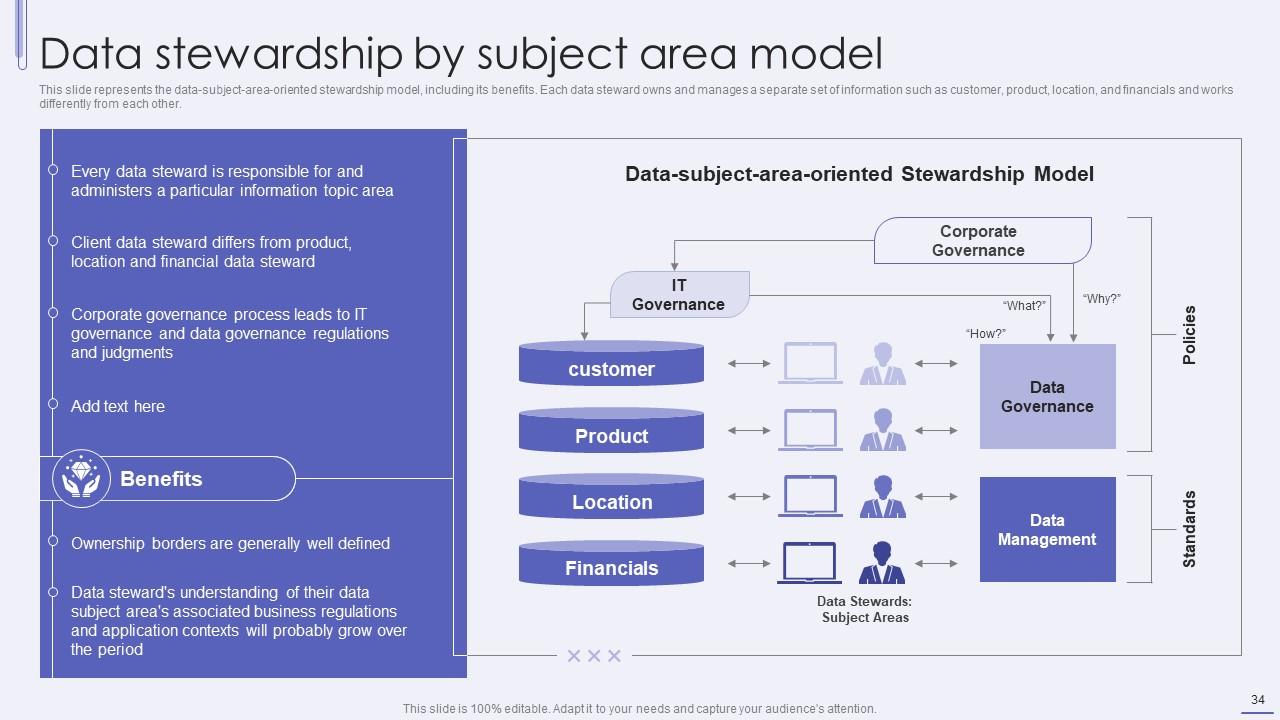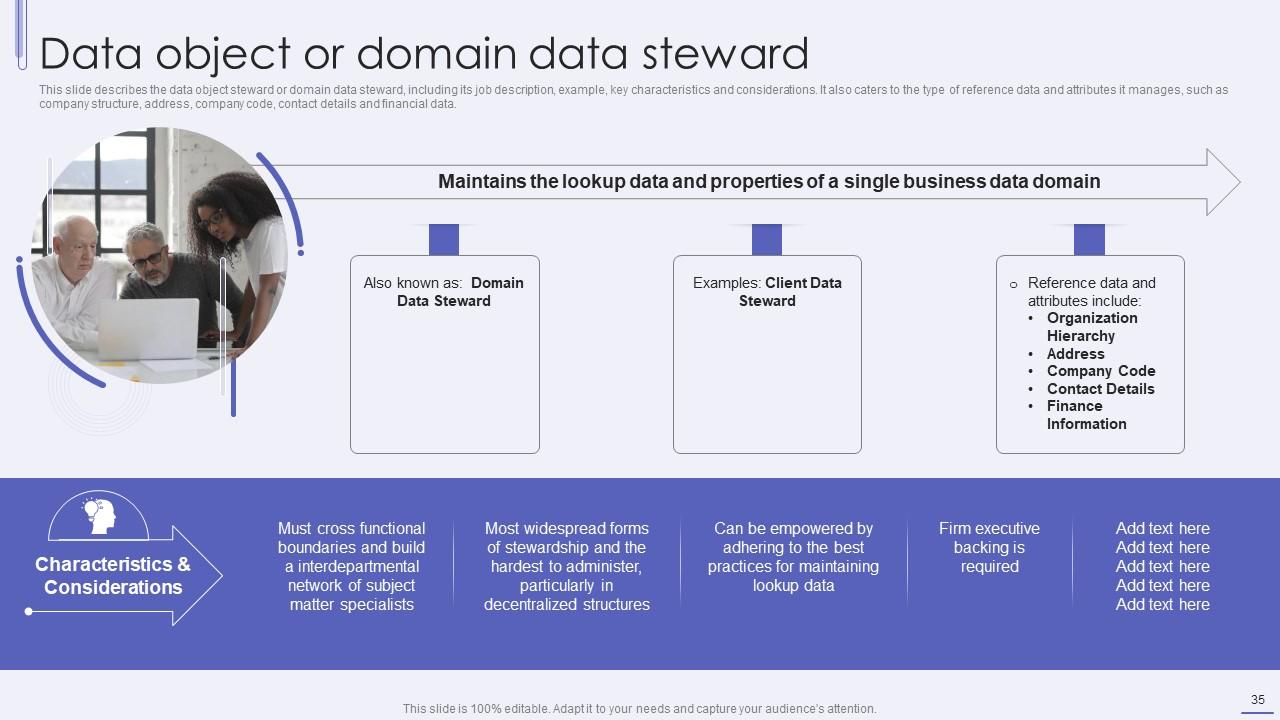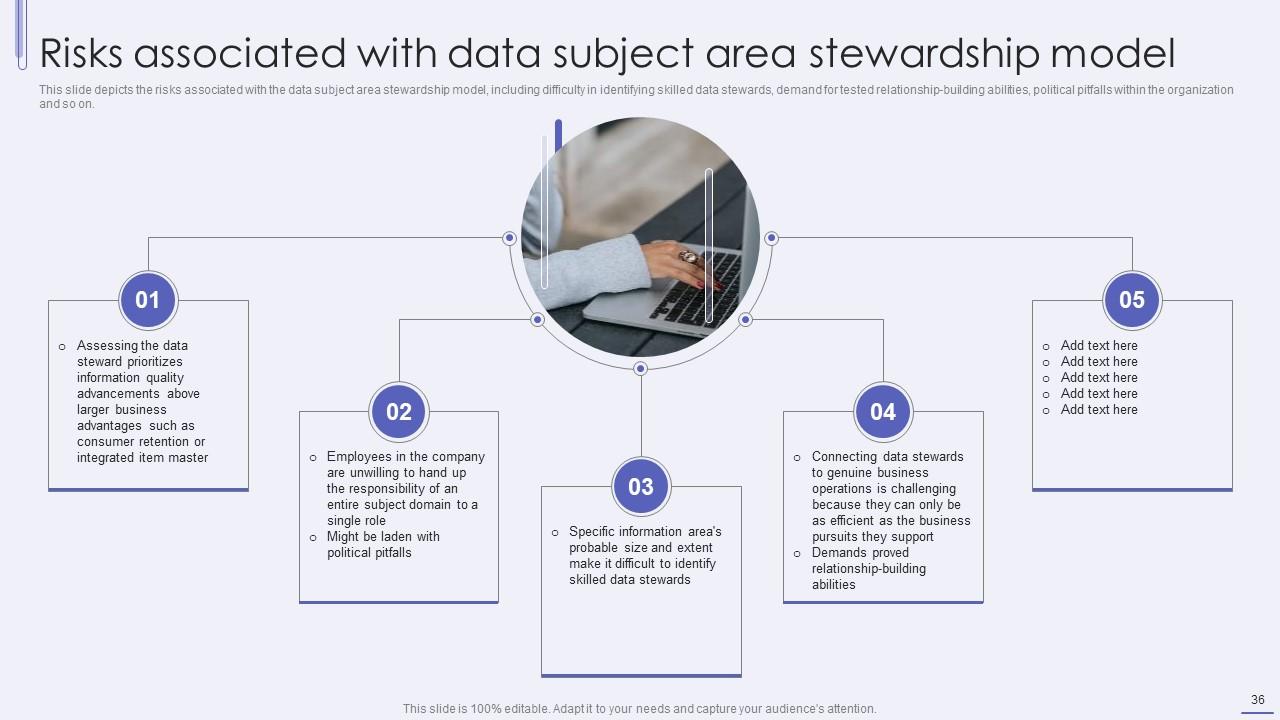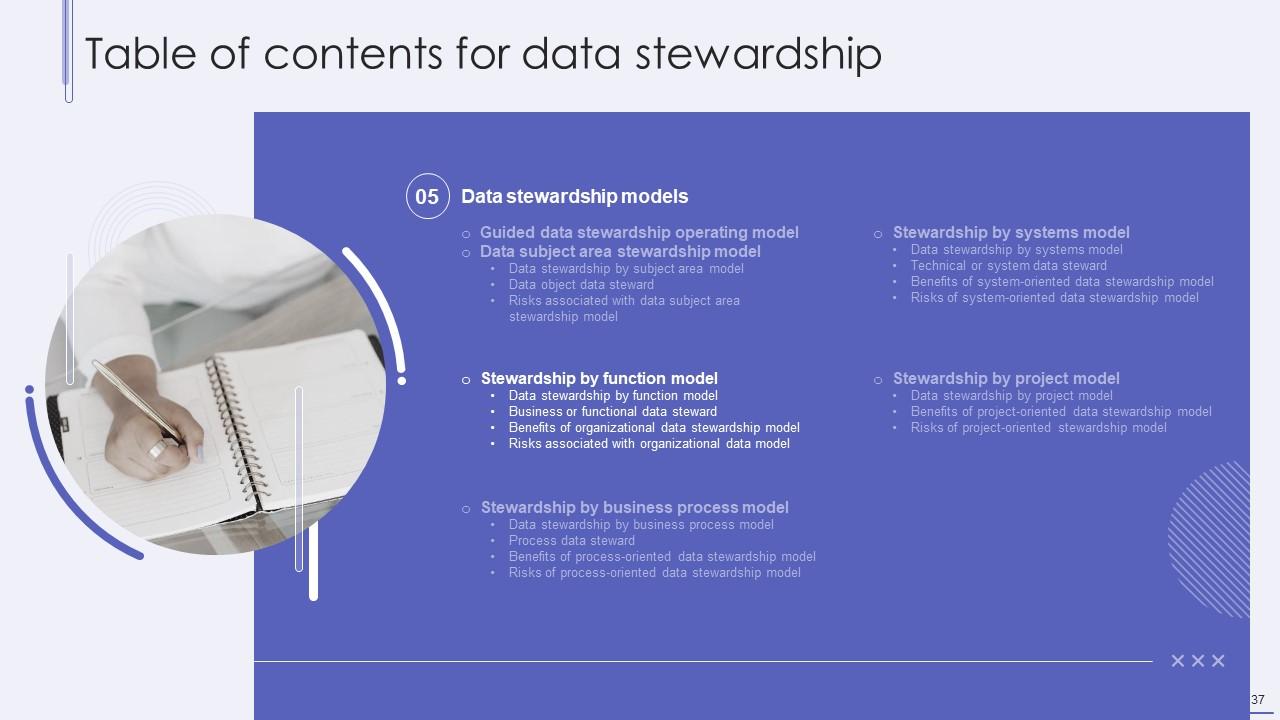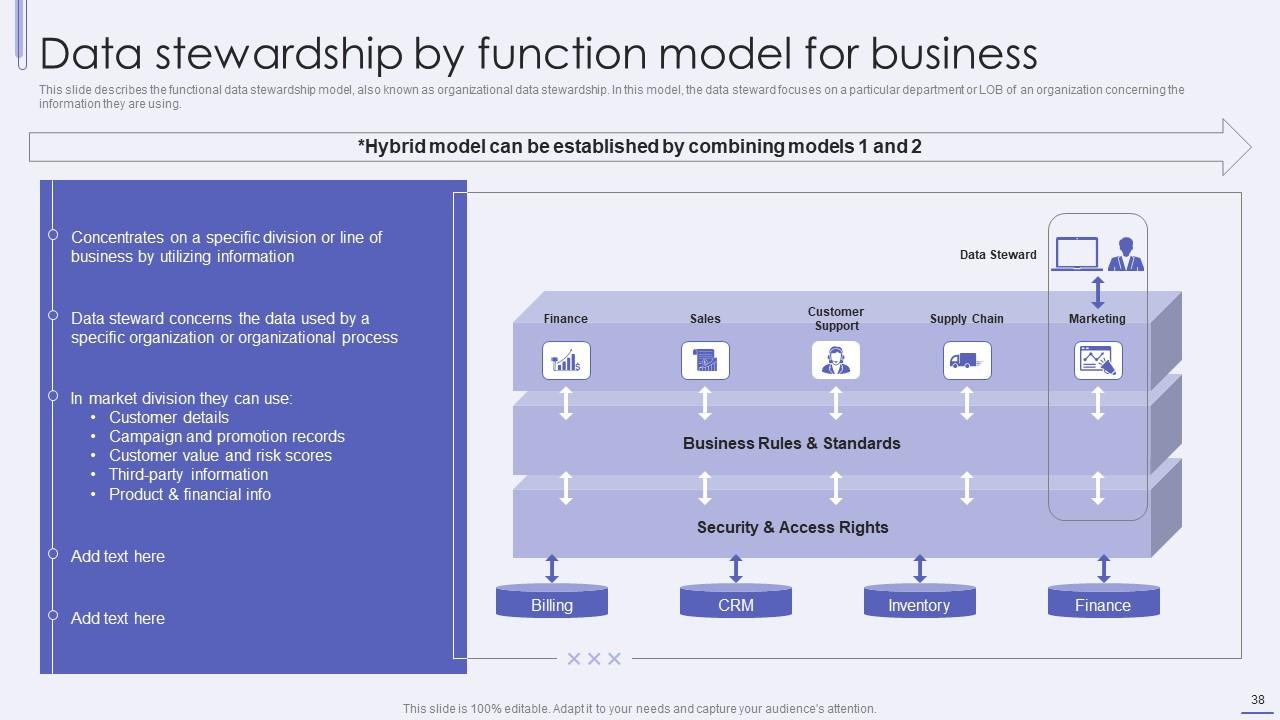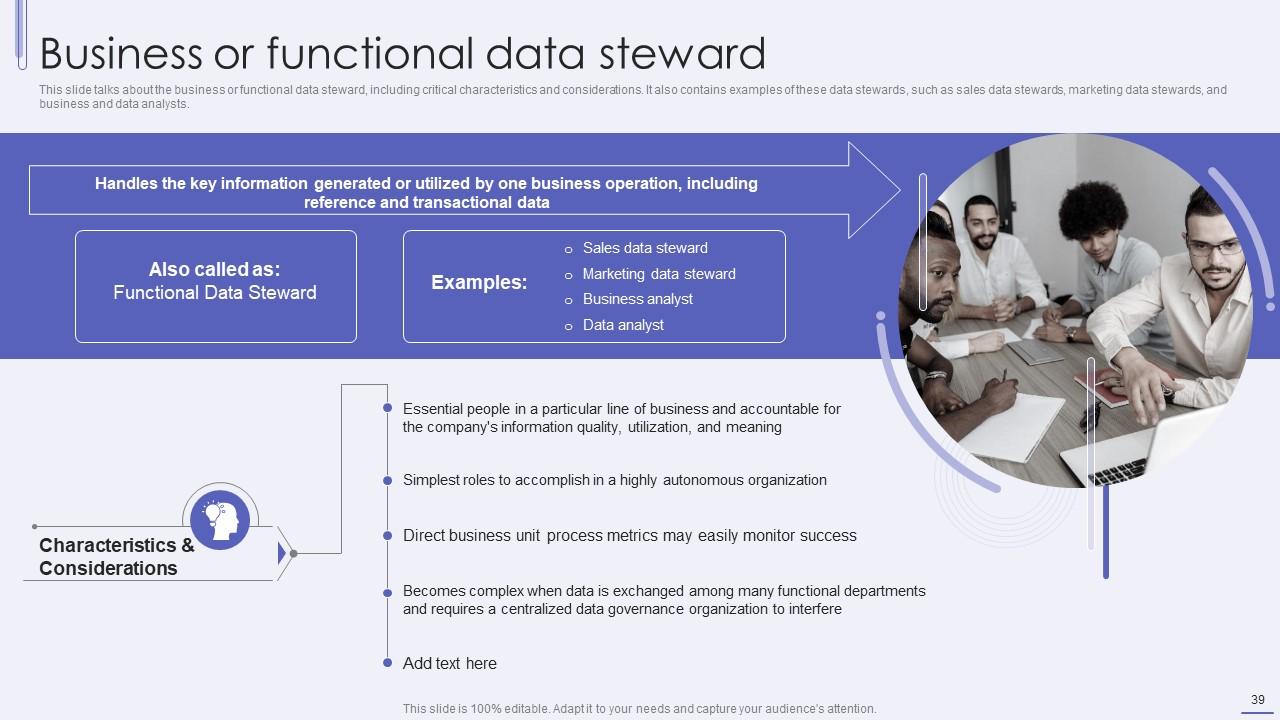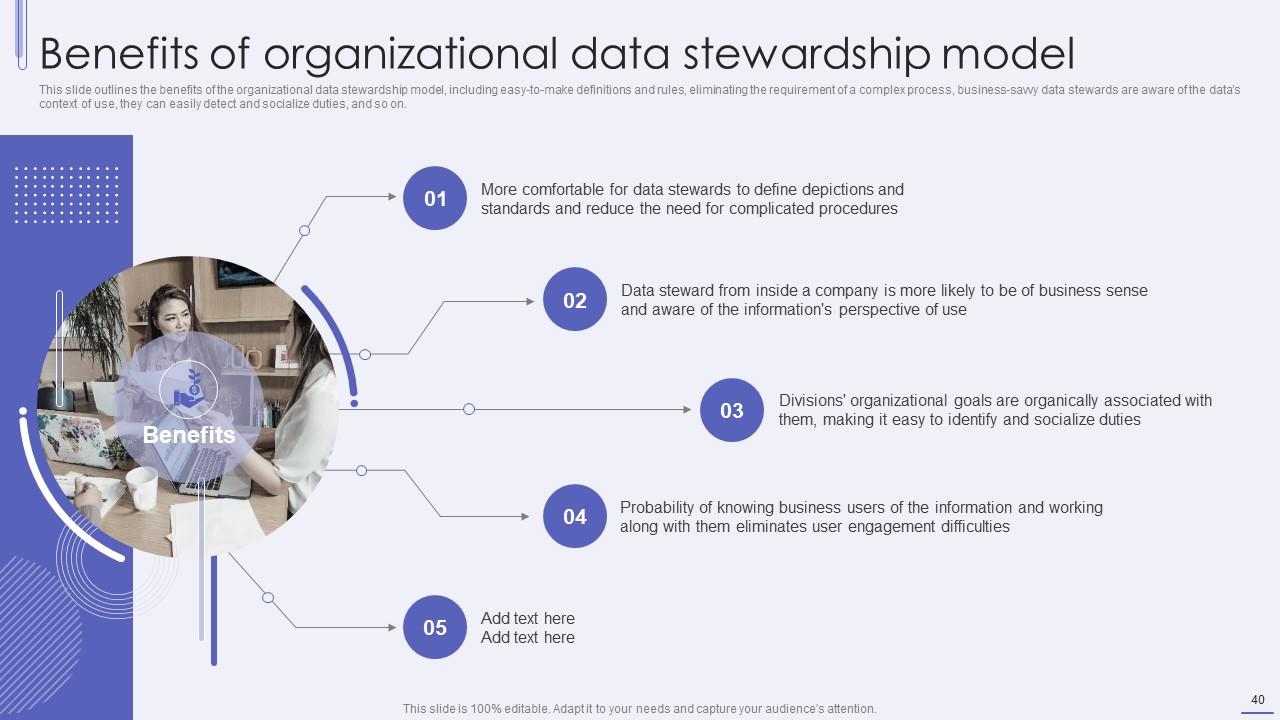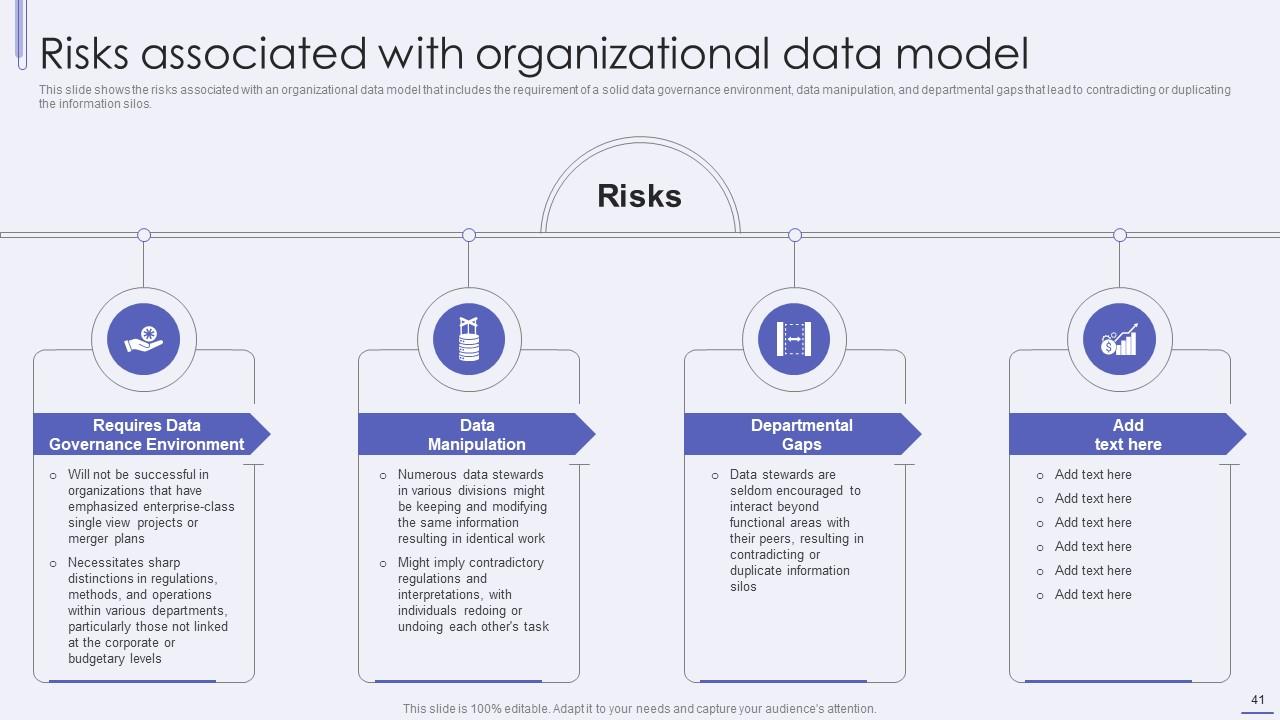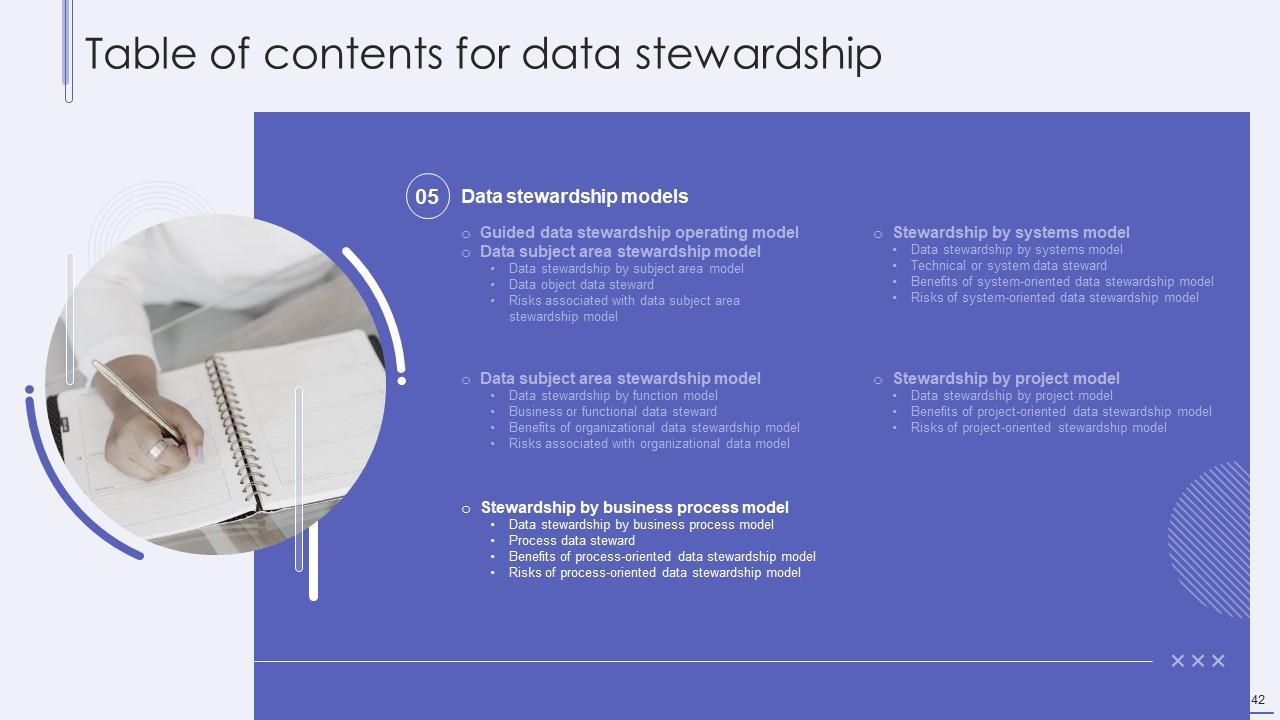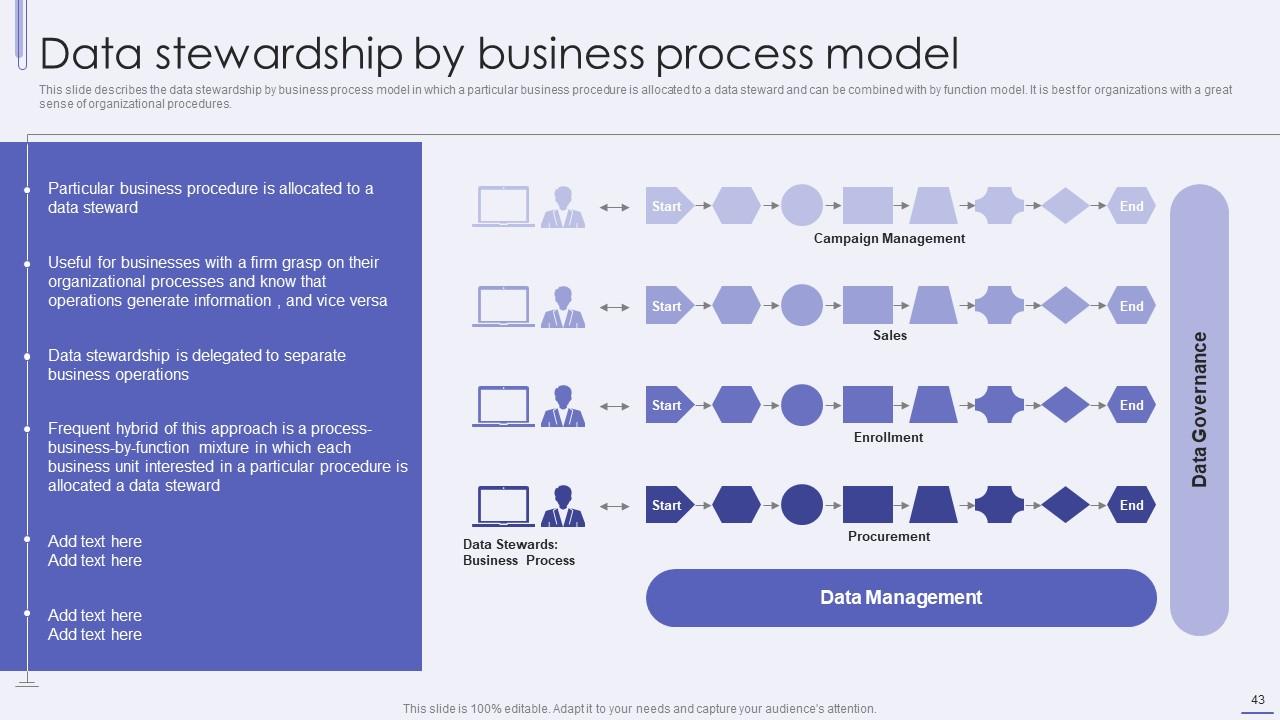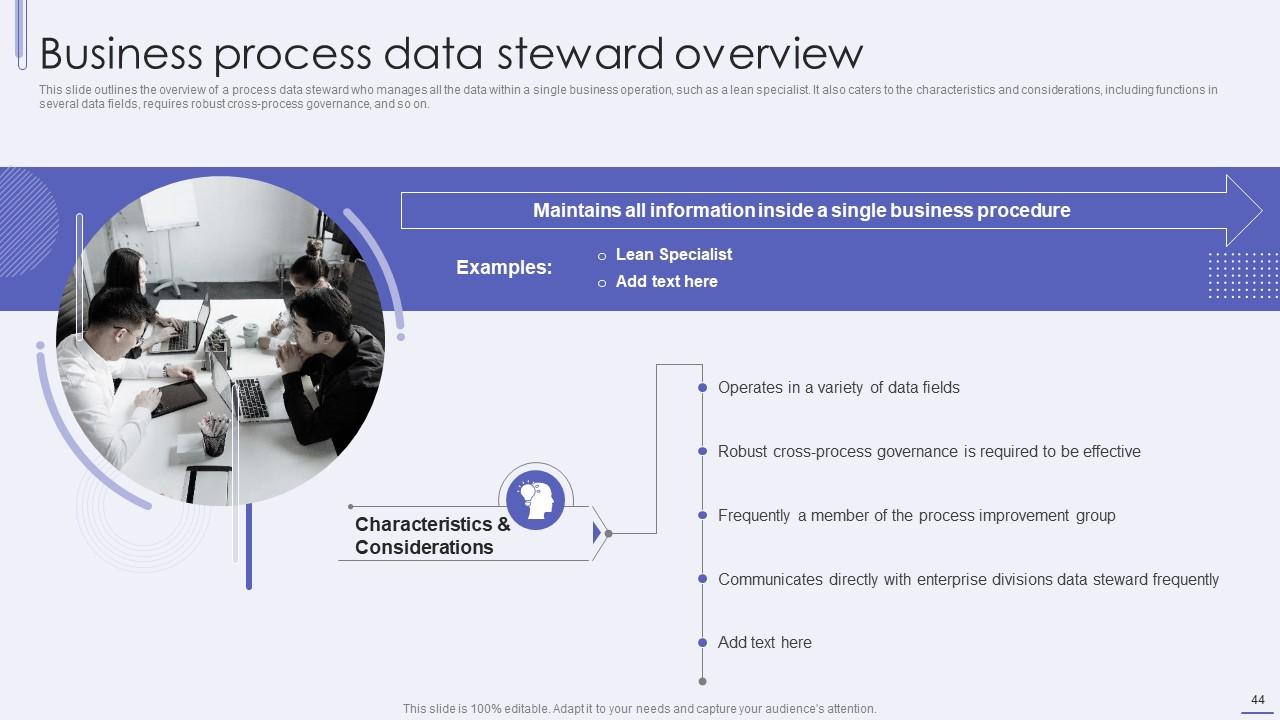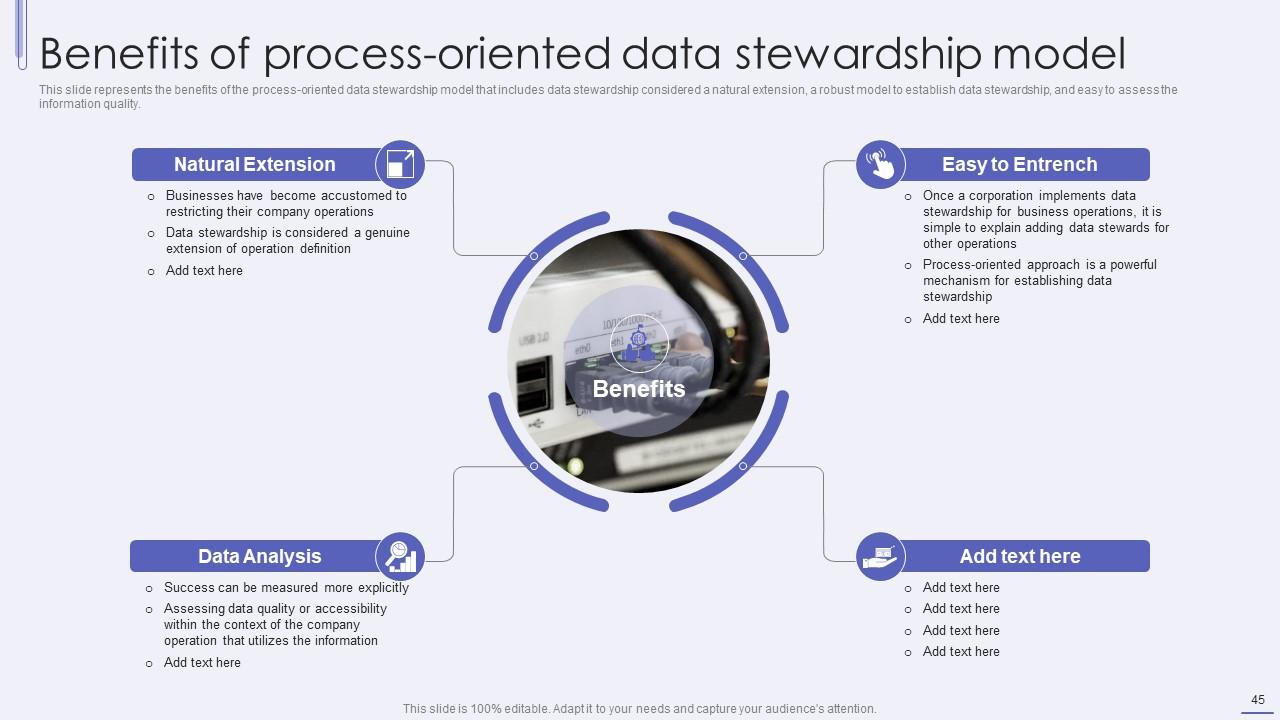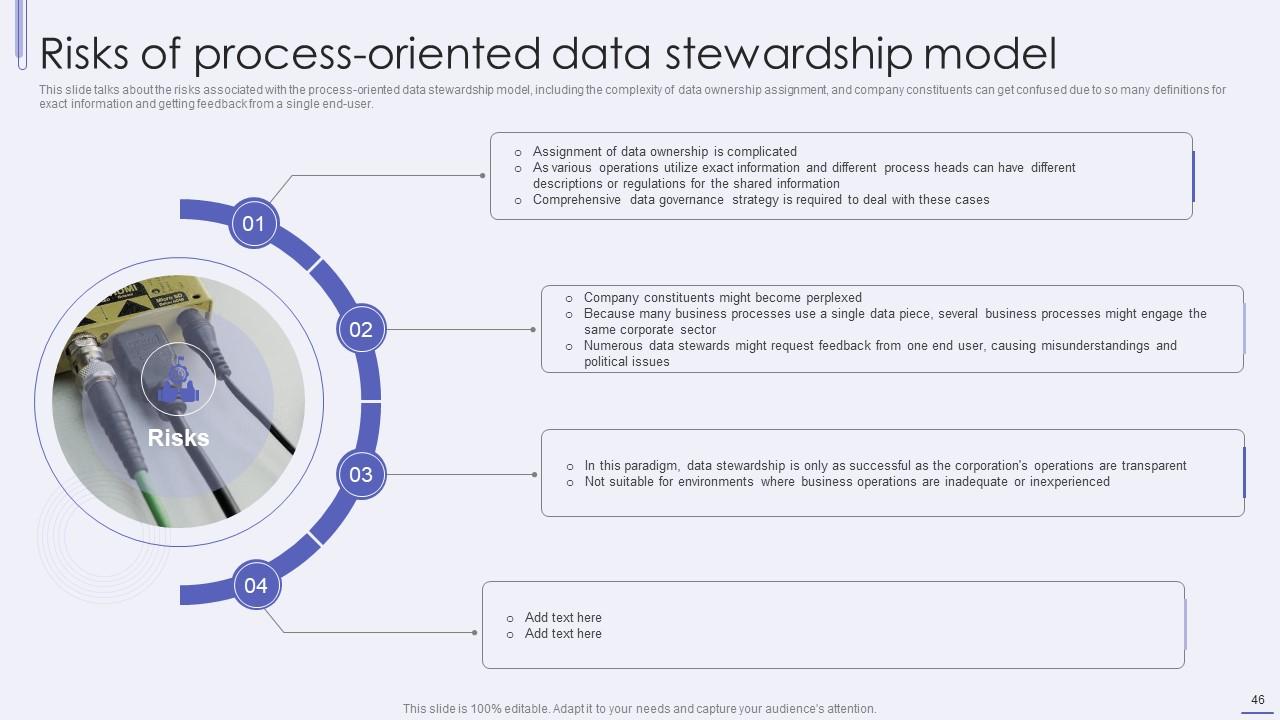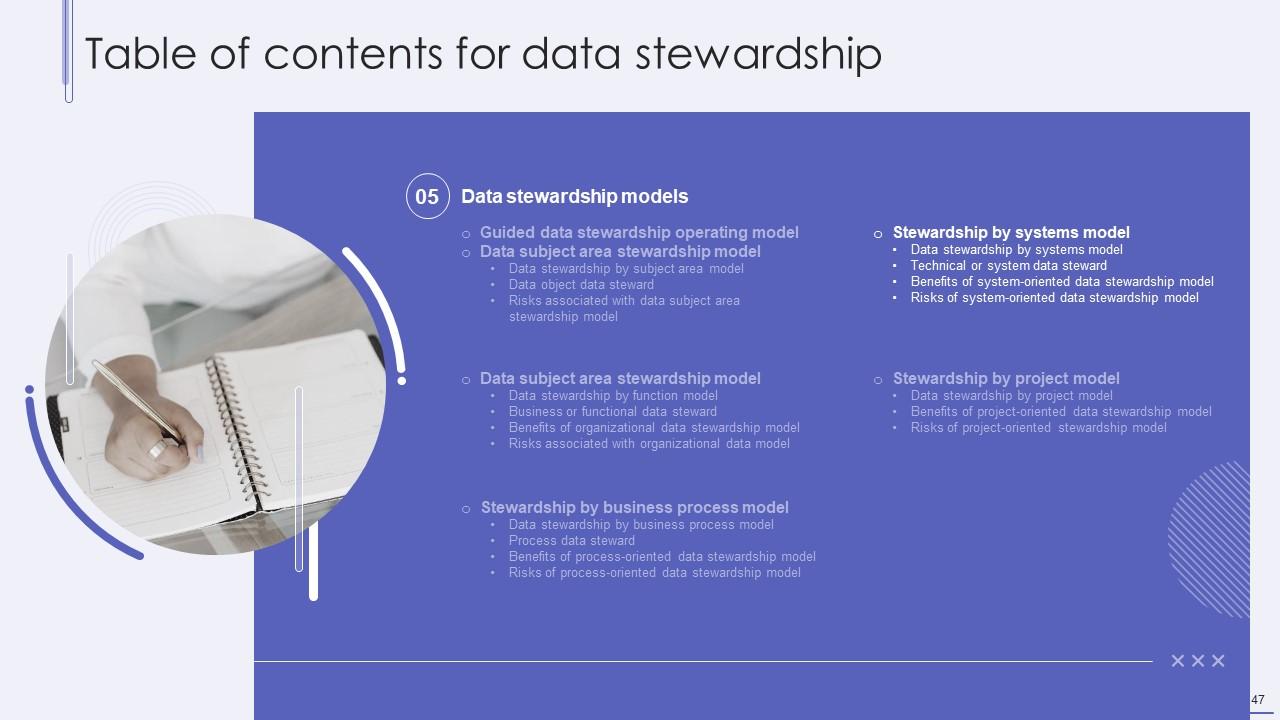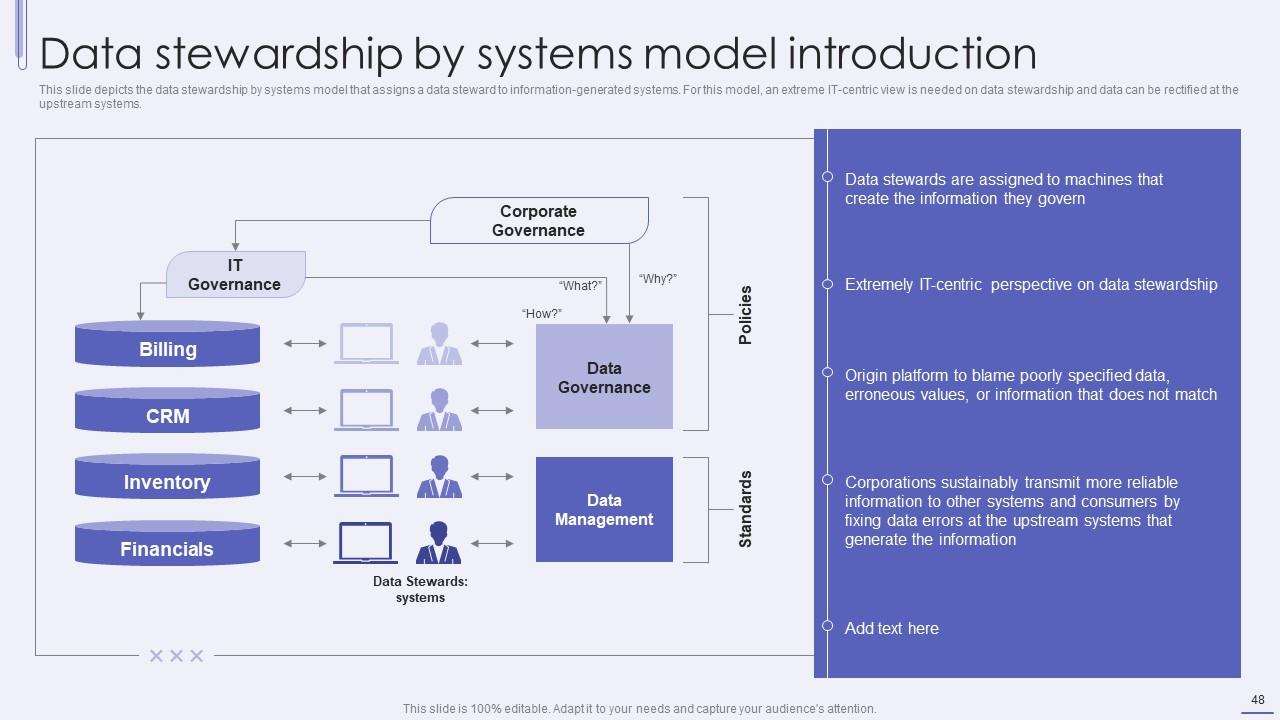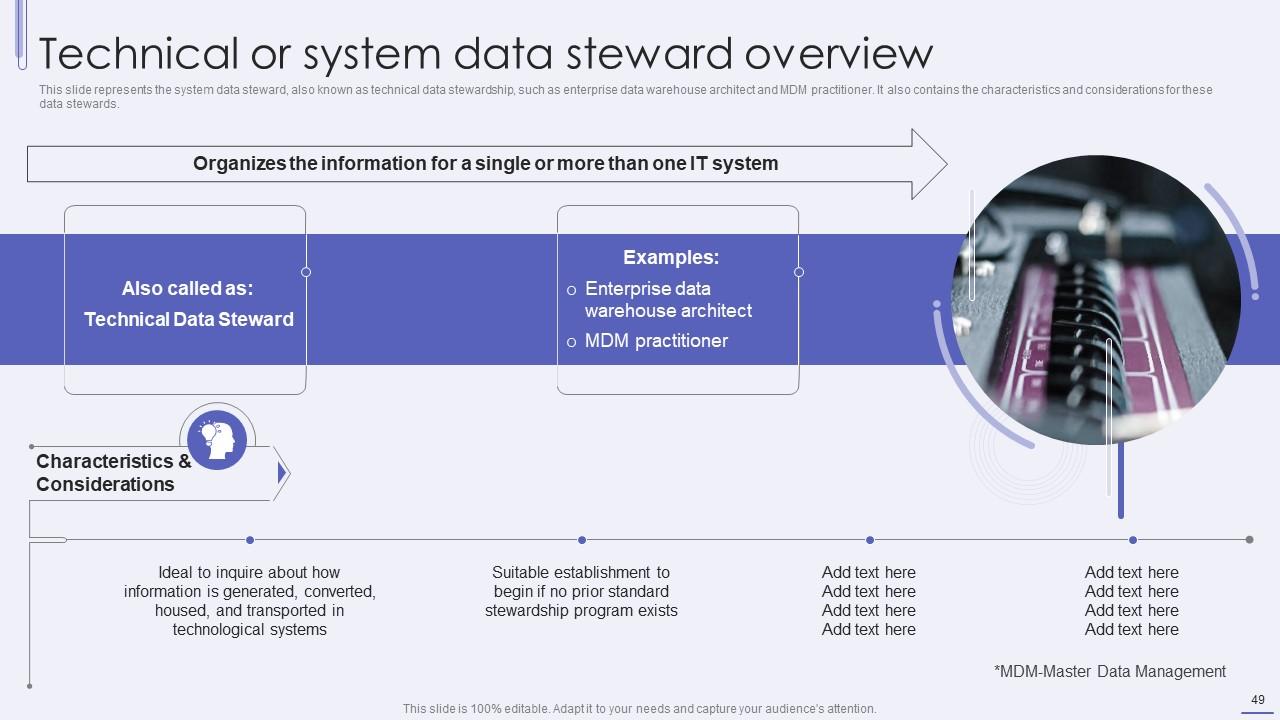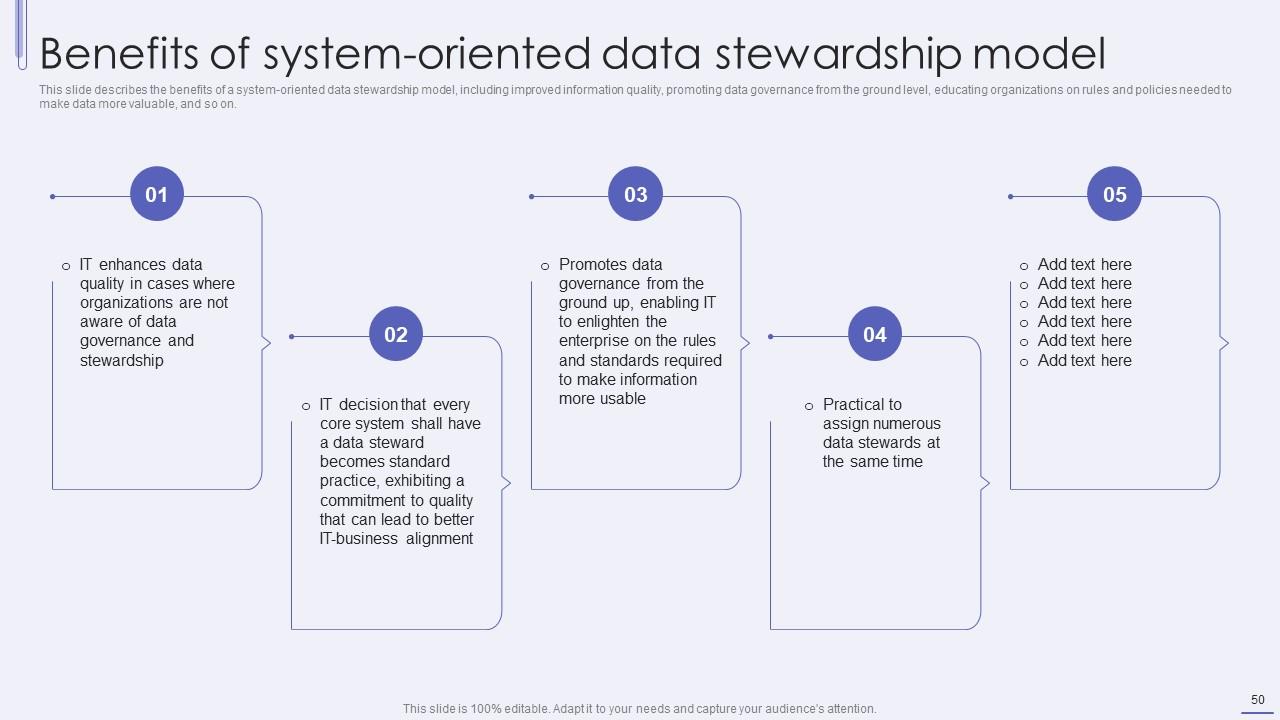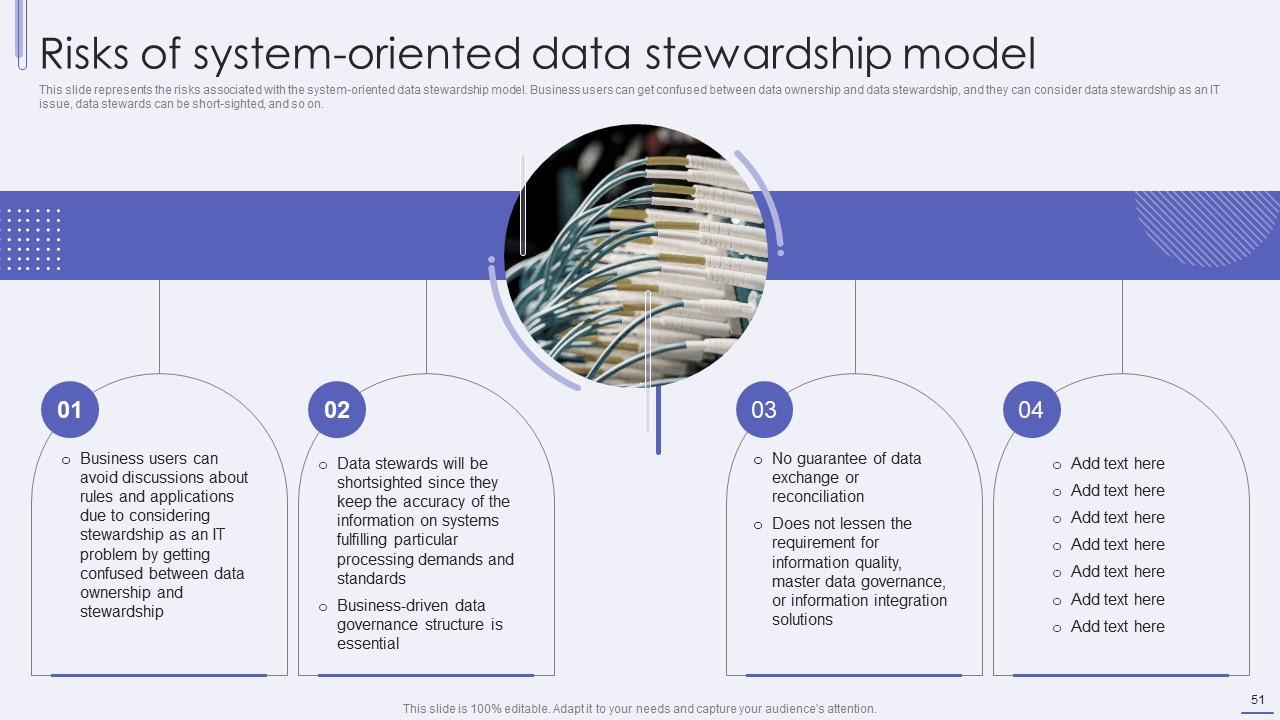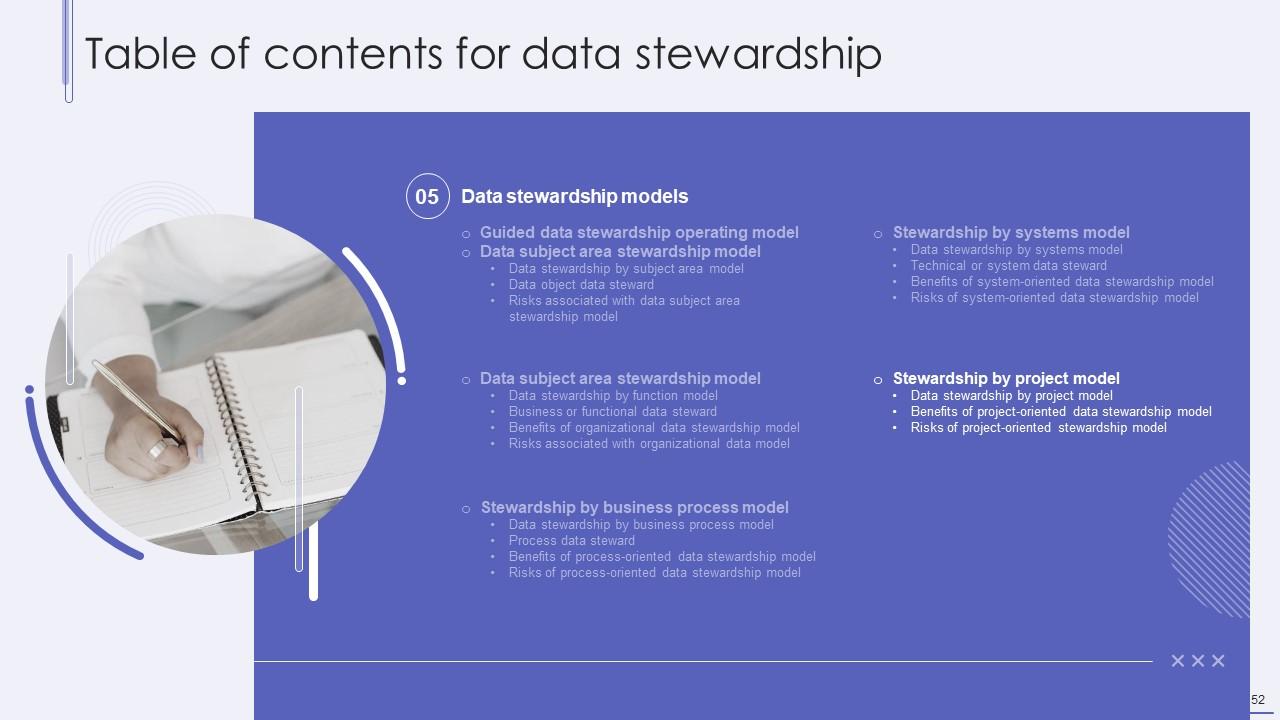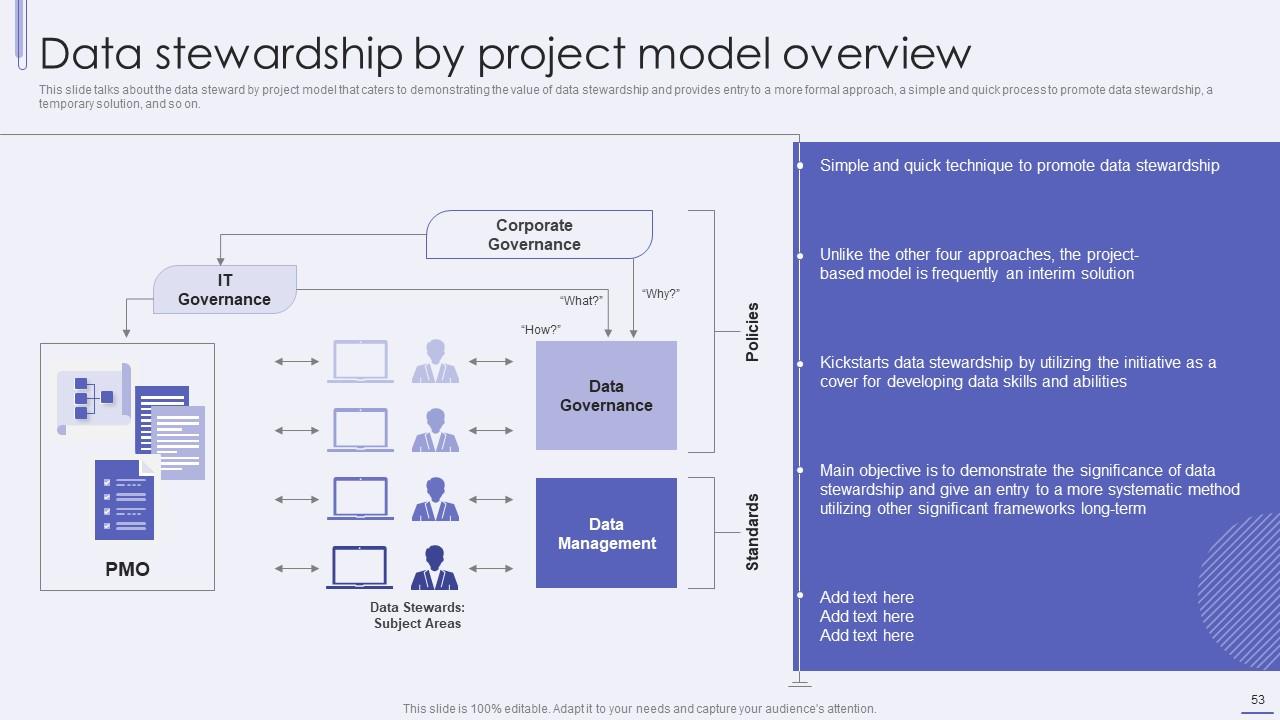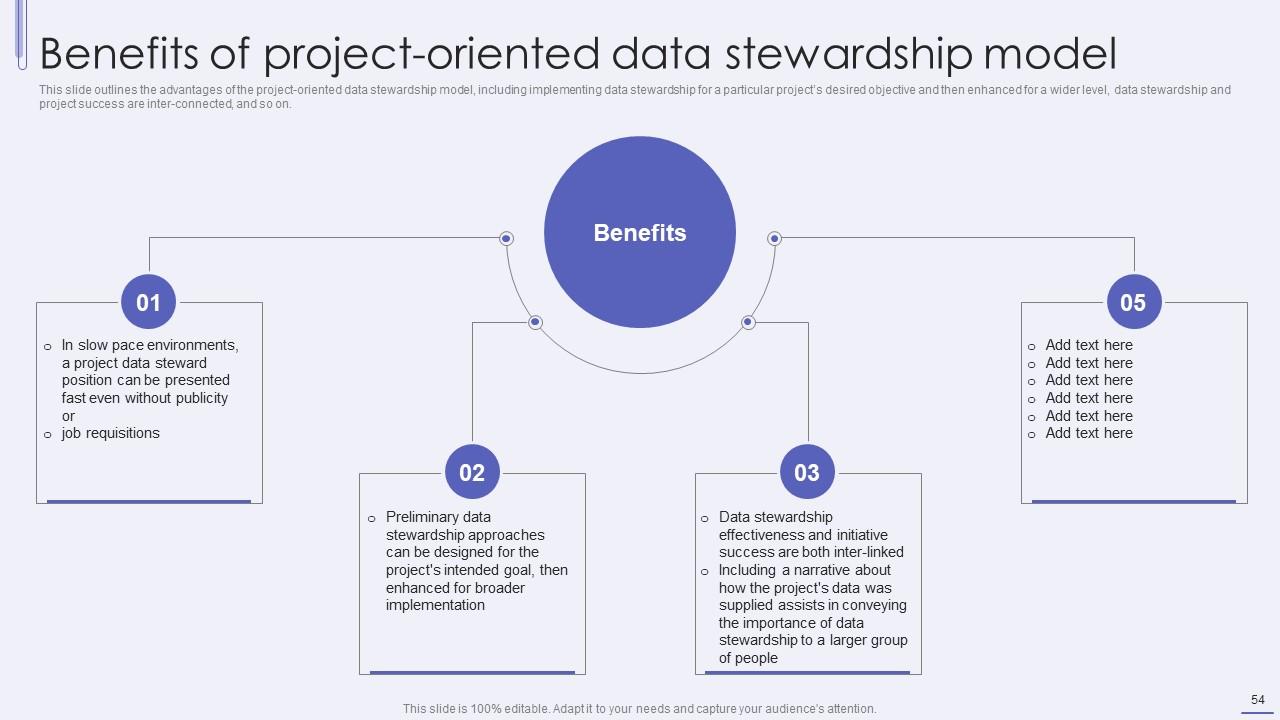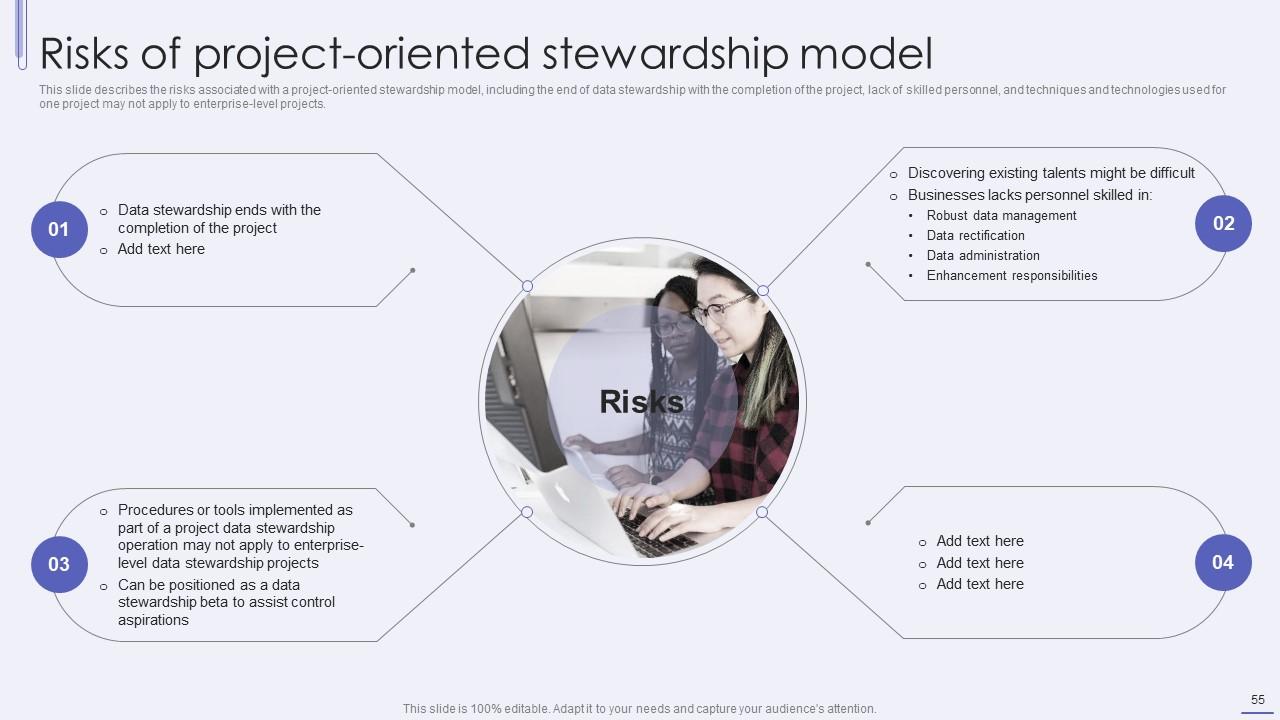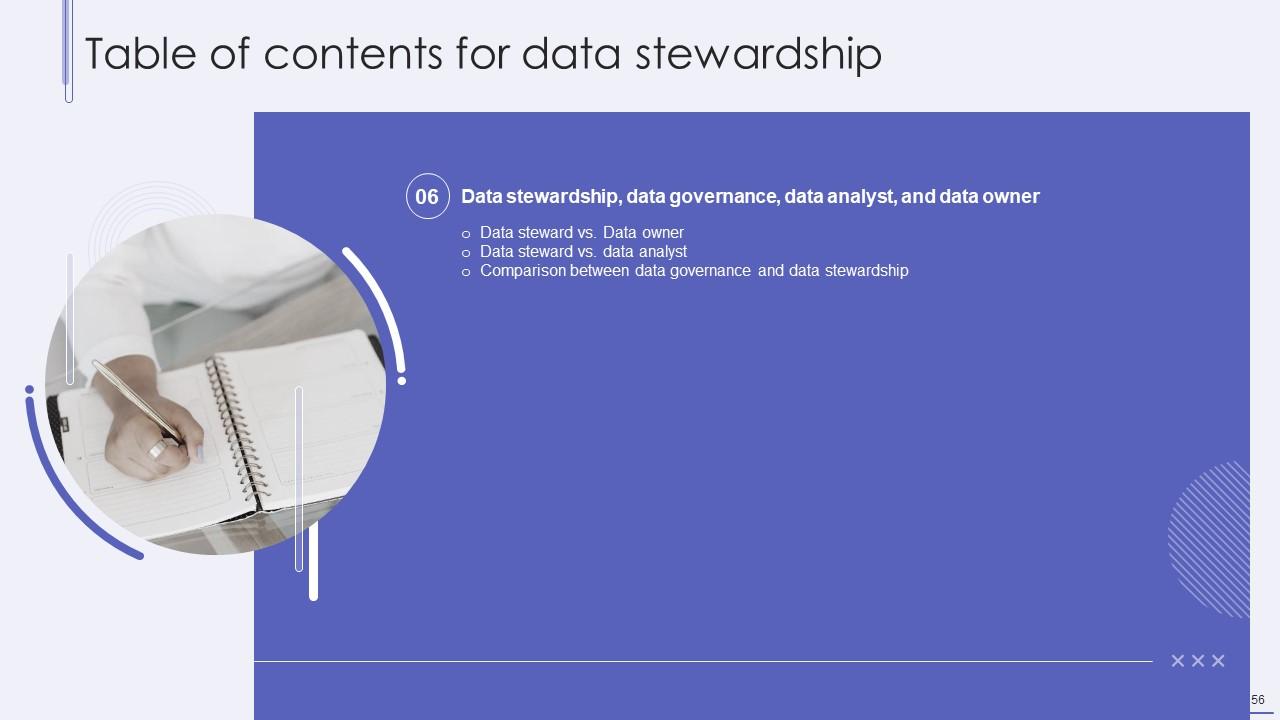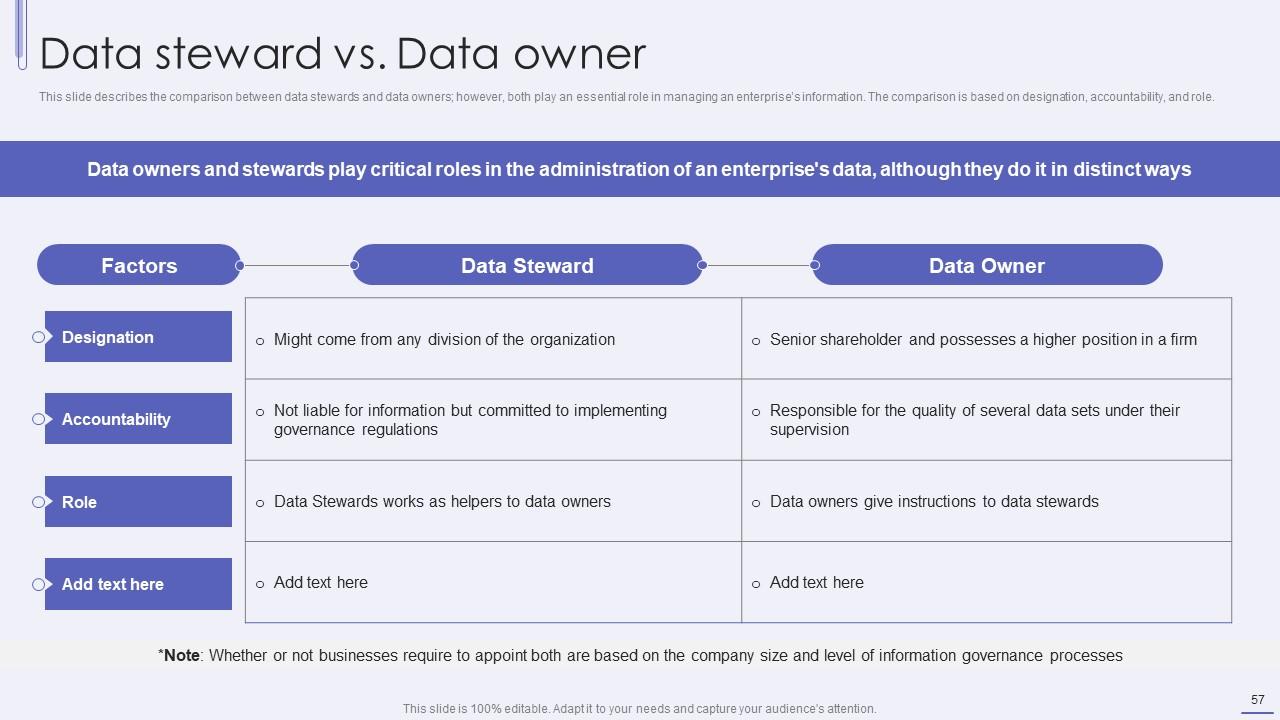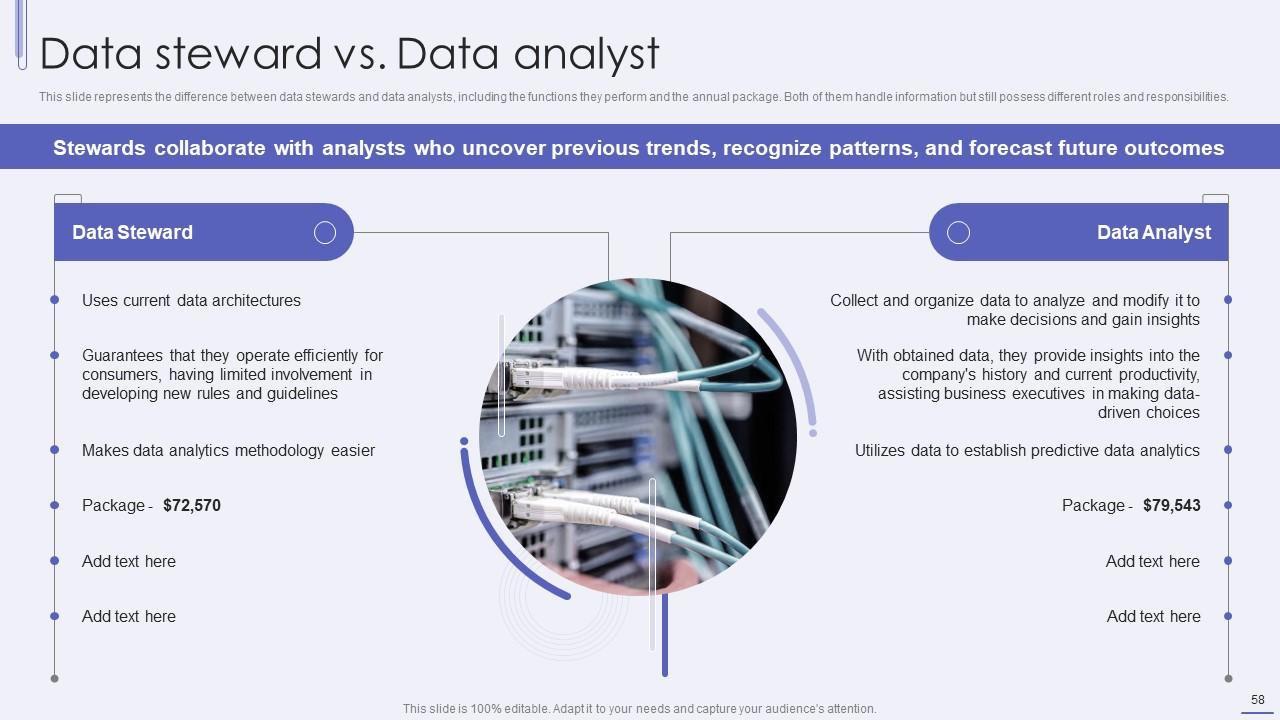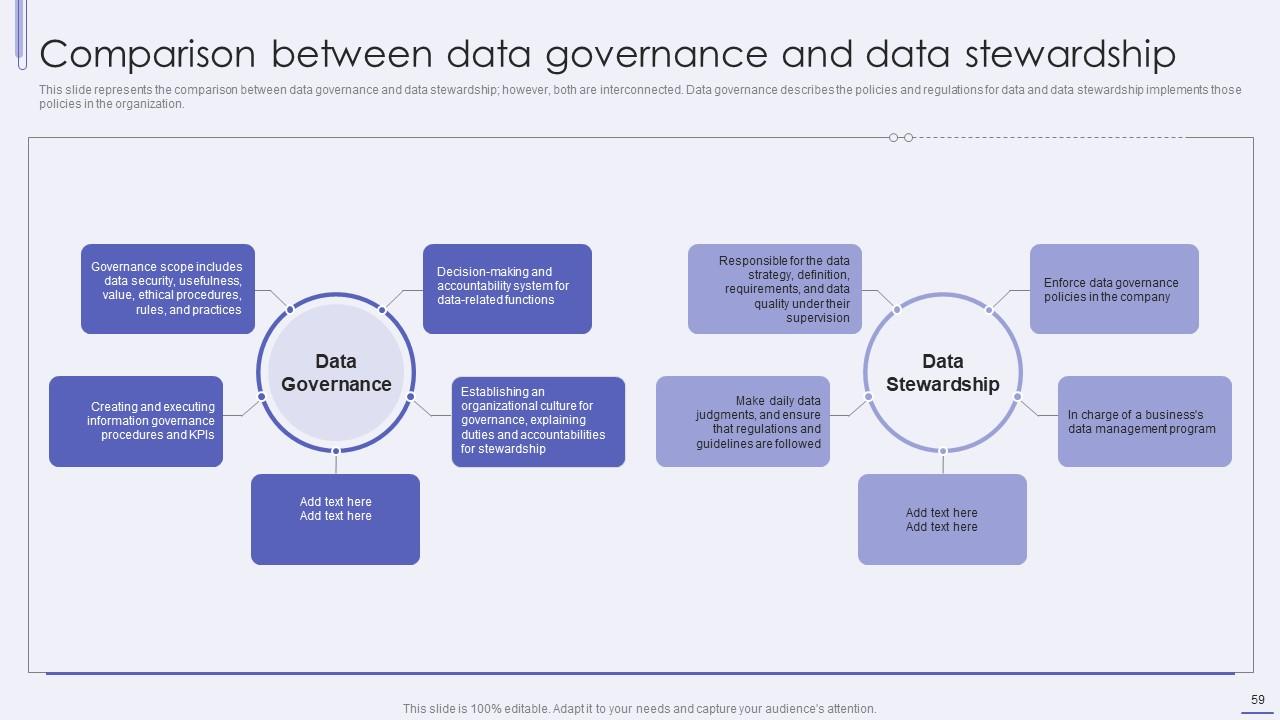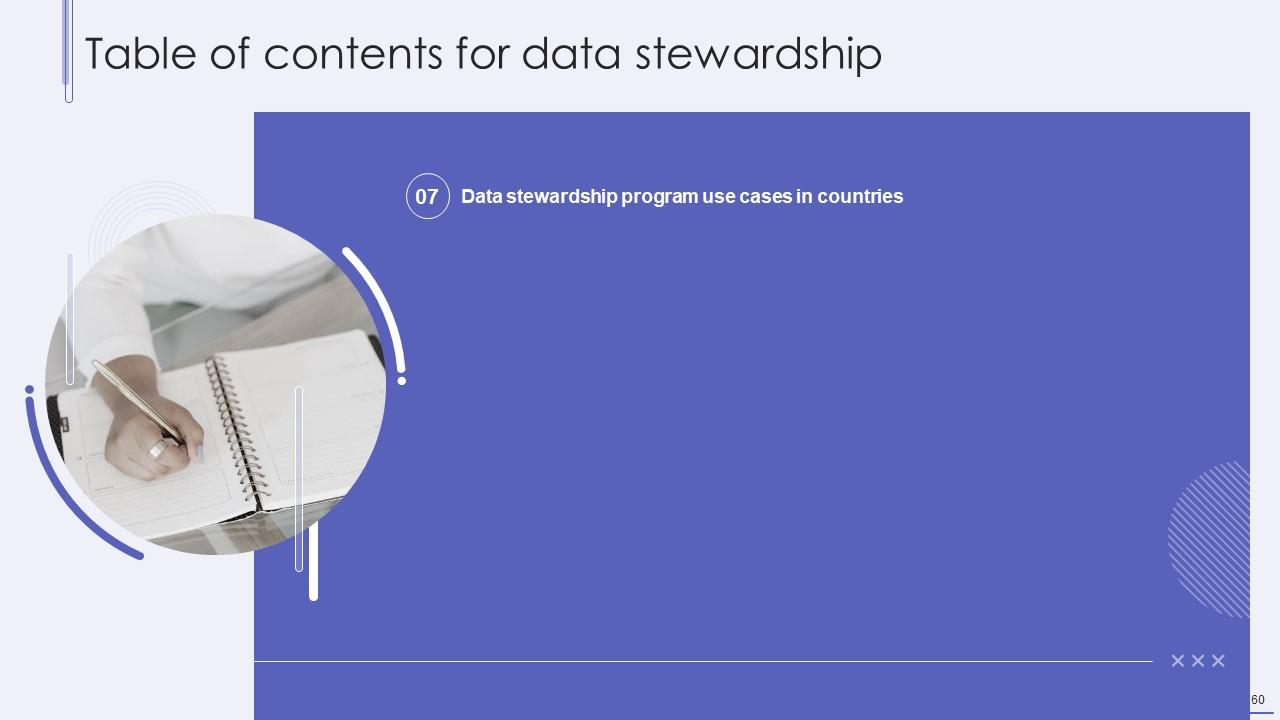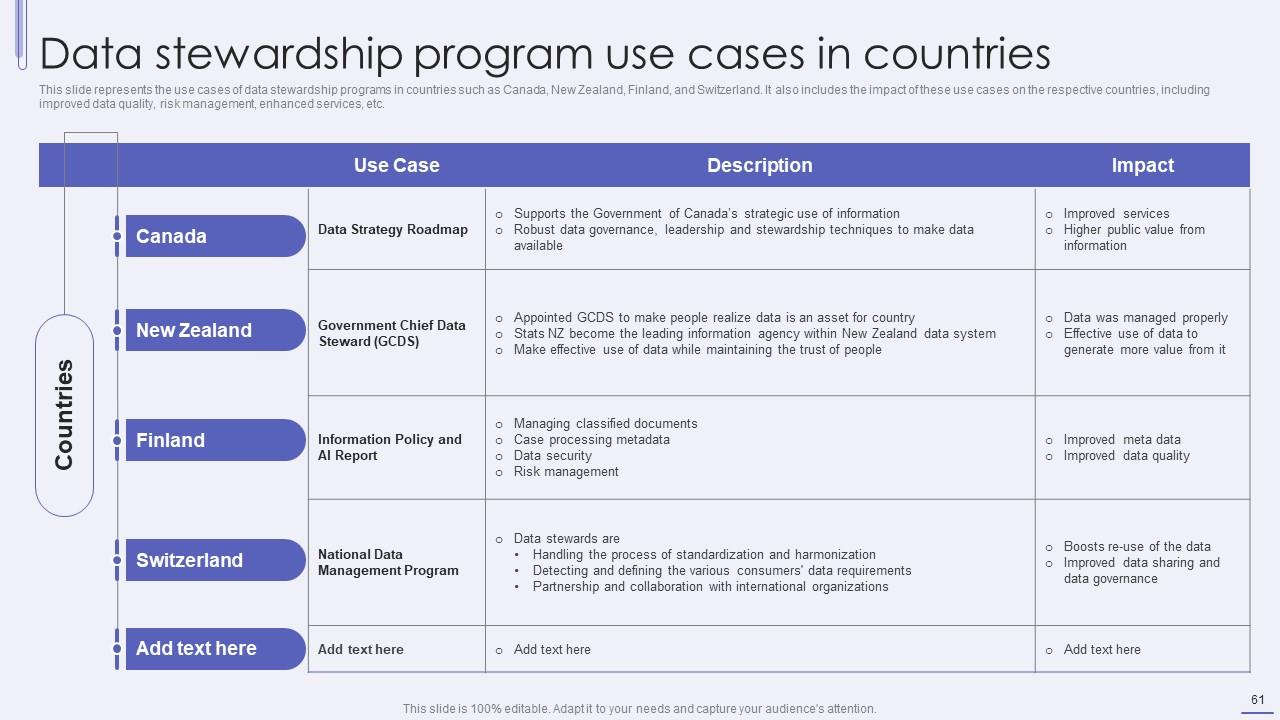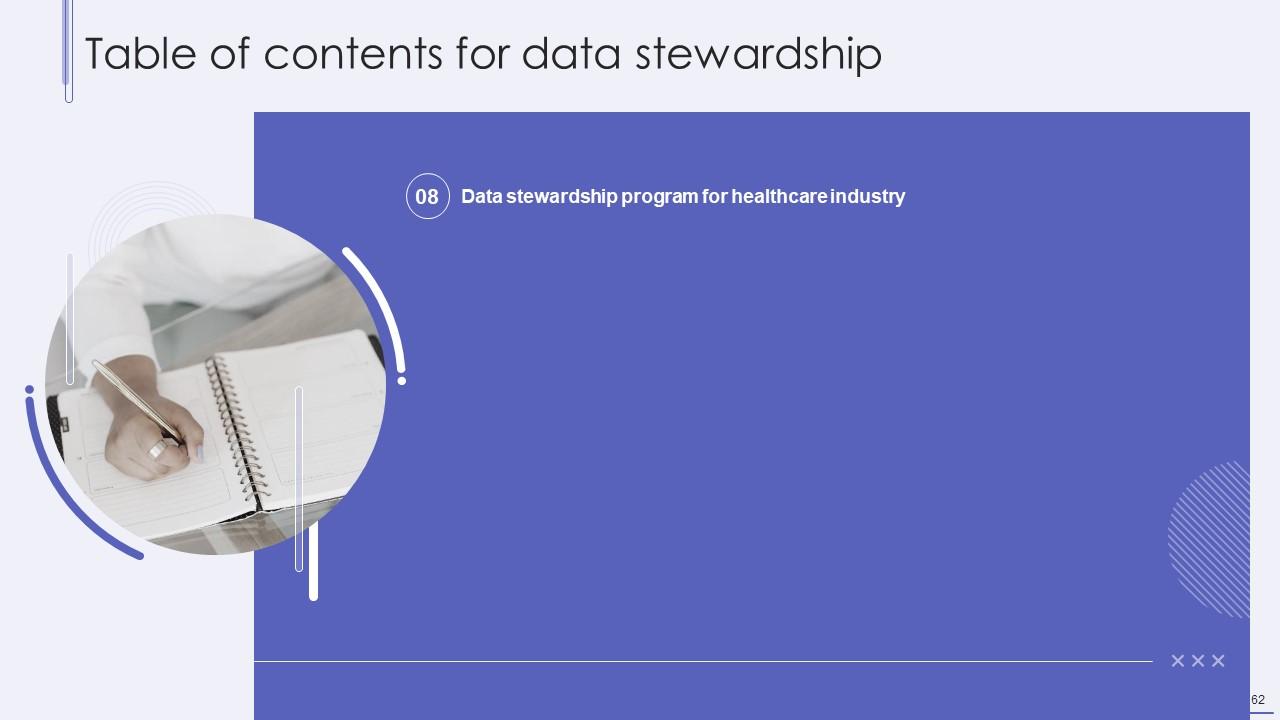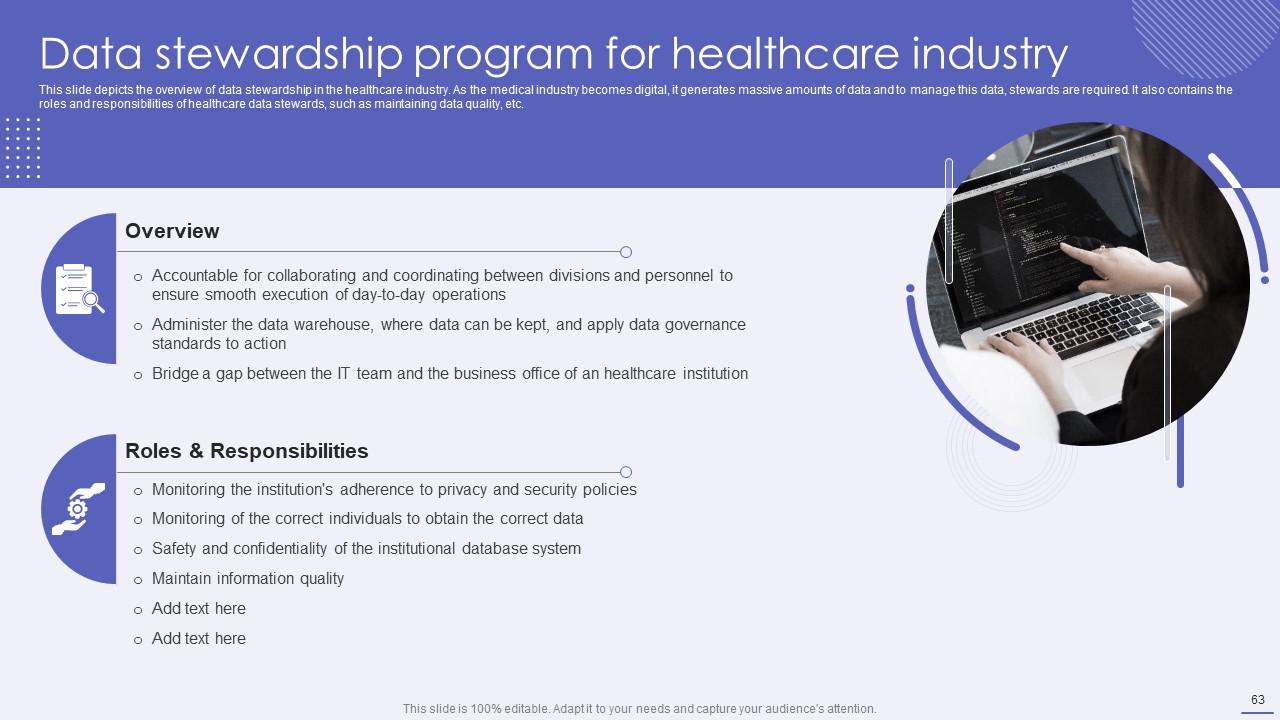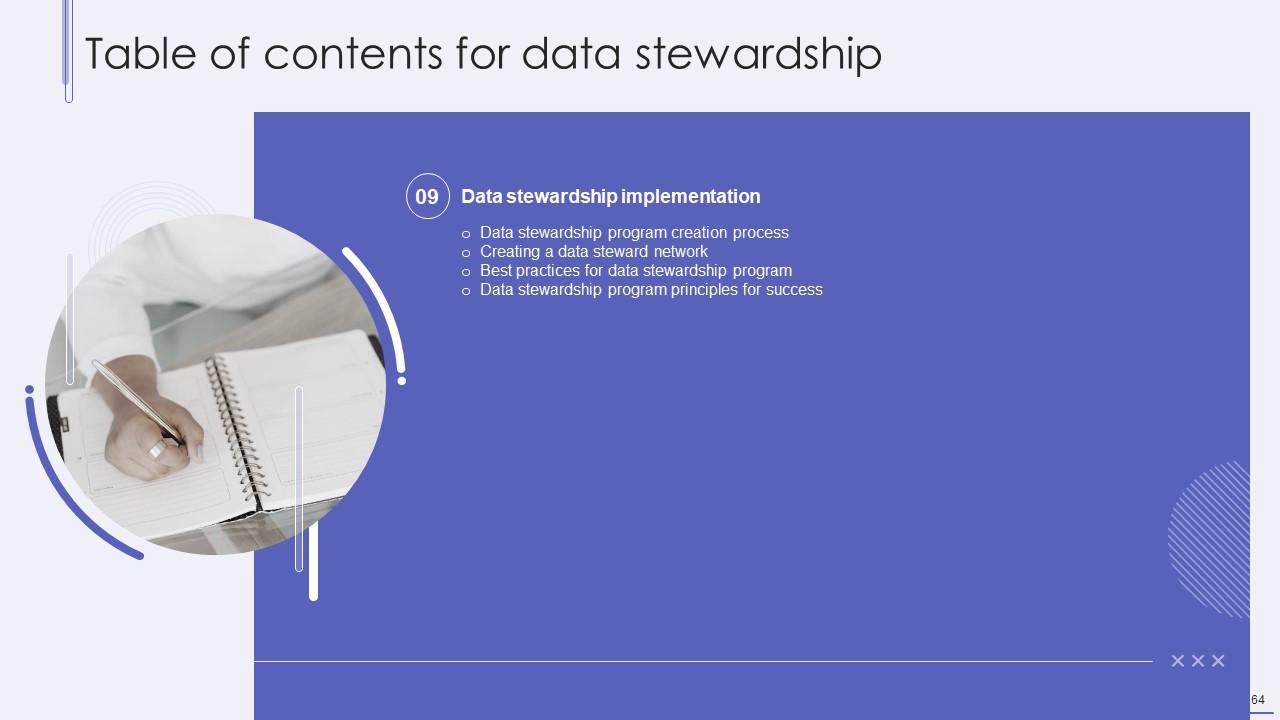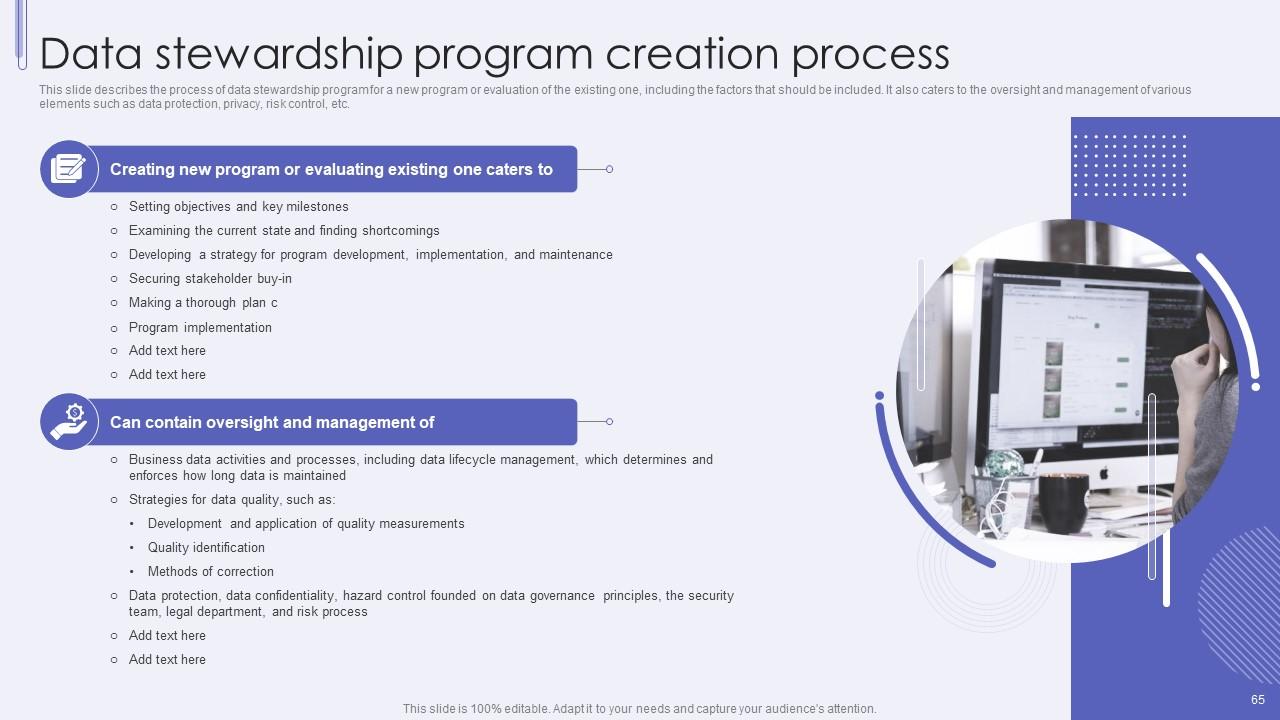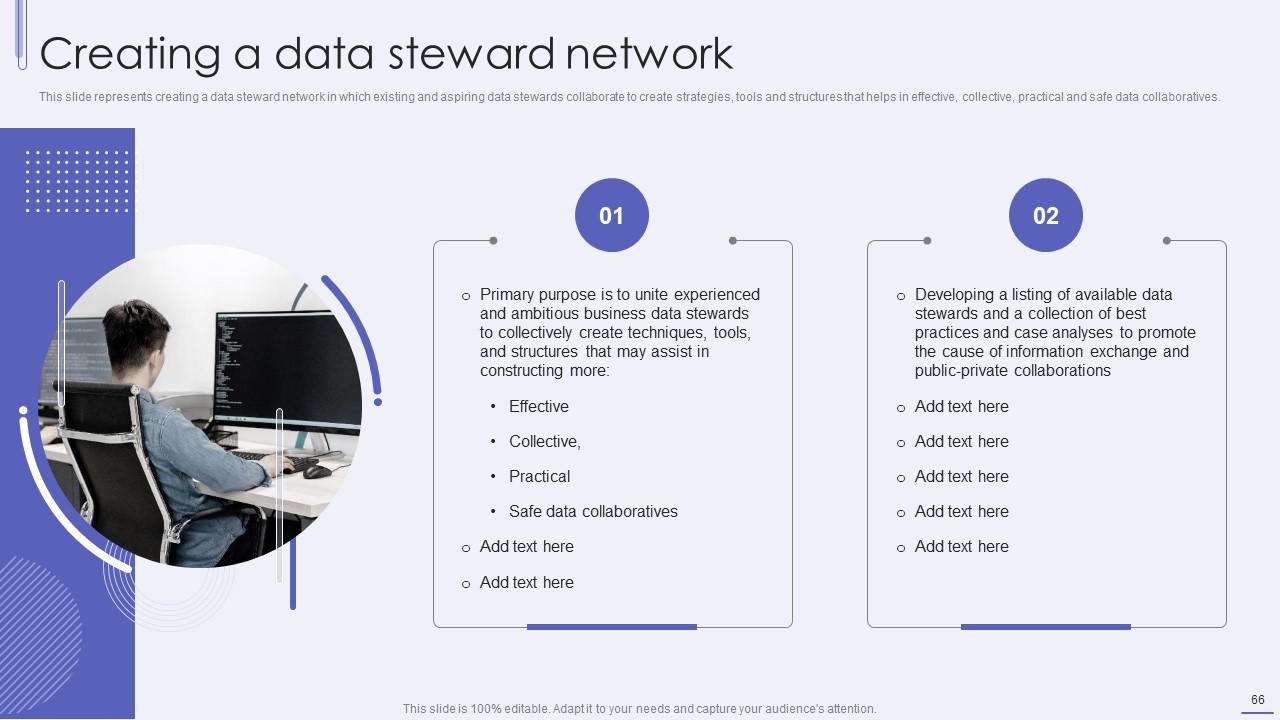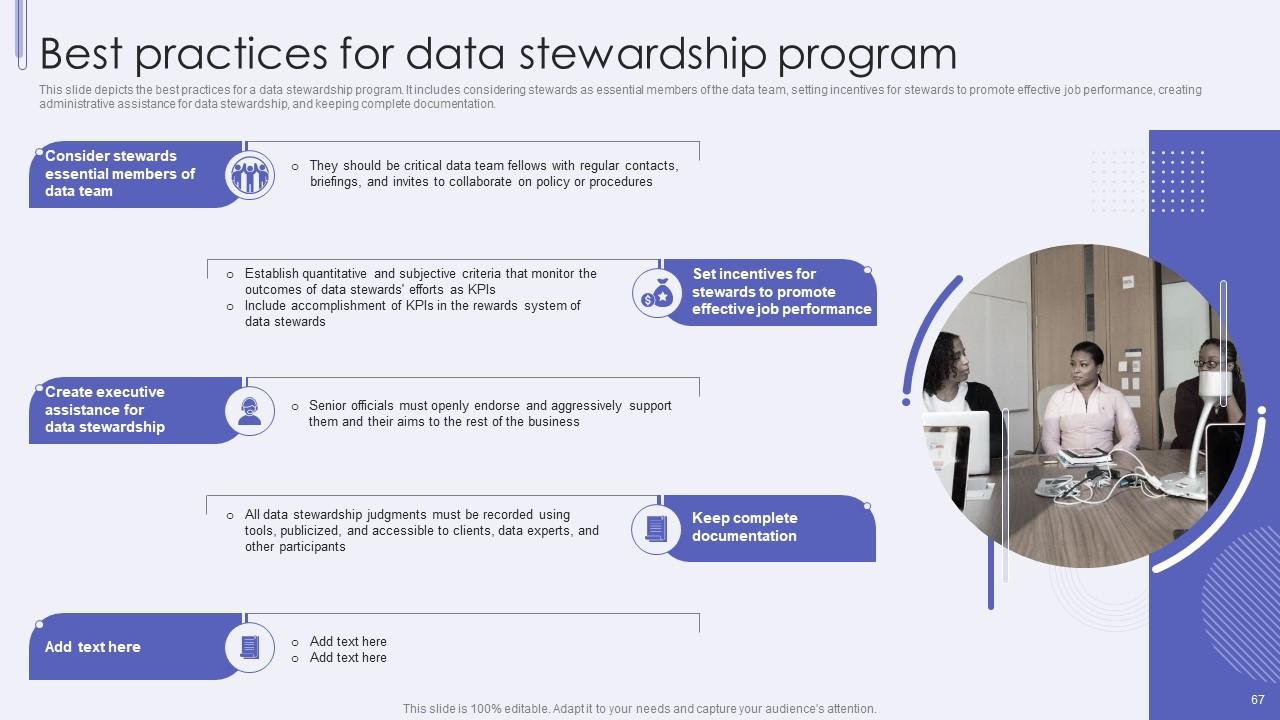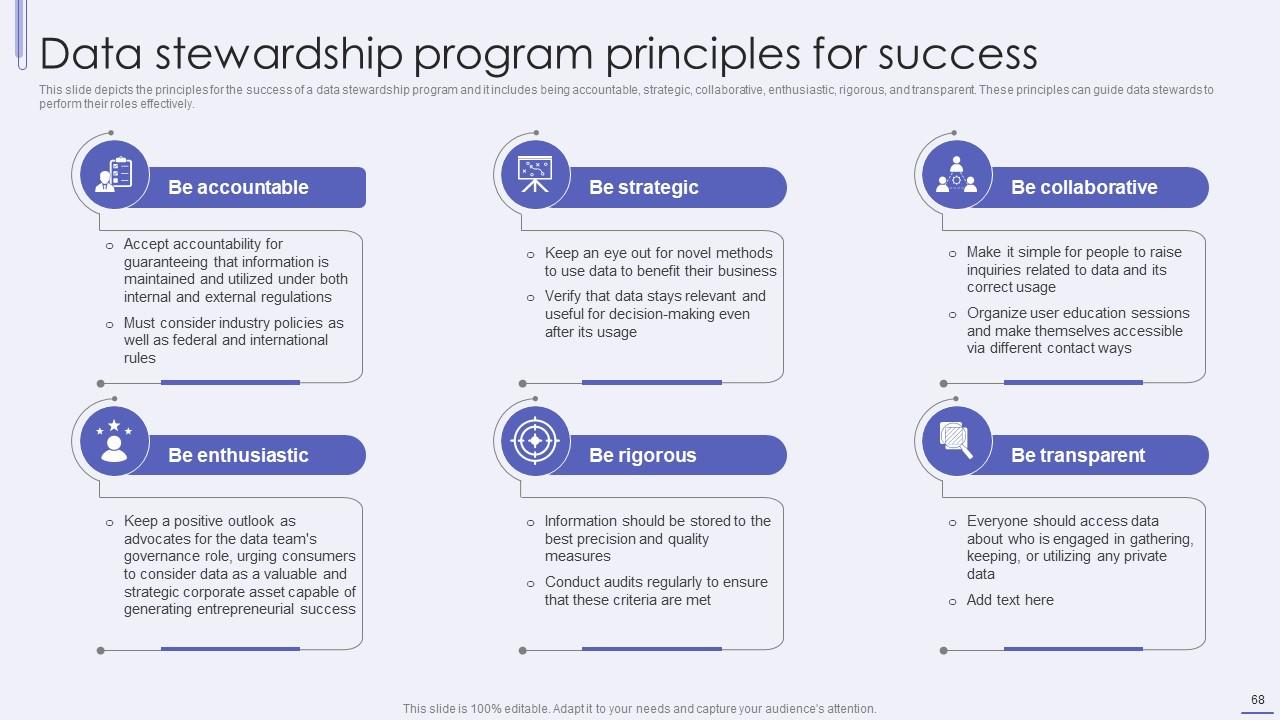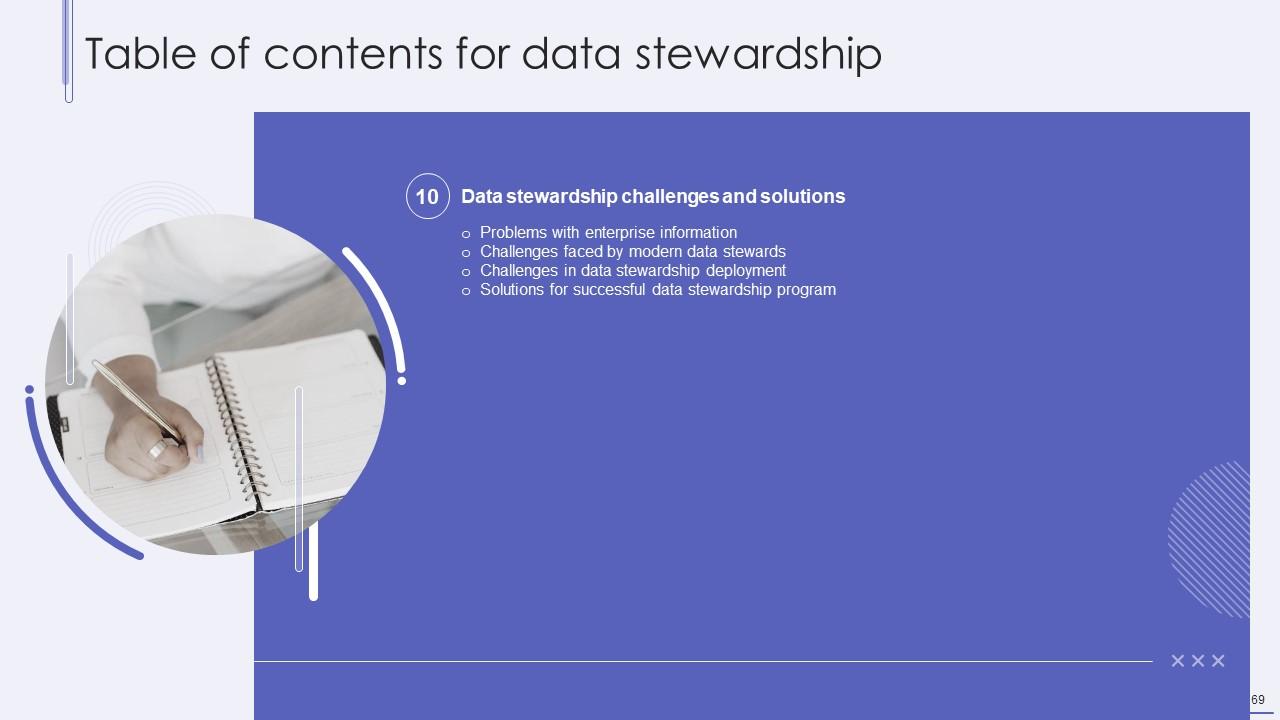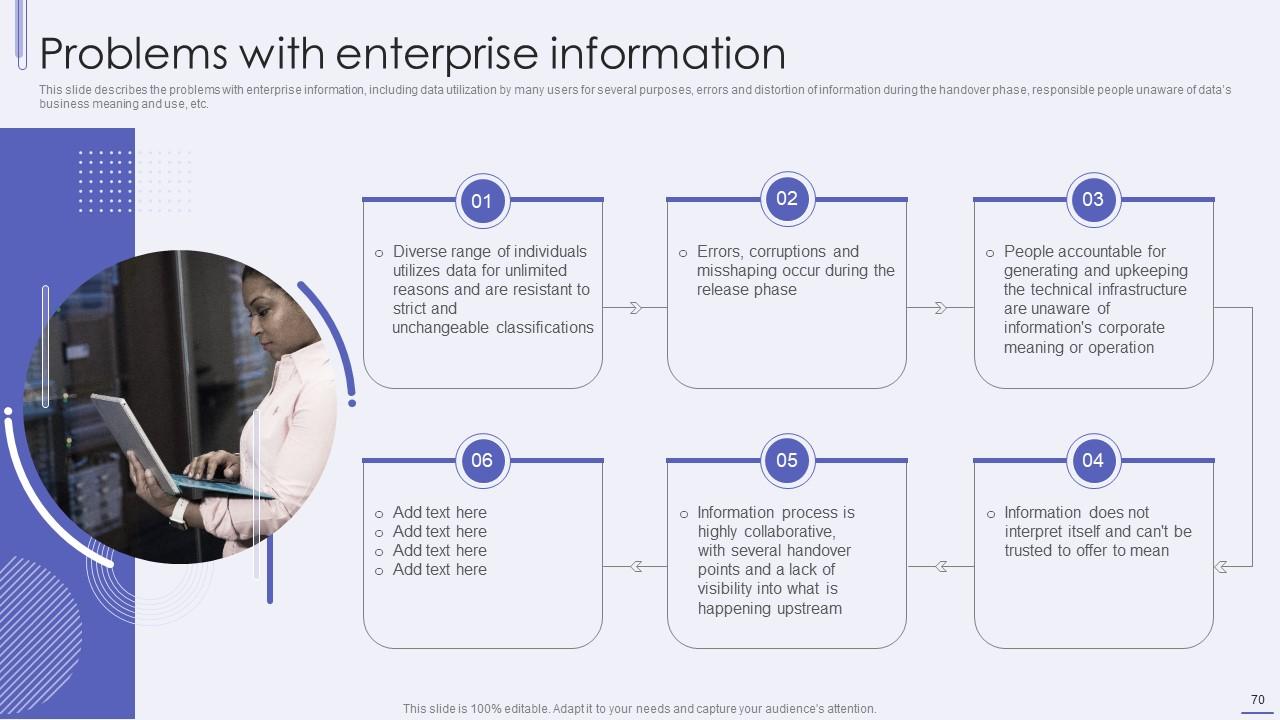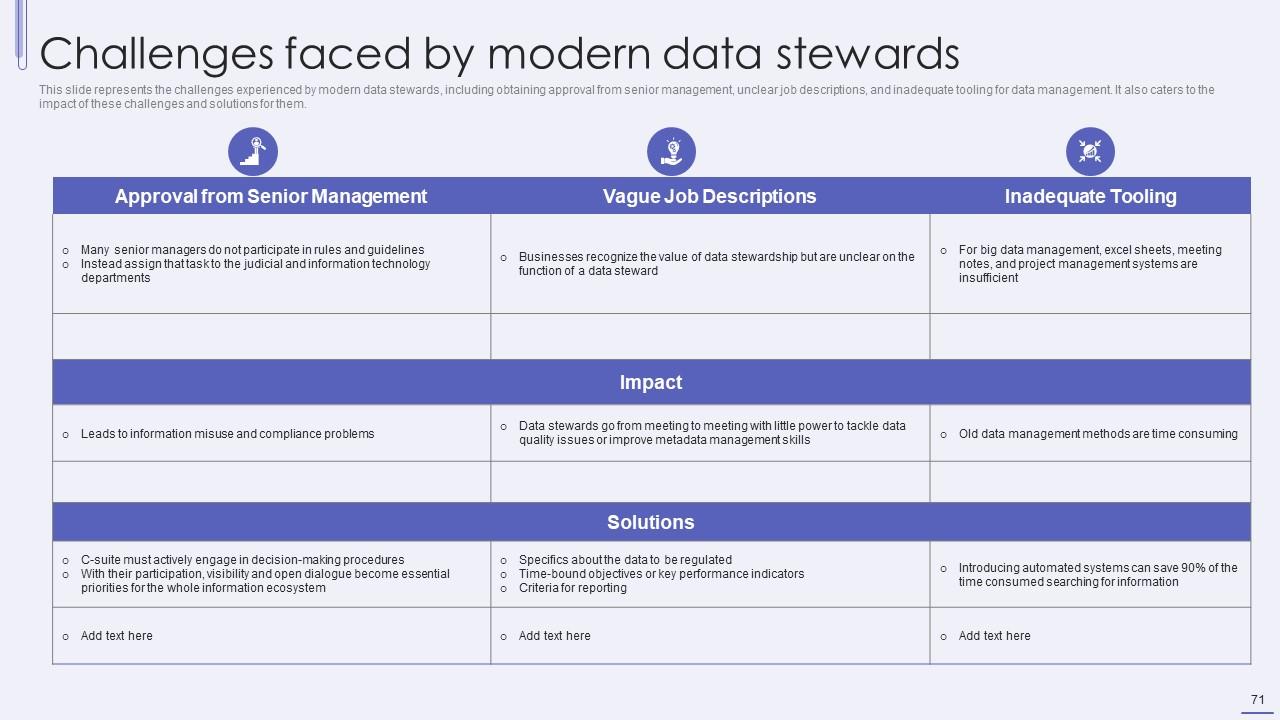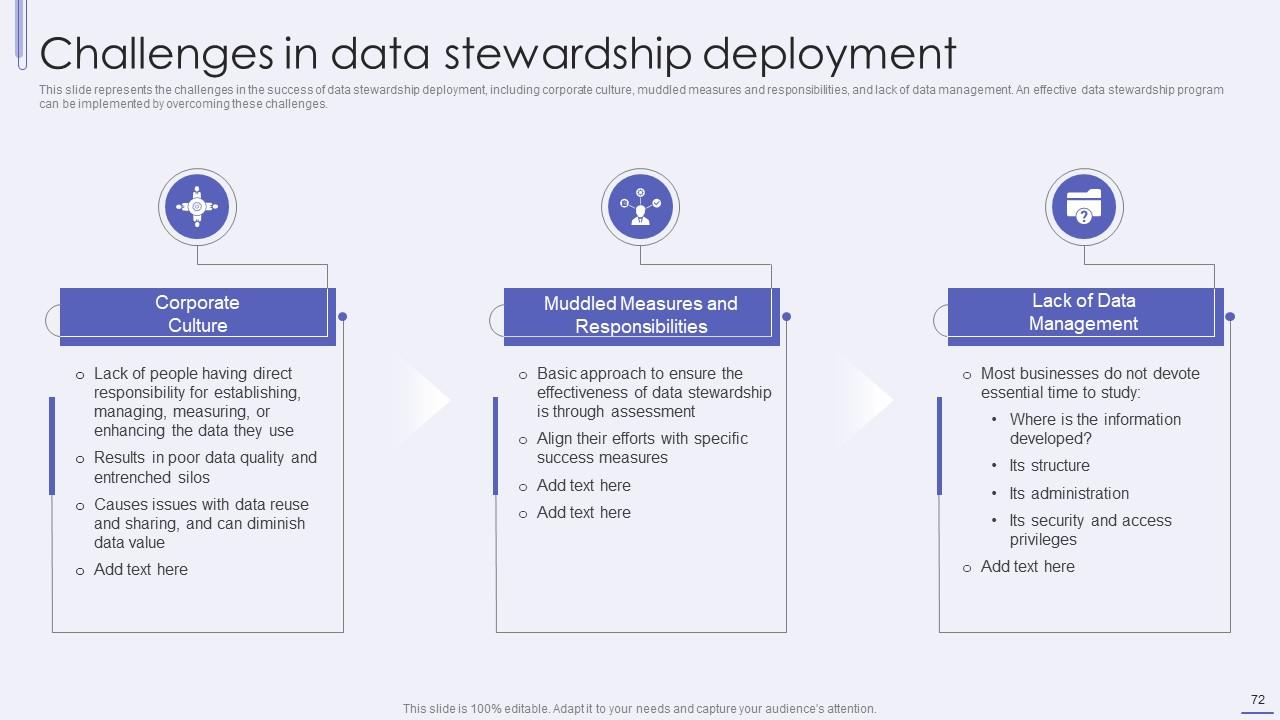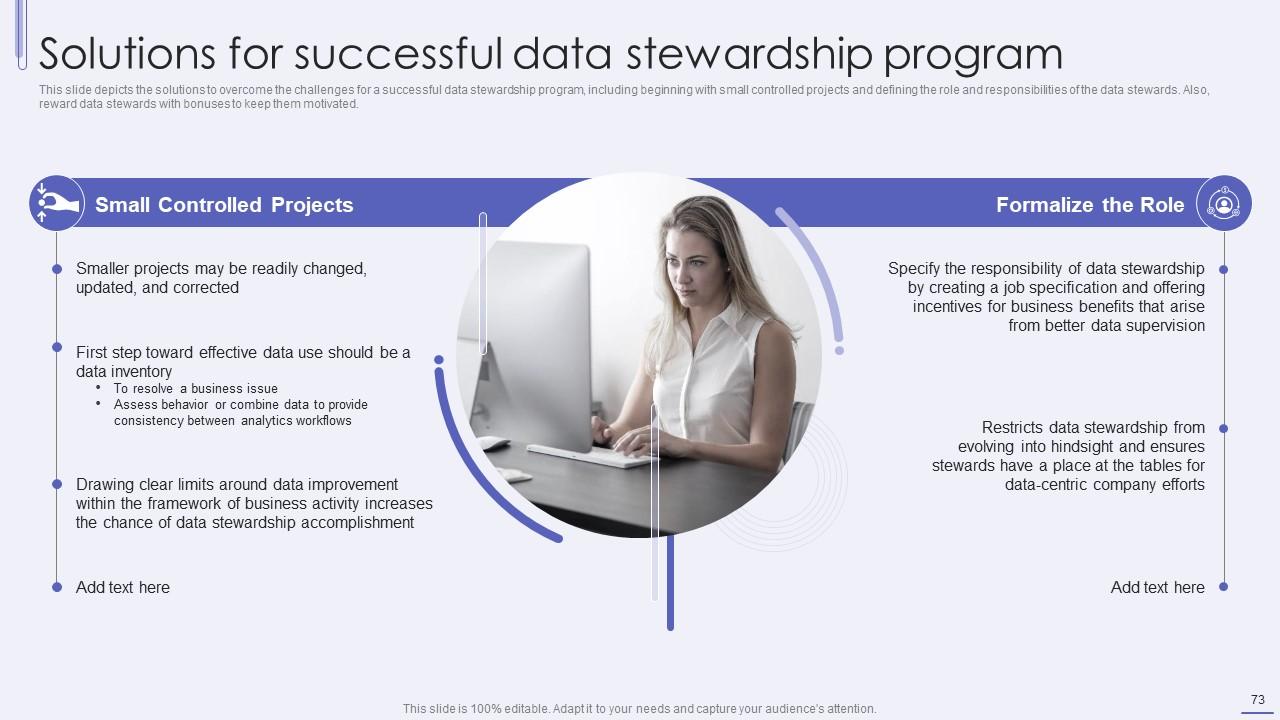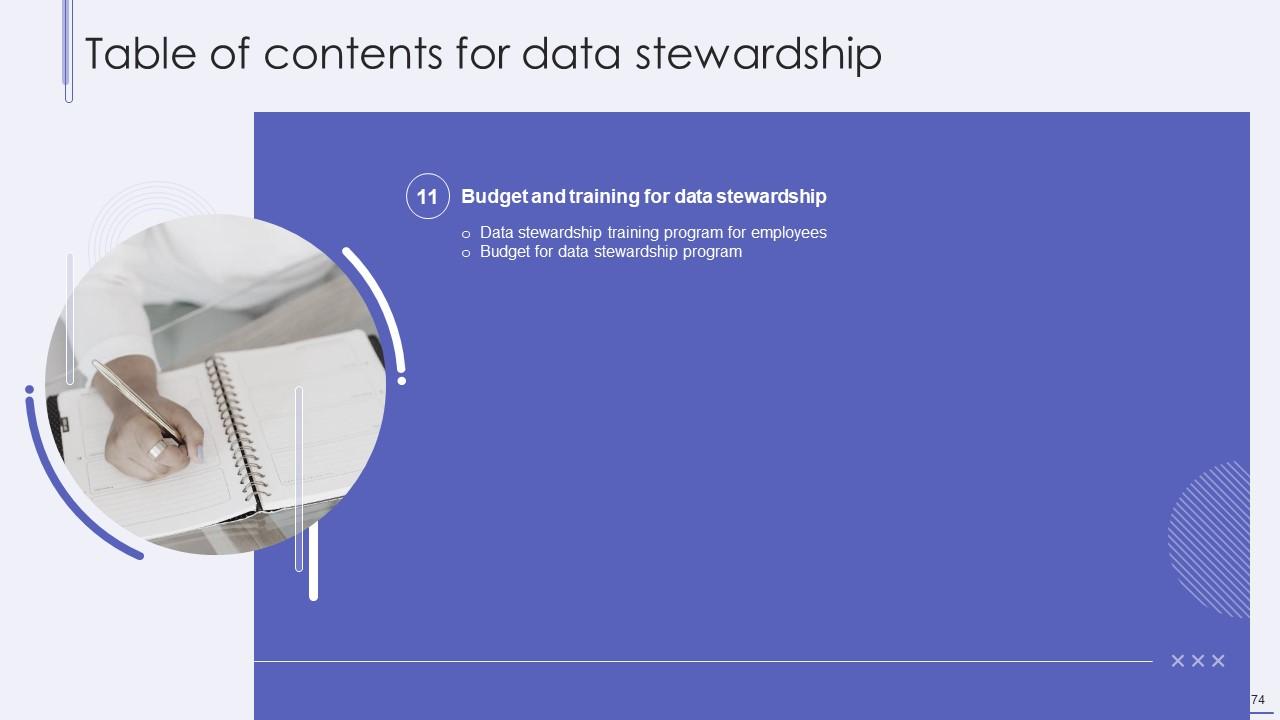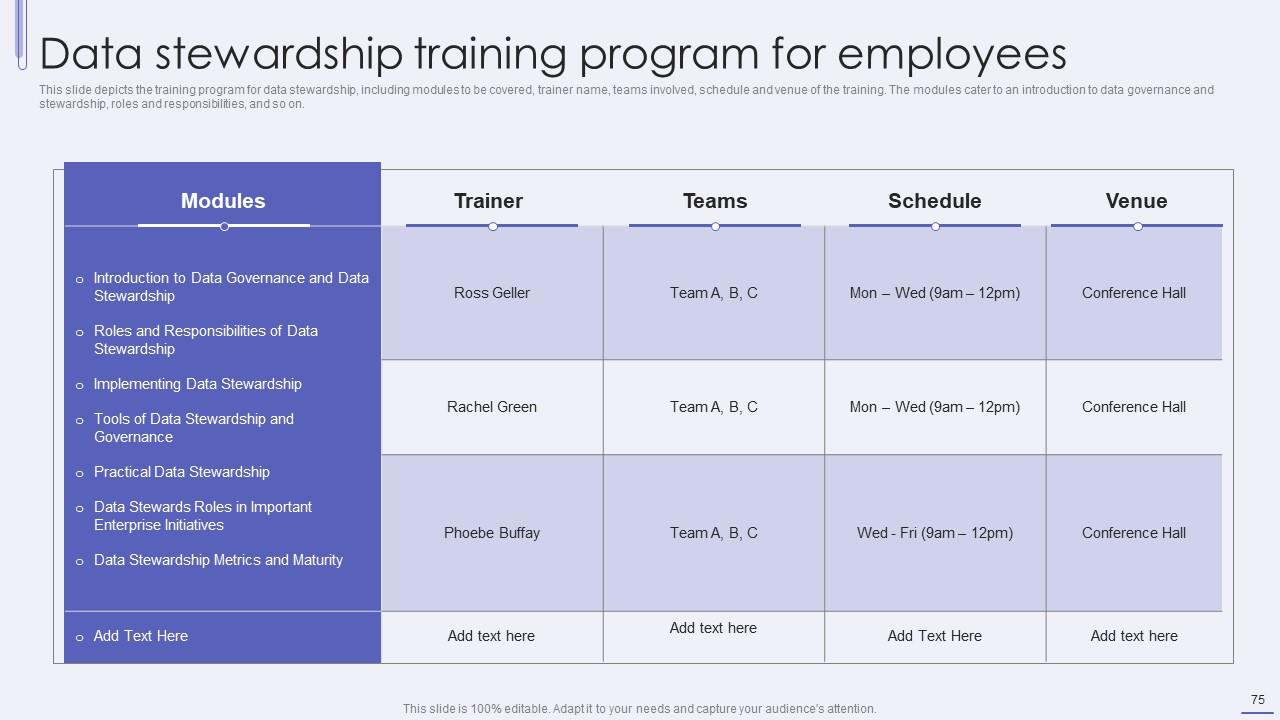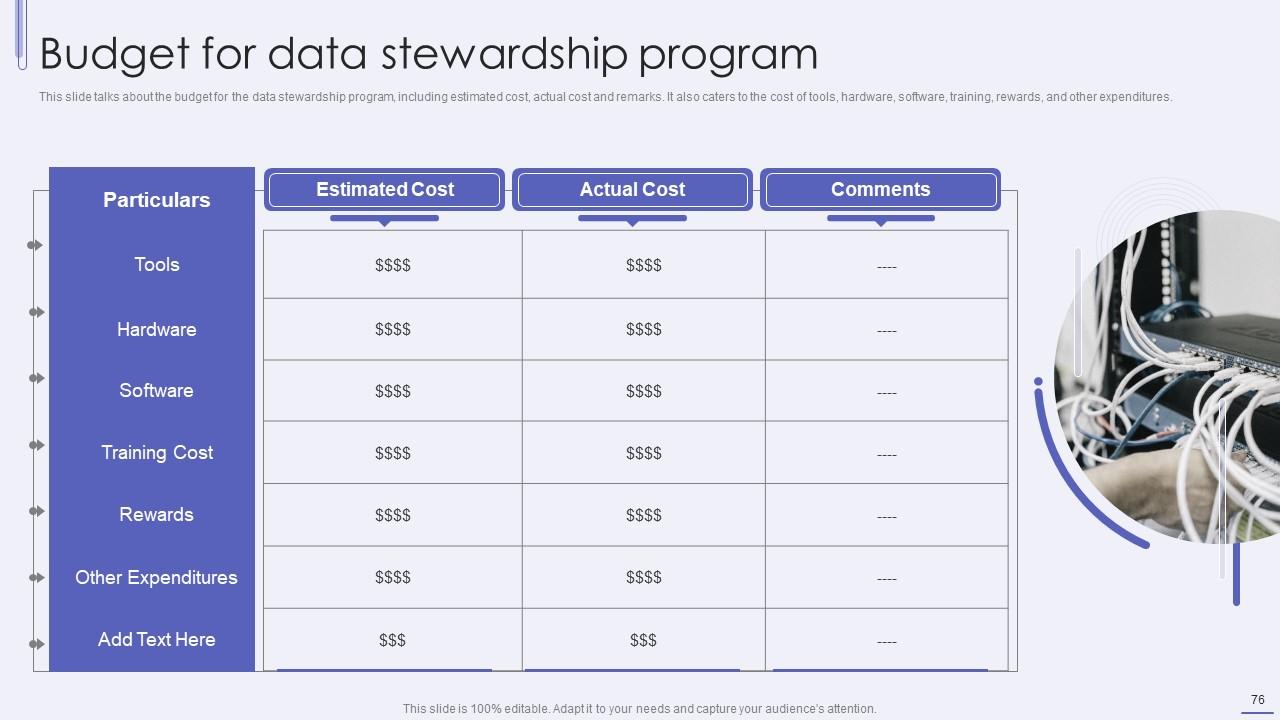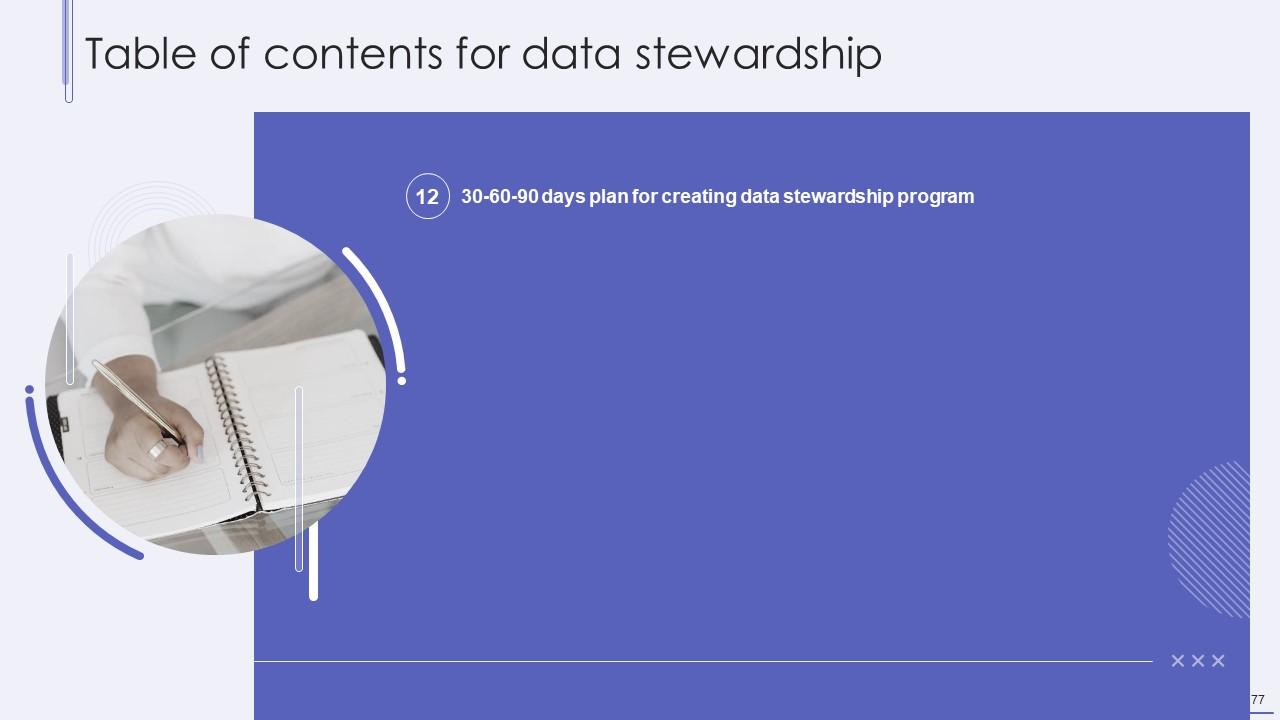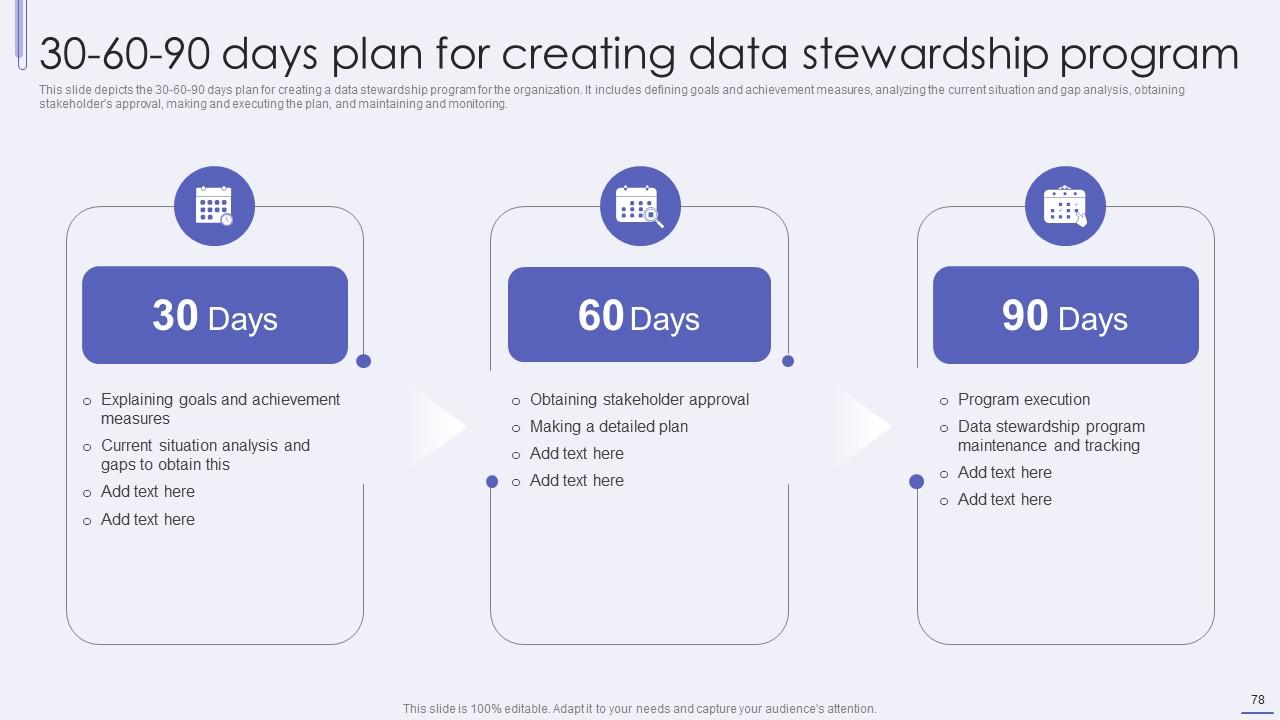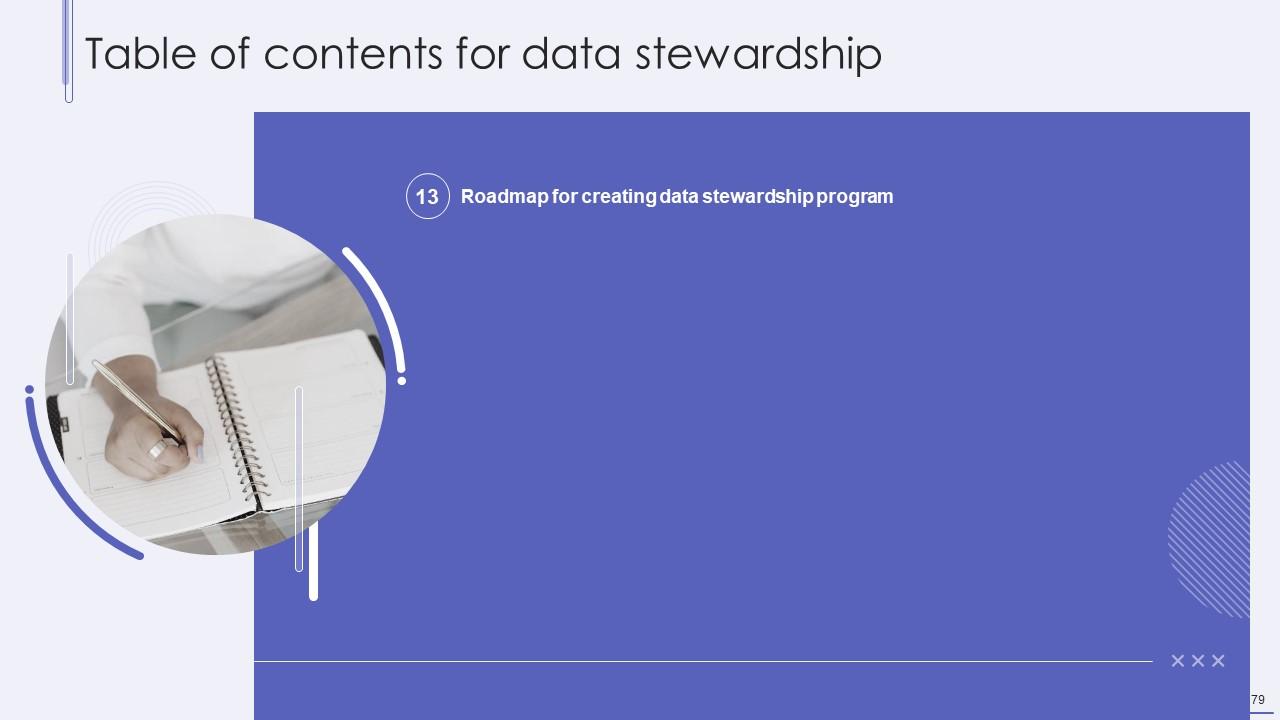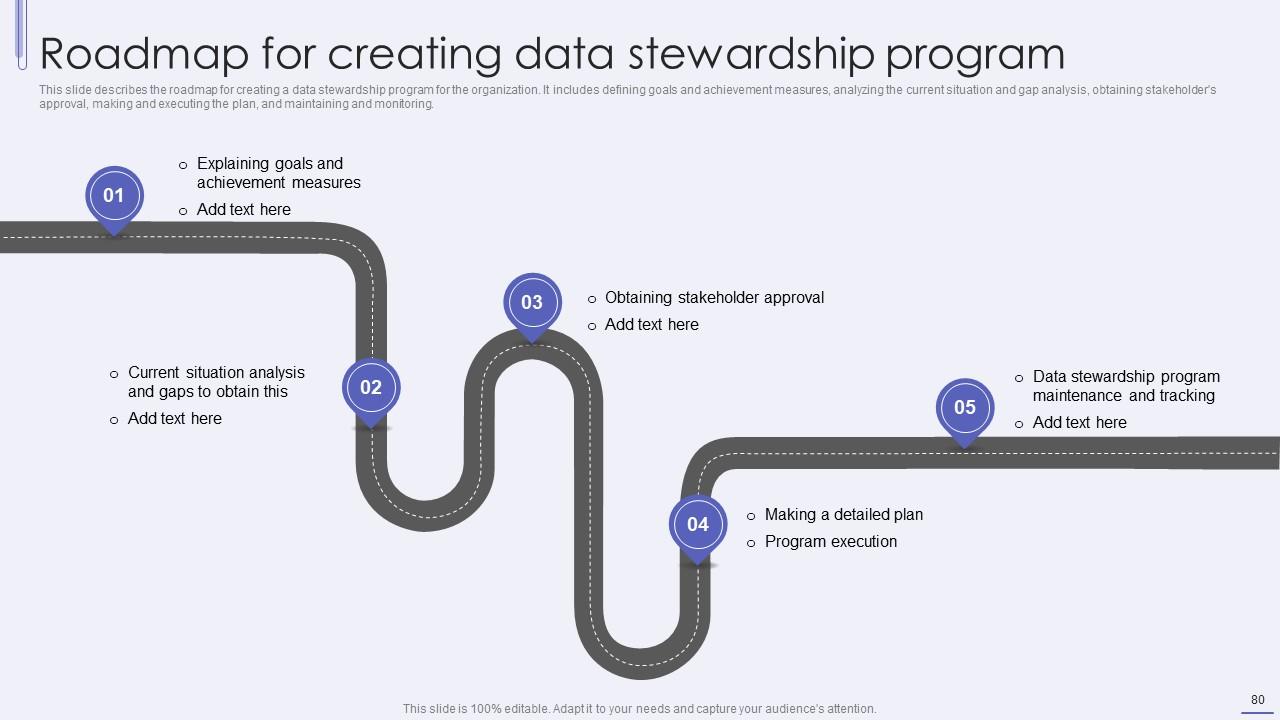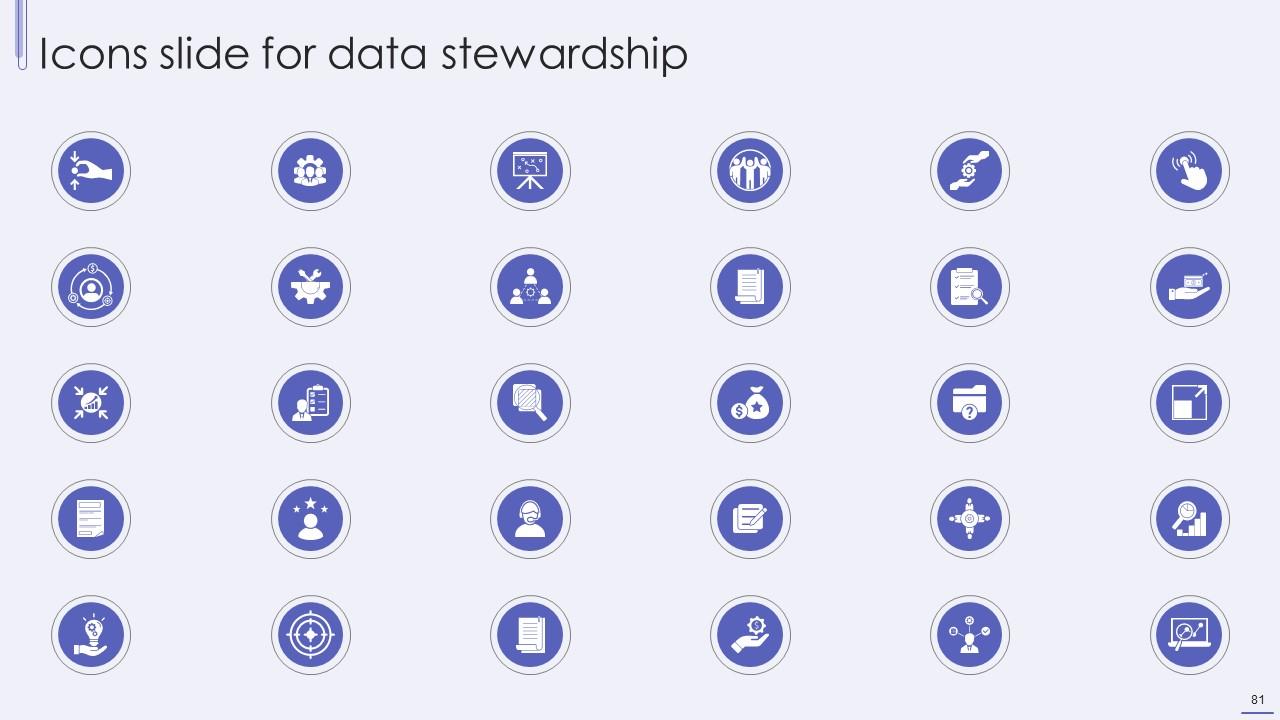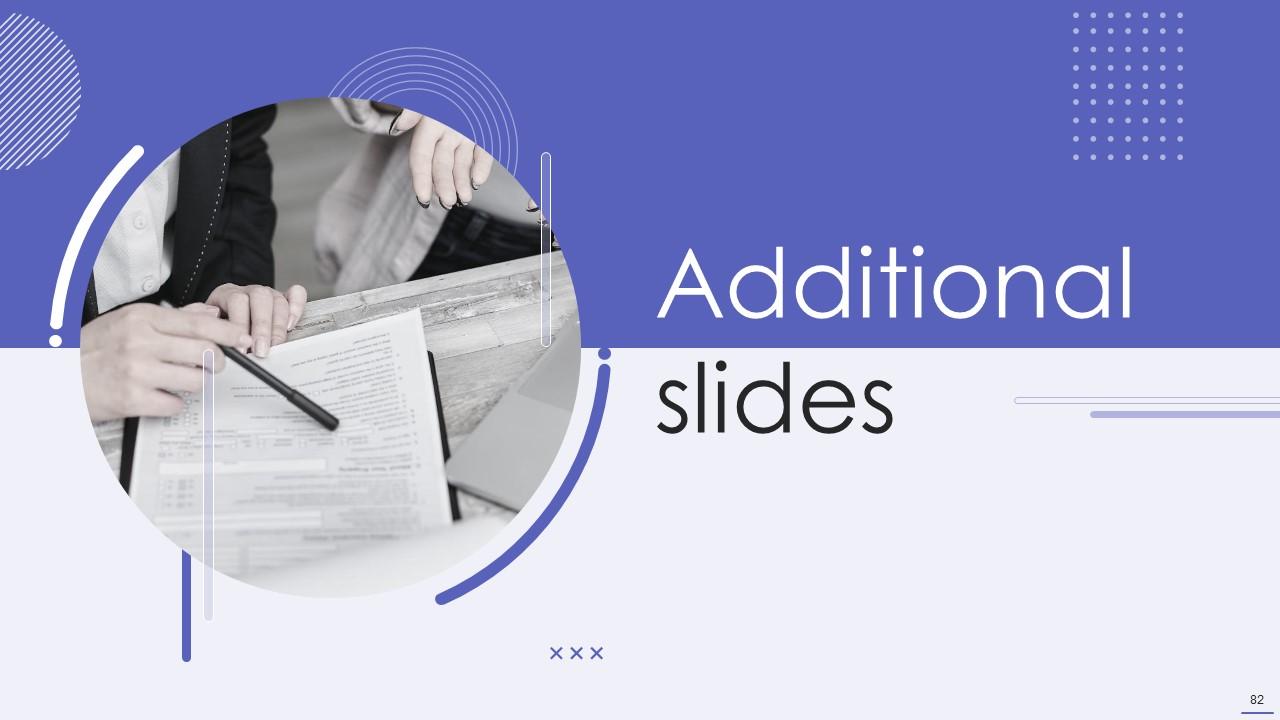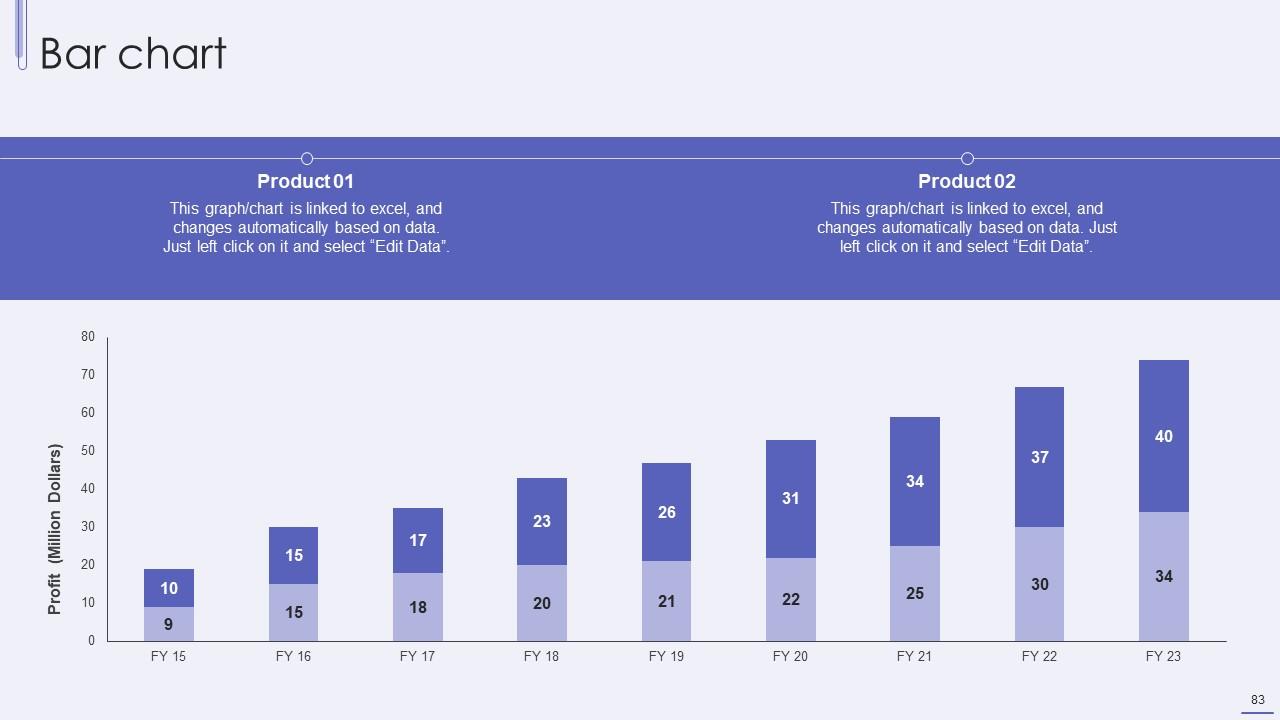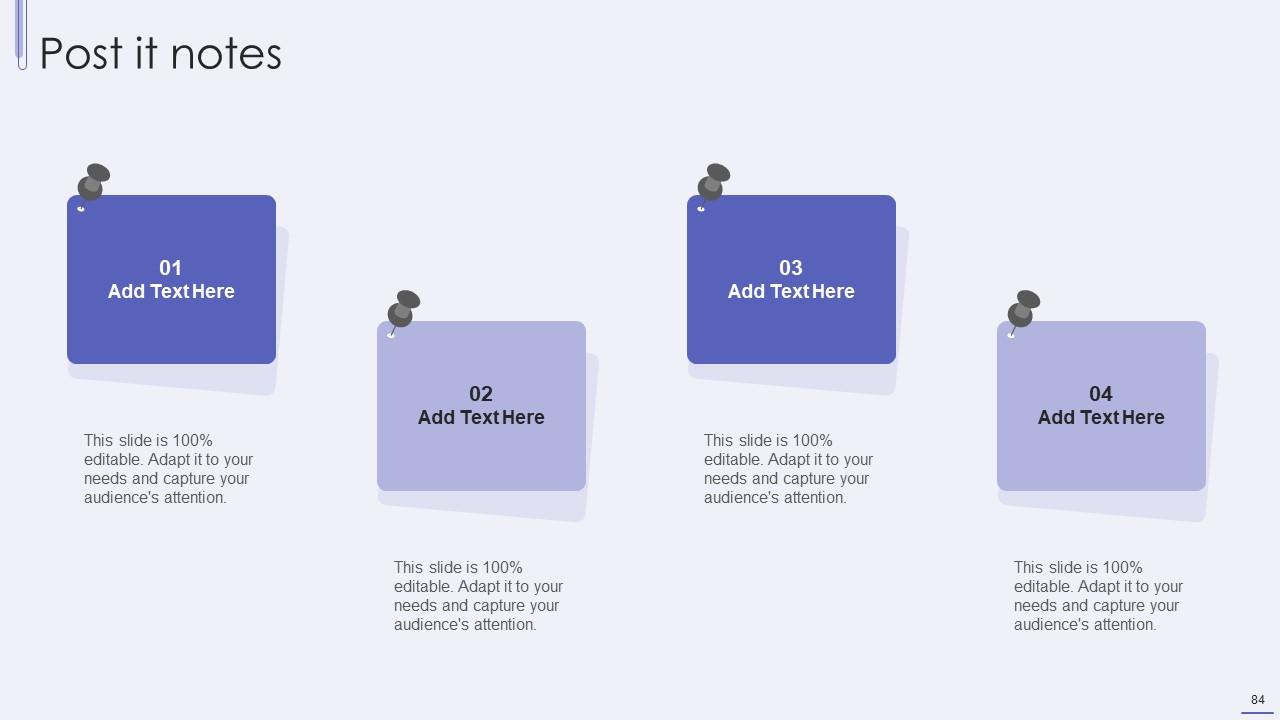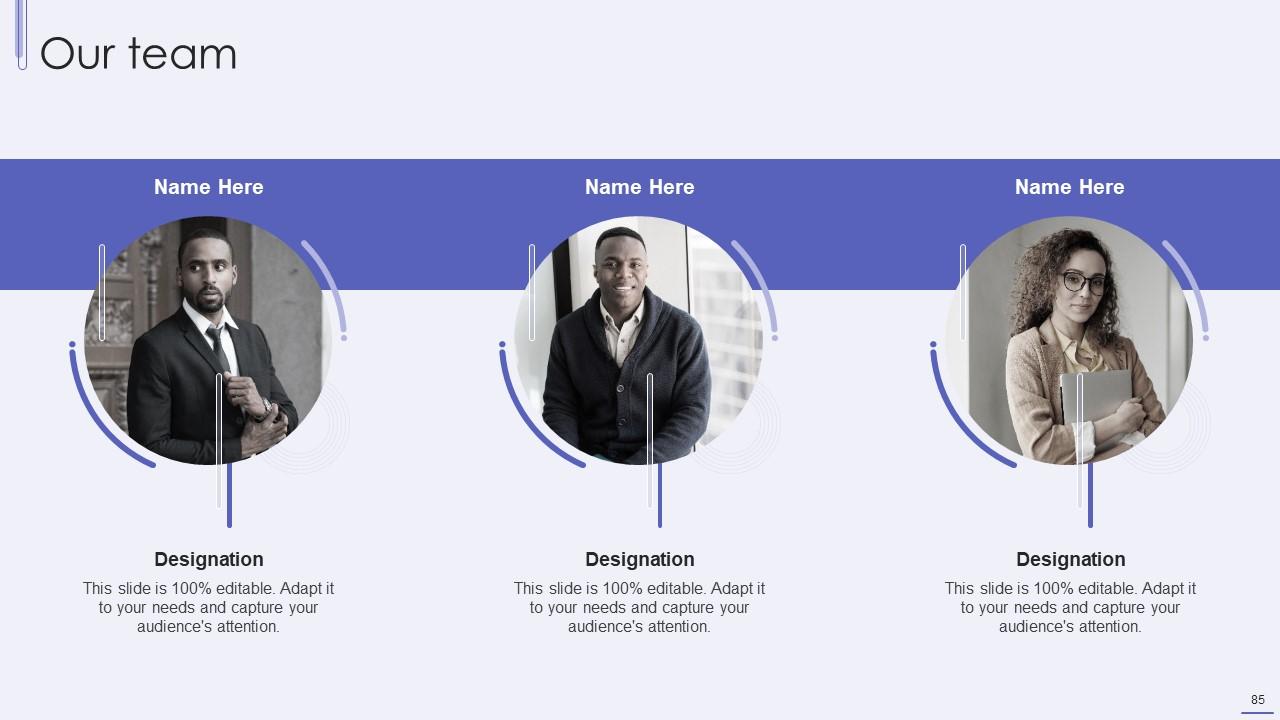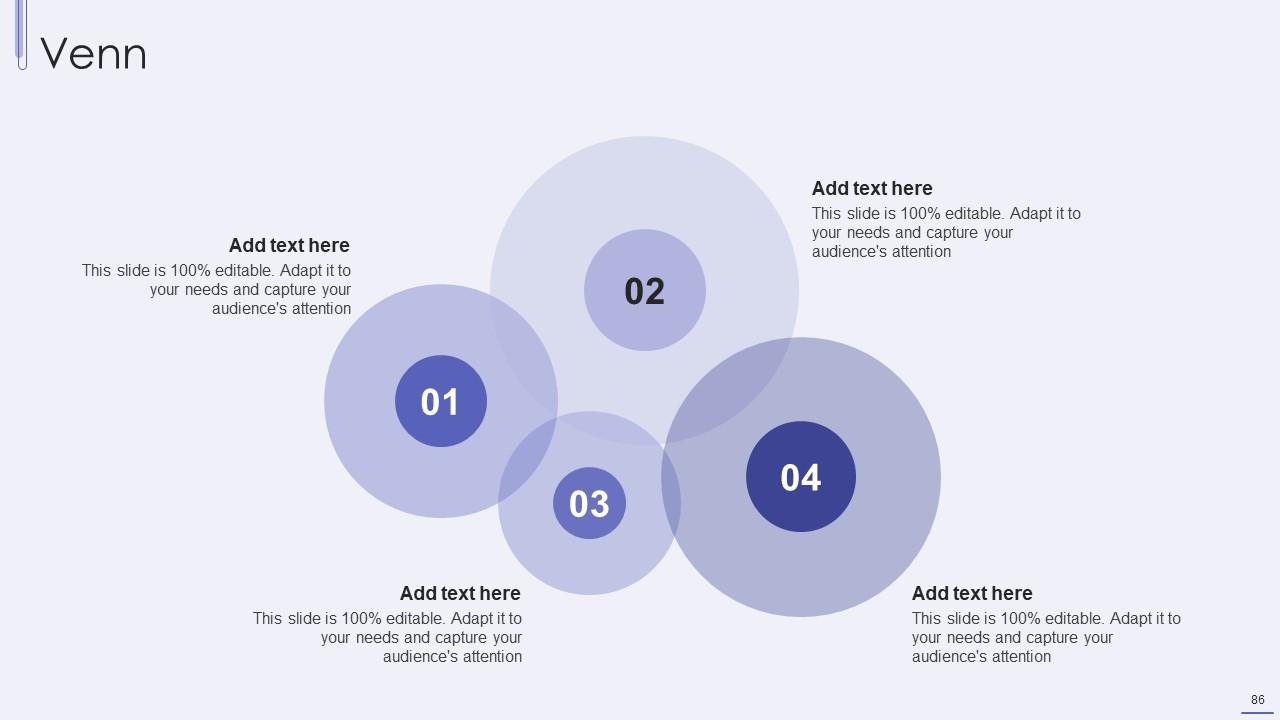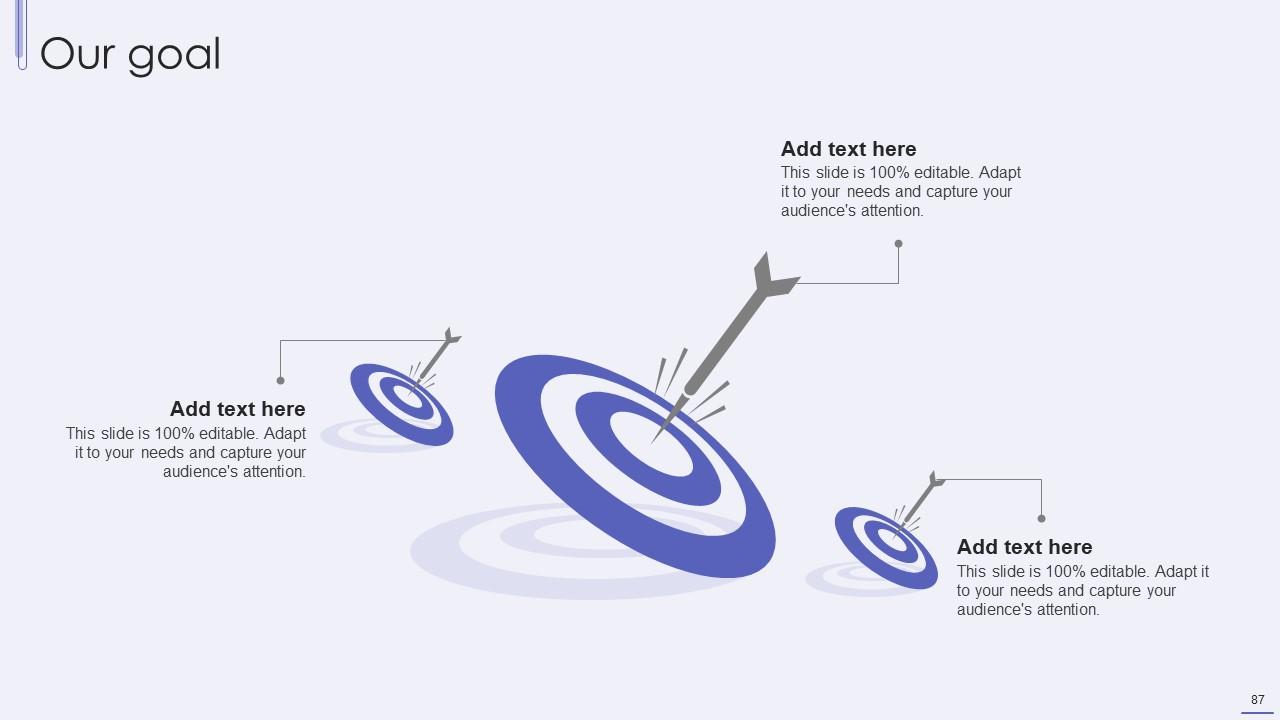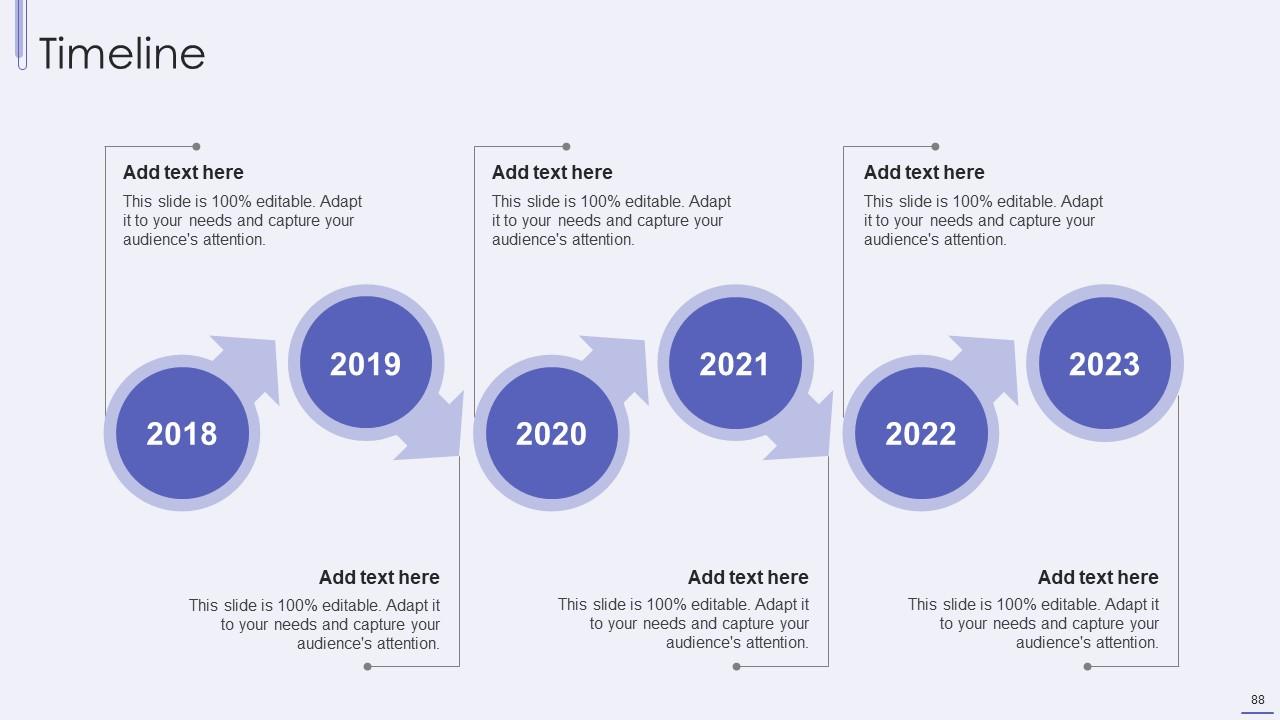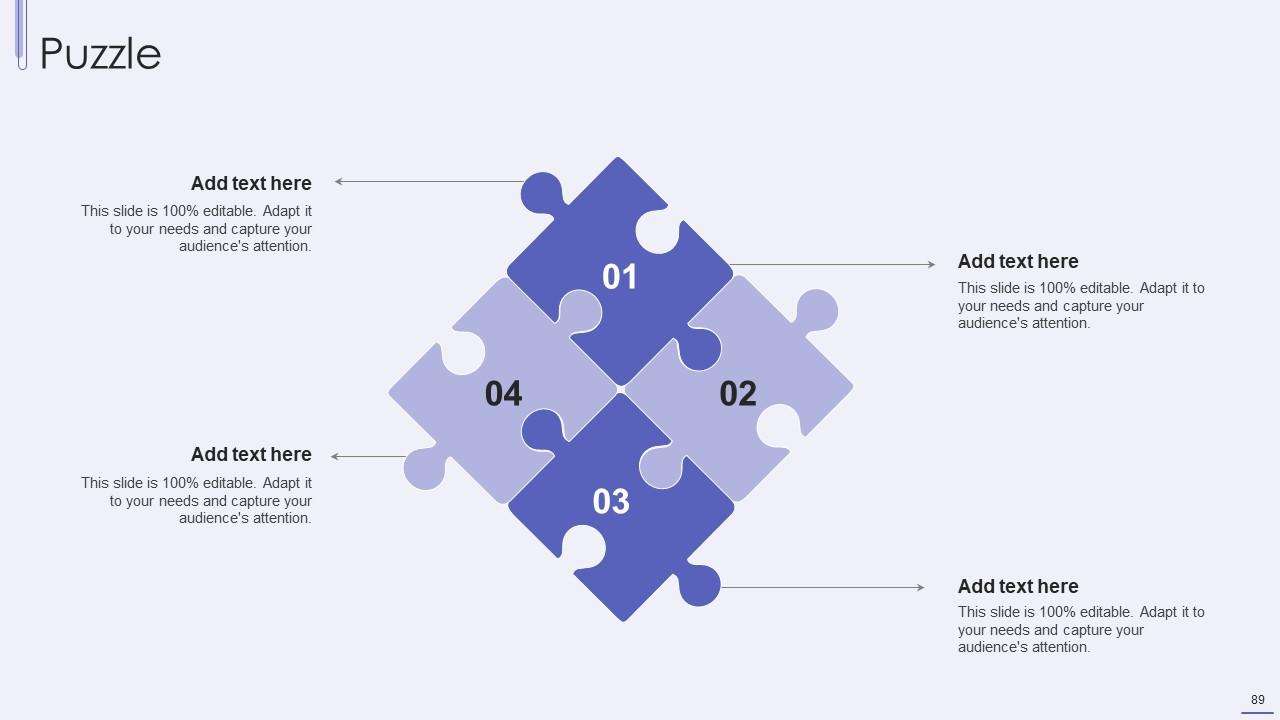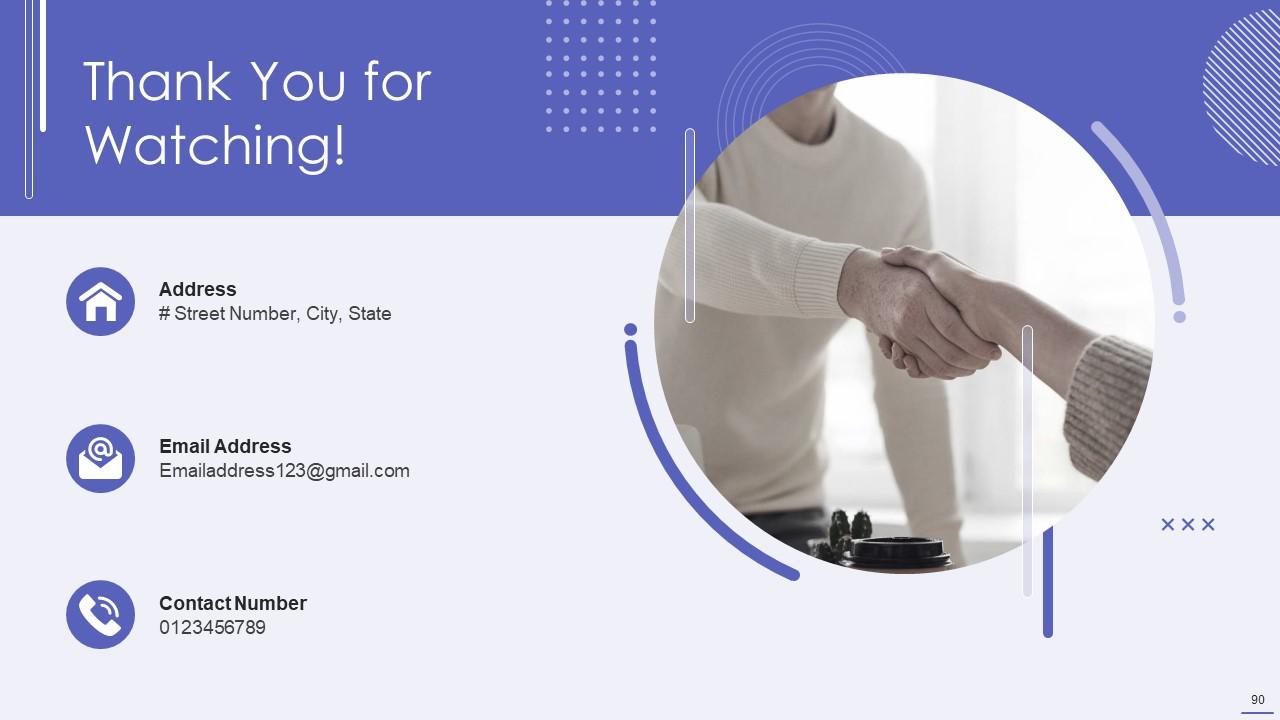Data Stewardship IT Powerpoint Presentation Slides
A data steward manages and coordinates every aspect that affects the quality and validity of data. Grab our insightfully designed Data Stewardship IT template. It briefly explains data stewardship, its importance, methods, different data stewardship models, and much more. Our Data Stewardship deck incorporates the introduction of data stewardship, its goals, life cycle overview, framework and components, and maturity matrix. It also includes its importance, benefits, and uses. Our Data Stewardship Implementation PPT exhibits data stewards qualifications and skills, roles and responsibilities, types, functions, and the RACI matrix. Additionally, it includes the data stewardship models, like the guided data stewardship operating model, data subject area model, stewardship by function model, etc. Further, the template caters to the difference between data steward and owner, data analyst, and data governance and data stewardship. It also contains the use cases of a data stewardship program in different countries and healthcare industries. Lastly, our Stewardship by Business Process Model module showcases the challenges and solutions of data stewardship implementation, budget, and training program, with a 30-60-90 days plan and a roadmap. Get access now.
A data steward manages and coordinates every aspect that affects the quality and validity of data. Grab our insightfully de..
- Google Slides is a new FREE Presentation software from Google.
- All our content is 100% compatible with Google Slides.
- Just download our designs, and upload them to Google Slides and they will work automatically.
- Amaze your audience with SlideTeam and Google Slides.
-
Want Changes to This PPT Slide? Check out our Presentation Design Services
- WideScreen Aspect ratio is becoming a very popular format. When you download this product, the downloaded ZIP will contain this product in both standard and widescreen format.
-

- Some older products that we have may only be in standard format, but they can easily be converted to widescreen.
- To do this, please open the SlideTeam product in Powerpoint, and go to
- Design ( On the top bar) -> Page Setup -> and select "On-screen Show (16:9)” in the drop down for "Slides Sized for".
- The slide or theme will change to widescreen, and all graphics will adjust automatically. You can similarly convert our content to any other desired screen aspect ratio.
Compatible With Google Slides

Get This In WideScreen
You must be logged in to download this presentation.
PowerPoint presentation slides
Enthrall your audience with this Data Stewardship IT Powerpoint Presentation Slides. Increase your presentation threshold by deploying this well-crafted template. It acts as a great communication tool due to its well-researched content. It also contains stylized icons, graphics, visuals etc, which make it an immediate attention-grabber. Comprising ninty slides, this complete deck is all you need to get noticed. All the slides and their content can be altered to suit your unique business setting. Not only that, other components and graphics can also be modified to add personal touches to this prefabricated set.
People who downloaded this PowerPoint presentation also viewed the following :
Content of this Powerpoint Presentation
Slide 1: This slide introduces Data Stewardship (IT). Commence by stating Your Company Name.
Slide 2: This slide depicts the Agenda of the presentation.
Slide 3: This slide incorporates the Table of contents.
Slide 4: This slide highlights the Title for the Topics to be discussed next.
Slide 5: This slide deals with the Data stewardship program introduction and goals.
Slide 6: This slide outlines how data stewardship and governance are interconnected.
Slide 7: This slide talks about the life cycle of a data stewardship program that verifies that all organizational data complies with data governance policies and procedures.
Slide 8: This slide represents the framework of data stewardship, including data stewards, data owners, data users, and data custodians.
Slide 9: This slide depicts the data stewardship maturity matrix process flow that covers regulations & policies, processes, etc.
Slide 10: This slide elucidates the Heading for the Components to be discussed next.
Slide 11: This slide showcases the importance of a data stewardship system, and it includes data discovery, maintaining data quality and trustworthiness, etc.
Slide 12: This slide describes the benefits of a data stewardship program.
Slide 13: This slide continues the Benefits of data stewardship program.
Slide 14: This slide represents the uses of a data stewardship program that includes resolving any data or data-related challenges, decreasing risks by security measures, etc.
Slide 15: This slide reveals the Title for the Ideas to be discussed next.
Slide 16: This slide outlines the overview of data stewards and their tasks that cater to centralizing details about data, verifying data quality, offering metadata, etc.
Slide 17: This slide shows the Qualifications and skills required for a data steward.
Slide 18: This slide represents the role of a data steward in a company.
Slide 19: This slide highlights the Responsibilities of a data steward in stewardship program.
Slide 20: This slide portrays the Primary goals of data stewards in stewardship program.
Slide 21: This slide states the Types of data stewards in stewardship program.
Slide 22: This slide shows the data stewardship replication by domain and data community.
Slide 23: This slide outlines the functions of data stewards within a company.
Slide 24: This slide describes the RACI Matrix for the data stewardship program and includes the roles and responsibilities of various data stewards.
Slide 25: This slide incorporates the Heading for the Ideas to be discussed further.
Slide 26: This slide deals with the Data stewardship platform for stewards.
Slide 27: This slide represents master data management systems' features, including data management, traceability, information quality, etc.
Slide 28: This slide depicts the overview of metadata management and data cataloging that allows extracting more excellent value from functional, technical, and operational data sets.
Slide 29: This slide reveals the back office data stewardship platform.
Slide 30: This slide describes the tools and processes for the data stewardship program covering functions, symptoms, causes and solutions.
Slide 31: This slide mentions the Title for the Components to be discussed in the following template.
Slide 32: This slide focuses on the Guided data stewardship operating model.
Slide 33: This slide indicates the Heading for the Topics to be covered further.
Slide 34: This slide presents the data-subject-area-oriented stewardship model, including its benefits.
Slide 35: This slide describes the data object steward or domain data steward.
Slide 36: This slide depicts the risks associated with the data subject area stewardship model.
Slide 37: This slide indicates the Title for the Ideas to be discussed next.
Slide 38: This slide shows the functional data stewardship model.
Slide 39: This slide talks about the business or functional data steward.
Slide 40: This slide outlines the benefits of the organizational data stewardship model.
Slide 41: This slide showcases the risks associated with an organizational data model.
Slide 42: This slide represents the Heading for the Ideas to be covered further.
Slide 43: This slide describes the data stewardship by business process model.
Slide 44: This slide presents the overview of a process data steward who manages all the data within a single business operation.
Slide 45: This slide exhibits the benefits of the process-oriented data stewardship model.
Slide 46: This slide talks about the risks associated with the process-oriented data stewardship model.
Slide 47: This slide portrays the Title for the Contents to be discussed in the forth-coming template.
Slide 48: This slide depicts the data stewardship by systems model that assigns a data steward to information-generated systems.
Slide 49: This slide represents the system data steward, also known as technical data stewardship.
Slide 50: This slide describes the benefits of a system-oriented data stewardship model.
Slide 51: This slide represents the risks associated with the system-oriented data stewardship model.
Slide 52: This slide elucidates the Heading for the Topics to be covered further.
Slide 53: This slide talks about the data steward by project model.
Slide 54: This slide outlines the advantages of the project-oriented data stewardship model.
Slide 55: This slide mentions the risks associated with a project-oriented stewardship model.
Slide 56: This slide elucidates the Title for the Ideas to be discussed next.
Slide 57: This slide describes the comparison between data stewards and data owners.
Slide 58: This slide represents the difference between data stewards and data analysts.
Slide 59: This slide showcases the comparison between data governance and data stewardship.
Slide 60: This slide exhibits the Heading for the Ideas to be covered in the upcoming template.
Slide 61: This slide presents the use cases of data stewardship programs in countries like Canada, New Zealand, Finland, and Switzerland.
Slide 62: This slide depicts the Title for the Topics to be discussed further.
Slide 63: This slide displays the overview of data stewardship in the healthcare industry.
Slide 64: This slide portrays the Heading for the Contents to be covered in the following template.
Slide 65: This slide describes the process of data stewardship program for a new program or evaluation of the existing one.
Slide 66: This slide represents creating a data steward network in which existing and aspiring data stewards collaborate to create strategies.
Slide 67: This slide depicts the best practices for a data stewardship program.
Slide 68: This slide exhibits the principles for the success of a data stewardship program and it includes being accountable, strategic, collaborative, etc.
Slide 69: This slide mentions the Title for the Components to be discussed further.
Slide 70: This slide describes the problems with enterprise information, including data utilization by many users for several purposes, errors and distortion of information.
Slide 71: This slide represents the challenges experienced by modern data stewards.
Slide 72: This slide elucidates the challenges in the success of data stewardship deployment, including corporate culture, muddled measures and responsibilities, etc.
Slide 73: This slide displays the solutions to overcome the challenges for a successful data stewardship program.
Slide 74: This slide incorporates the Heading for the Topics to be covered in the forth-coming template.
Slide 75: This slide addresses the Data stewardship training program for employees.
Slide 76: This slide talks about the budget for the data stewardship program, including estimated cost, actual cost and remarks.
Slide 77: This slide reveals the Title for the Ideas to be discussed further.
Slide 78: This slide shows the 30-60-90 days plan for creating a data stewardship program for the organization.
Slide 79: This slide mentions the Heading for the Ideas to be covered next.
Slide 80: This slide describes the roadmap for creating a data stewardship program for the organization.
Slide 81: This is the Icons slide containing all the Icons used in the plan.
Slide 82: This slide highlights the Additional information.
Slide 83: This slide illustrates the Bar chart.
Slide 84: This slide contains the Post it notes for reminders and deadlines.
Slide 85: This is Our team slide for stating the information related to your team members.
Slide 86: This is the Venn Diagram slide.
Slide 87: This is Our goal slide. State your organizational goals here.
Slide 88: This slide reveals the Timeline of the firm.
Slide 89: This is the Puzzle slide with related imagery.
Slide 90: This is the Thank You slide for acknowledgement.
Data Stewardship IT Powerpoint Presentation Slides with all 95 slides:
Use our Data Stewardship IT Powerpoint Presentation Slides to effectively help you save your valuable time. They are readymade to fit into any presentation structure.
FAQs
A data stewardship program is a set of processes and policies designed to ensure that all organizational data complies with data governance policies and procedures. The program aims to establish and maintain data quality, trustworthiness, and security while also centralizing details about data, offering metadata, and resolving data-related challenges.
The framework of data stewardship includes four key players: data stewards, data owners, data users, and data custodians. Data stewards are responsible for centralizing details about data, ensuring data quality, offering metadata, and resolving data-related challenges. Data owners have ultimate responsibility for data within their domain. Data users are those who use the data, while data custodians are responsible for the safekeeping and management of data.
The data stewardship maturity matrix process flow covers regulations & policies, processes, etc., and it helps organizations measure the maturity level of their data stewardship program. The process flow includes five stages: Initial, Managed, Defined, Measured, and Optimized. Each stage has specific goals and objectives that an organization must meet to advance to the next stage.
The qualifications and skills required for a data steward include strong analytical skills, excellent communication and interpersonal skills, knowledge of data management principles and practices, familiarity with metadata and data modeling, and an understanding of relevant regulatory frameworks.
A data stewardship program can benefit an organization in several ways, including improved data quality, better decision-making, increased efficiency, reduced risk, and better compliance with regulations. It can also help organizations to understand their data better, streamline their data-related processes, and ensure that data is accurate, complete, and trustworthy.
-
Eye-catching PPT designs, outstanding team, and best customer service. I’m a super satisfied customer here!
-
Easy to use and customize templates. Helped me give a last minute presentation.


